Doulton potters 7



Every collector should know about
Counter Intelligence
Why collectors are snapping up antique shop ttings




Doulton potters 7



Every collector should know about
Counter Intelligence
Why collectors are snapping up antique shop ttings



From furniture to mugs we put centuries of royal commemorative ware in the spotlight
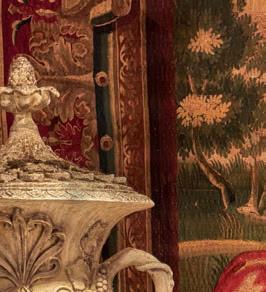
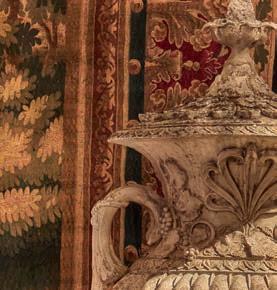
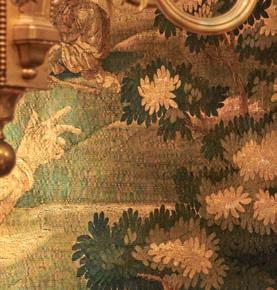
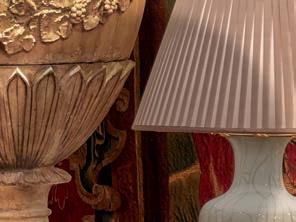


At the time of writing, I can’t say excitement for this month’s coronation is exactly fever pitch. Even my local Poundland, generally a ne barometer of the national mood towards festivities, is yet to stock any bunting. us far I have no street parties in the o ng, or invites to drinks parties.
But I do think Brits take some warming up when it comes to communal expressions of joy, so I hope to stand corrected. On a personal note I am indebted to Charles III as I was once invited on a tour of his Highgrove grounds with his head gardener (I was editing a gardening magazine at the time). I hope I am not disclosing any state secrets when I say he takes his compost heap very seriously. So for this, and other reasons, let us all raise a glass on May 6.
How many of us will be buying commemorative ware to mark the occasion remains to be seen and it is for future generations to decide how much of it becomes the antiques of the future. On page 50 antiques valuer Edward Rycroft takes us on a whistlestop tour of royal coronation ware across the ages. As a collecting genre it has long since shrugged o its “Hyacinth Bucket” connotations and is now enjoying a well-deserved renaissance in the saleroom.
We continue the royal theme on page 18 when Stephanie Connell charts the history and collectability of coronation furniture. For centuries peers were given the opportunity to buy the chairs they sat on in Westminster Abbey at coronations (peeresses got stools) and they are now highly sought after. In further patriotic mood, on page 34, Charles Hanson presents for sale an embroidered sample from the design of Elizabeth II’s coronation robe, along with handwritten notes from its maker Norman Hartnell.
On page 30 we take a look at weddings (some of them royal) in the 15th and 16th centuries, with much surrounding the nuptials to attract the collector, from gimmel rings to majolica. Closer to home, the art pottery of Lambert Doulton is put in the spotlight on page 24. If you don’t know the work of Doulton’s early potters – the majority of whom were women – you should take a look ahead of a large sale in Essex. Elsewhere David Harvey puts a Chippendale-period chest under the microscope and, on page 36, book specialist Adam Douglas reveals why we should all take note of the 400th-anniversary of Shakespeare’s First Folio. Enjoy the issue.
Georgina Wroe, Editor

PS A quick reminder that because the June and July magazine is a joint issue it will be with you later than usual. Expect delivery from the second week in June.
Write to us at Antique Collecting, Riverside House Dock Lane, Woodbridge, Suffolk, IP12 1PE, or email magazine@accartbooks.com. Visit the website at www.antique-collecting.co.uk and follow us on Twitter and Instagram @AntiqueMag
Antique Collecting subscription
£38 for 10 issues annually, no refund is available.
ISSN: 0003-584X

is signed letter from Charles III and Queen Camilla thanking the recipient for his help at their wedding in 2005. It has an estimate of £700 £900 at Chiswick Auction’s royal sale on May 31.
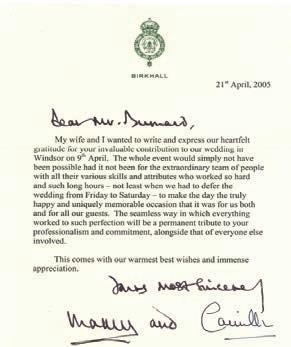
CHARLES HANSON showcases a very special royal textile, page 34
ADAM DOUGLAS reveals everything you to know about Shakespeare’s First Folio, page 36
Editor: Georgina Wroe, georgina. wroe@accartbooks.com
Online Editor: Richard Ginger, richard.ginger@accartbooks.com



Design: Philp Design, james@philpdesign.co.uk
Advertising and subscriptions: Charlotte Kettell 01394 389969, charlotte.kettell @accartbooks.com

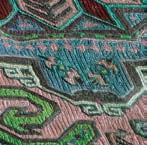

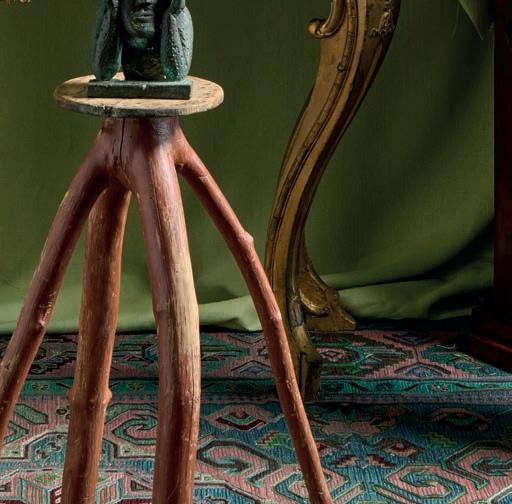
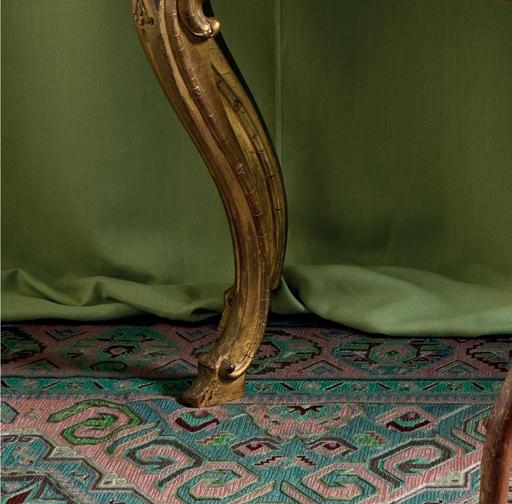
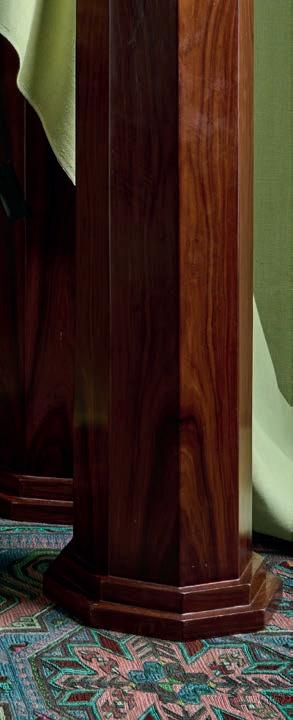
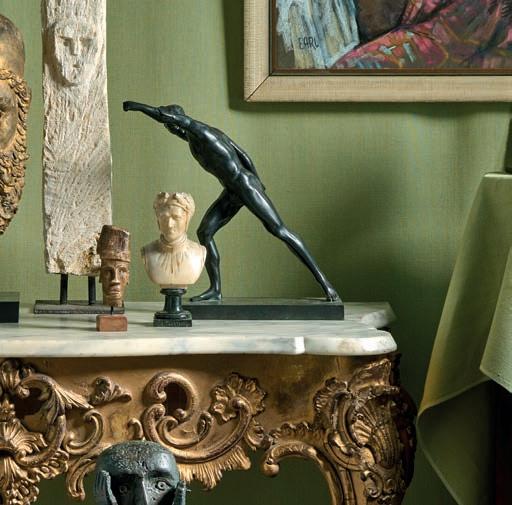
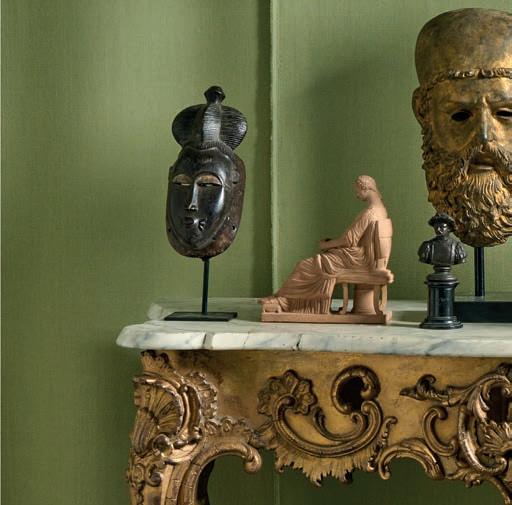
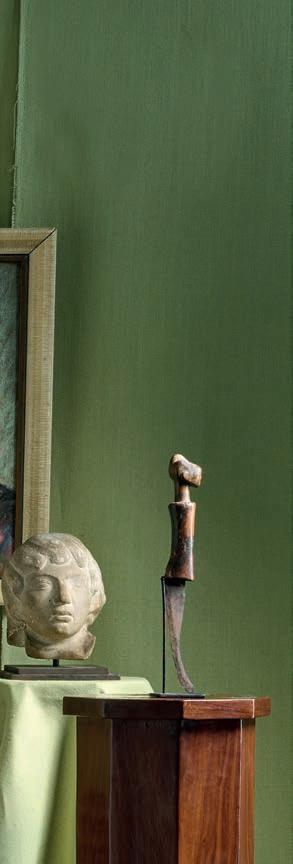
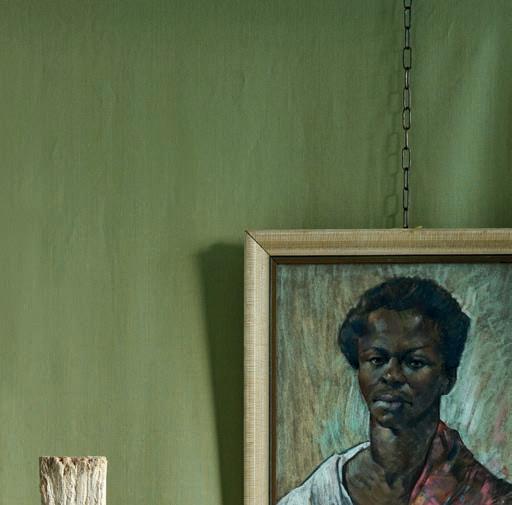

BATTERSEA PARK LONDON
SPRING
9-14 MAY 2023
COVER
Inside the legendary King’s Road antiques shop Guinevere, image courtesy of Dreweatts, see the feature on page 28
3 Editor’s Welcome: Georgina Wroe introduces the issue with a special coronation theme

6 Antique News: What the month of May has in store for antique collectors and ne art lovers

10 Your Letters: A plea for information about a mystery candlestick and memories of a fair set to close down
12 Around the Houses: A 2007 iPhone creates a storm in the US while the bowl that ceramicist Lucie Rie gave to her cleaner fetches thousands
16 Waxing Lyrical: David Harvey is enchanted by a Chippendale-period chest with all the hallmarks of being by the nest of makers
23 Subscription O er: Save more than a third on the annual price and receive a book worth £75 free of charge
28 Saleroom Spotlight: Behind the scenes at the part contents sale of a legendary King’s Road antiques shop celebrating 60 years in the business

34 An Auctioneer’s Lot: Charles Hanson comes across a charming textile fragment, one of the designs used on Elizabeth II’s coronation gown
48 Puzzle Pages: Complete Peter WadeWright’s endish crossword and win a book on silver hallmarks

53 Coronation Spotlight: A look at the best of the royal interest pieces on o er this month
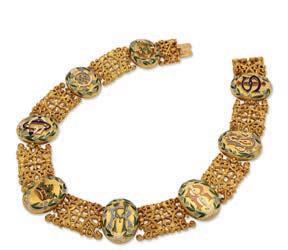
Top of the Lots: We dip into the world of contemporary Chinese ink paintings with an auction taking place this month
Book O ers: Put your feet up with a good read and save more than a third on the latest titles from our sister publisher ACC Art Books
58 Fair News: Details of one of the capital’s most popular events, plus a behind-the-scenes look at a prestigious fair in West Sussex
59 Fairs Calendar: Discover all the best events taking place in May
60 Auction Calendar: Never miss another auction with our up-to-date guide to the UK’s salerooms
66 Marc My Words: Antiques Roadshow expert Marc Allum reports on a recent trip to New Zealand
18 Coronation Seat: Stephanie Connell’s essential low-down on coronation furniture through the ages and the most collectable designs
24 Lambeth Way: Art pottery by Doulton Lambeth presents many designs for collectors. Antique Collecting reports
30 Love is in the Heir: Important marriages in the 15th century were more about political alliances than love, Lucy Whitaker lifts the lid
38 Birthday Bard: On the 400thanniversary of Shakespeare’s First Folio, Adam Douglas reveals what the book means for collectors
40 Counter Intelligence: As retail goes increasingly online, the demand for antique shop ttings has never been greater. Dealers reveal the makers to look for
44 Life in Colour: e career and work of the pioneering photographer Madame Yevonde is put in focus by Maudji Mendel
50 Crowning Glories: Edward Rycroft looks back on generations of royal commemorative ware and the most sought-after designs

Ranging from baubles to teapots, the country’s leading retailers have launched a number of lines to mark this month’s coronation of Charles III on May 6 – some of which may become the collectables of the future.
Highgrove Gardens is o ering a range of Emma Bridgewater ceramics titled 3 Cheers for King Charles featuring the date of the coronation and a wrap-around crown design. e range is made at the Emma Bridgewater factory in Stoke-on-Trent from cream-coloured English earthenware sourced from clay in Devon, Cornwall and Wales. Meanwhile, Fortnum & Mason’s range includes a musical tin that plays God Save e King as it spins.
Collectors can also make the most of a number of events to commemorate the event. Nicholas Merchant, in conjunction with BADA Friends, will present a zoom lecture called Crown Jewels Dynastic Jewels on May 3. e talk will explore how some of the most fabled gems in the world have been used to decorate the British Crown jewels.
Two crowns feature in coronations: St Edward’s Crown, named after St Edward the Confessor, placed on the monarch’s head during the crowning and the Imperial State Crown worn to process out of the abbey. Tickets are £10, to order email anne@bada.org
A Victorian gold collar with links to an influential family dynasty has appeared on the open market for the first time in its history.
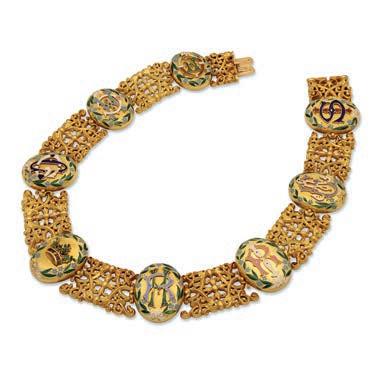
Hancocks London is selling the Spencer-Churchill necklace, comprised of eight 18 carat gold panels, which was commissioned in 1875 by John SpencerChurchill, the 7th Duke of Marlborough, for his wife Frances. The collar includes the initials of seven of their 11 children with the eighth locket displaying a ducal coronet set with tiny gems.
Frances was a childhood friend of Queen Victoria as well as being the goddaughter of the Duke of Wellington. She later became the grandmother of Winston Churchill.
Hancock London’s, managing director, Guy Burton, said: “From sentimental gift to a historic jewel – this is the story of a family necklace and the famous people it connects. It’s an utterly unique piece of jewellery.” The Spencer-Churchill necklace is on sale for £125,000.
Above right e necklace has appeared on the open market for the rst time with a price tag of £125,000
Above Fortnum & Mason’s coronation collection has been inspired by centuries of royal pageants
Right Sir Joshua Reynolds (1723-1792) Studio Experiments in Colour and Media © Royal Academy of Arts, London; photographer Prudence Cuming Association
Below right Petworth House © National Trust Images, John Miller

Below Fortnum & Mason’s coronation range includes a musical biscuit tin
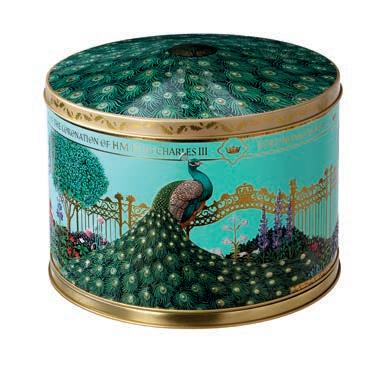
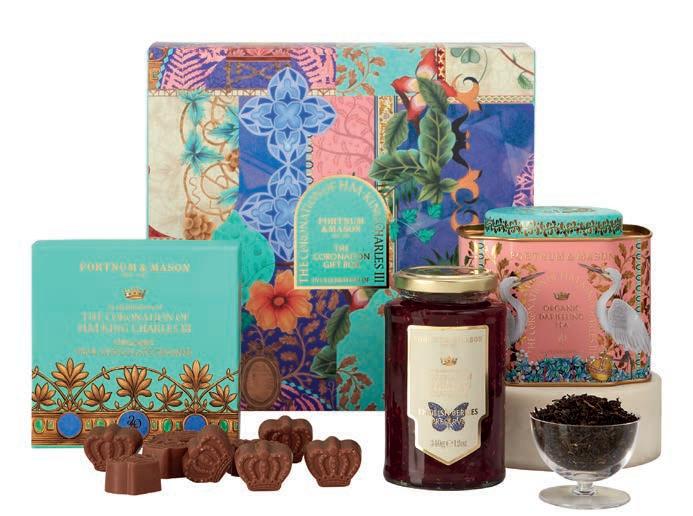
An exhibition showcasing paintings from the Royal Academy continues at Petworth House in West Sussex. Explorations in Paint presents work by nine current and recent Royal Academicians, including Sir Joshua Reynolds (1723-1792), the founder of the RA, with 2023 marking the 300th anniversary of the artist’s birth.
Petworth House houses one of the National Trust’s finest art collections, it also plays host to this month’s Petworth Park Antiques and Fine Art Fair from May 19-21, for more details see page 8. The exhibition continues until September 24.
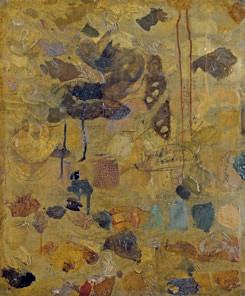
e darker side of the Su olk artist John Constable (1776-1837) is explored in a new exhibition opening in Hampshire this month.
John Constable: e Dark Side, on at e Arc in Winchester from May 26 to August 16, considers the artist’s obsession with the chiaroscuro of nature – the contrast between light and dark – and how he used it in his landscapes.
Known for his bucolic 1821 painting, e Hay Wain, the Su olk artist was, in reality, plagued with anxiety: his wife, Maria, died from tuberculosis aged 41 leaving him in sole charge of seven children aged between 11 years and 11 months. Concerns about their health, happiness and education dominated the later part of his life.
Right Anne Redpath (1896-1965) e Pink Table, 1948. Courtesy the Fleming Collection © e Artist’s Estate
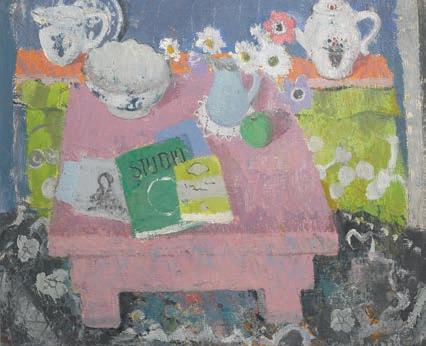
Below right Anne Redpath (1896-1965) Still Life - e Orange Chair, c.1944. Courtesy the Fleming Collection © e Artist’s Estate

Below far right Anne Redpath (1896-1965) Window in Menton, 1948. Courtesy the Fleming Collection © e Artist’s Estate. All Rights Reserved 2019/ Bridgeman Images.
Pallant House Gallery in Chichester, West Sussex this month unveils the rst major exhibition of the artist Gwen John (1876–1939) in 20 years. Running 13 May to October 8, Gwen John: Art and Life in London and Paris brings together more than 120 works, as well as previously unseen archival material and personal belongings of the artist.
e exhibition traces John’s 40-year career, from her early years in the late 1890s at the Slade School of Fine Art in London to her training under James Abbott McNeill Whistler at the Académie Carmen in Paris, the city she moved to in 1904.
e exhibition will also explore the relationship of her work to that of her brother, Augustus John, and Auguste Rodin – with whom she had a 10-year a air.
Above left John Constable (1776-1837) Weymouth Bay, 1816 © Victoria and Albert Museum, London.
Left John Constable (1776-1837) Rainstorm over the Sea, c. 1824-1828 © Royal Academy of Arts, London; photographer: John Hammond


Below Gwen John [18761939) Dorelia in a Black Dress, c.1903-1904, oil on canvas, Tate

Below right Gwen John [1876-1939) Landscape at Tenby with Figures, c.1896-1897, oil on board, Tenby Museum and Art Gallery Collection
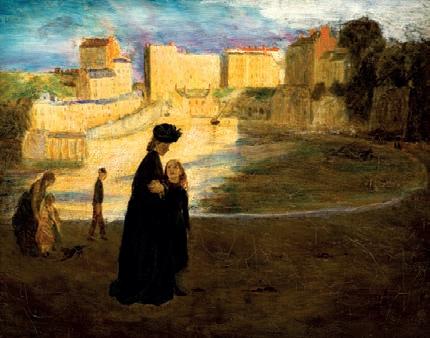
Below far right Gwen John [1876-1939) Autoportrait à la Lettre, (Self-Portrait with a letter), c.1907-1909, pencil and watercolour, Musée Rodin
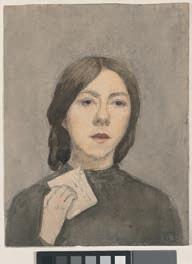
A Northumberland gallery this month hosts an exhibition on the life and art of Anne Redpath (1896-1965) one of Scotland’s nest mid-20th century artists.
e exhibition, Anne Redpath and her Circle at the Maltings, Berwick-upon-Tweed, from May 20 to October 8, is the rst dedicated UK show of her work in 15 years.

Redpath’s formative years were spent in Edinburgh and the south of France where she painted alongside the well-known Scottish Colourists Samuel Peploe and Leslie Hunter.
Returning to the Scottish Borders in 1934, a single mother of three children, and penniless, she moved to Edinburgh in 1949, becoming an important standard bearer for the group which is now known as the Edinburgh School.
A painting by the wartime leader Winston Churchill (1874-1965) of a Kent castle has gone on show at the building which inspired it.
Dating from the 1930s, the oil painting, View through an Arch at Hever shows the Italian Garden at Hever Castle at the time it was owned by Churchill’s close friends Lady Violet Astor and her husband.
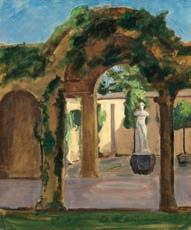
Churchill regularly visited Hever Castle, the childhood home of Anne Boleyn, from his nearby home, Chartwell.
The painting was unveiled by the current Lord and Lady Astor on March 29 and can be seen in the castle’s inner hall. The 13th-century moated castle is in Hever near Edenbridge.
e National Portrait Gallery has been granted an extension to come up with the remaining cash to save Joshua Reynold’s 7ft
Portrait of Omai.

A temporary export bar imposed on the 18th-century painting in March 2022 expired earlier this month but the government has granted an extension to give the gallery time to raise a further £25m
e Museum of London Docklands unveils a free exhibition this month exploring the little-known history of Indian indenture in the British Caribbean.
Following the Slavery Abolition Act of 1833, British planters in the Caribbean devised a new scheme to source cheap labour by recruiting workers from India in return for transport, a minimal wage and some basic provisions. With the British government’s backing, the rst indenture ships, the Hesperus and Whitby, set sail in 1838. Over the next 80 years, until 1917, some 450,000 Indians undertook the arduous ve-month journey. Indo + Caribbean: e creation of a culture, takes place at the museum from May 19 to September 19.

Stephanie Connell who recently swapped her career as an auctioneer to open her own antiques business
How did you start in the business?
I dreamt of working with antiques since I was small. When I got the opportunity as a school girl to do work experience at my local auction house I jumped at the chance. Years later the same auction house gave me my first full-time job in the industry.
needed to secure the British cultural treasure. Polynesia-born Omai arrived in London in 1774 in his early 20s to raise arms to ght the neighbouring Bora Borans. e portrait was painted in around 1775, one of 12 portraits exhibited by Reynolds at the Royal Academy’s eighth exhibition in 1776, to great acclaim. When Omai returned to Polynesia the artist kept it in his studio until his own death in 1792.

A London gallery has launched a new division to capitalise on the growing demand for old master paintings. Saatchi Yates in Mayfair has launched a new “Masters” division headed byJoseph Friedman, a former senior director of Sotheby’s, who has spent 30 years as an art market professional working with some of the world’s foremost public and private collections.


Under his steer Saatchi Yates Masters will source exceptional works from the 18th century to the mid20th century. The term “old masters” refers to eminent European artists from the Renaissance through to early modernism, roughly 1300 to 1800.
How does opening your own business compare with being an auctioneer and valuer?
Working at a major auction house gave me invaluable experience at the highest level, collaborating with countless experts. My own business takes all the knowledge I gained over a decade in the industry and channels it into a personal level of service.
What has been your greatest find?
I’ve been lucky in my career to have made several genuinely special finds. For example, I discovered an incredibly rare Lawrence of Arabia 1960s large ‘six-sheet’ film poster. It is possibly the last remaining of its type and eventually sold for over £25,000.
What would you most like to find?
I would love to find something that is considered lost: Doctor Who episodes missing from the BBC archive, furniture designed by Francis Bacon, pieces from the collection of the Regency designer Thomas Hope (1769–1831) – there are so many.
Do you collect? If so, what?
Illustration art, posters, memorabilia, prints and art glass are all part of my ever-growing collection at home.
For more information go to www. stephanieconnell.com. To see Stephanie’s article on coronation furniture turn to page 18
A watch and personal e ects owned by the last emperor of the Qing dynasty go on show at Phillips in London this month ahead of their sale in Geneva.
e Patek Philippe watch owned by the last emperor Aisin-Gioro Puyi (1906-1967)


More than 300 items belonging to Paul Newman and Joanne Woodward will be sold in June in a series of auctions run by Sotheby’s in New York.

The sale will range from shackles used in the film Cool Hand Luke tothe dress Woodward wore at her wedding to Newman in 1958.

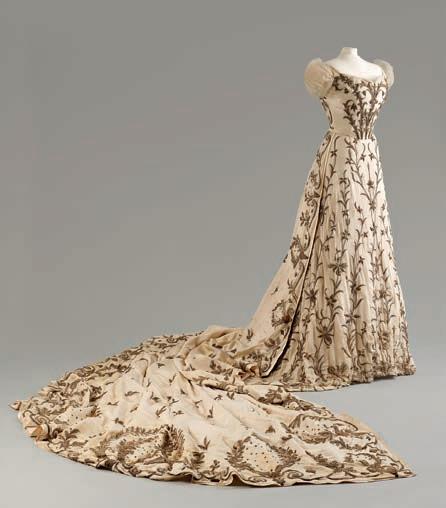
The couple met in 1953 when they were both cast in the Broadway production of William Inge’s Picnic, sparking what would become a decadeslong romance lasting until Newman died in 2008, aged 83.
Woodward, now 93, has led a life out of the limelight after she was diagnosed with Alzheimer’s disease in 2007.
A Lancashire museum, which holds the largest collection of Gillows furniture on public display anywhere in the world, has announced plans for a new exhibition.
Gillows of Lancaster – A Global Story opens on June 29 at the recently-unveiled
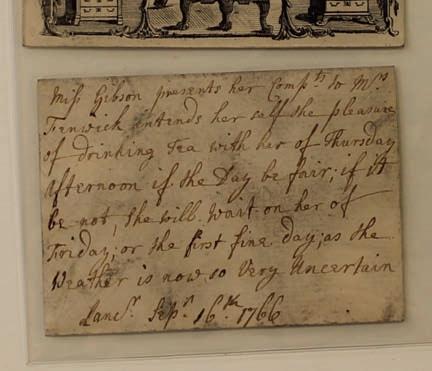

will be sold later in the year, along with an inscribed paper fan and manuscript notebook. From 1945 to 1950, the deposed emperor, who ascended the throne as the Xuantong Emperor at the age of three, was held prisoner in the USSR after the Japanese forces surrendered in 1945.

During ve years of imprisonment at Khabarovsk detention camp he was befriended by his Russian interpreter, Georgy Permyakov to whom he gave the watch.
Puyi’s life would later be dramatised by Bernardo Bertolucci’s 1987 lm e Last Emperor. e items can be seen at Phillips, 30 Berkeley Square, London, from May 6-7.
Top

Above left Aisin-Gioro
(1906-1967).
Woodward’s wedding ring, autographed letters and photographs, antique furniture and the art collected by the couple, as well as Newman’s racing memorabilia and watches will also go under the hammer. The date of the sale is yet to be announced.
The Fashion Museum in Bath has taken up temporary accommodation at the luxury glovemaker Dents in Warminster while work continues on its new home in Bath.
The museum closed its doors at the Assembly Rooms at the end of last October, moving its 100,000-strong collection to a secure storage facility on the outskirts of the Wiltshire town.
Museum manager, Rosemary Harden, said: “It’s the ideal space for the collection and a fantastic opportunity to forge closer links between the museum and one of the UK’s leading heritage fashion brands.”
A new six-part series exploring the hidden history of the National Trust launches this month on BBC Two. e series features some of the UK’s best houses and gardens including Sissinghurt Castle, the home of Vita Sackville-West, to the post-war council house where Paul McCartney grew up in south Liverpool.
e new gallery tells the story of three centuries of the most important regional furniture makers in British history. It will also will explore Gillows’ rise from a regional manufacturer to worldwide manufacturer before its eventual demise in the 20th century.
Hidden Treasures of the National Trust also follows the trust’s experts and conservators at work across Britain, as they breathe new life into fragile marvels and uncover their secret histories. e series is due to air in mid-May.

If readers get a chance, can I recommend an exhibition mentioned in last month’s magazine (All at Sea, April issue of Antique Collecting magazine) namely e Last Voyage of the Gloucester: Norfolk’s Royal Shipwreck? It is on at the Norwich Castle Museum & Art Gallery in Norwich until September 10. My wife and I spent a wonderful afternoon learning about life aboard a royal warship which, in this case, had sank o the coast in 1682. I was also struck by the determination of Norfolk brothers Julian and Lincoln Barnwell and their friend James Little who discovered the wreck in 2007.
Norman Hethcote, Holt, by email
I would be interested to know fellow subscribers’ thoughts on the recent proposal to “cancel” Pablo Picasso, widely seen as the 20th-century’s most in uential artist – because of his misogyny. Does Picasso’s terrible treatment of women and cultural appropriation mean that he deserves to be put on the trash heap? If we hold a moral mirror to all artists, how many of them would pass the standards set out by Gen Z? Laudable as they are.
H. F. Howarth, by email


I visited the Lomax Antique fair in Southwold over the Easter weekend and while I was there took the plunge and bought my rst candlestick. I was very taken by the shape and quality of the piece. e item was described by the dealer as George II (c. 1730) heavy candlestick. It weighs 590gms and is 22cm tall with an octagonal base, which I think is possibly bronze.
I cannot see any seam down the length of piece as one might expect for an item of this period so was wondering if anyone could give me their opinion, or point me in a direction for further research? e base certainly looks as though it has been turned on a lathe.
Mike Percival, Ipswich, by email
Our star letter receives a copy of British Designer Silver by John Andrew and Derek Styles worth £75. Write to us at Antique Collecting magazine, Riverside House, Dock Lane, Melton, Woodbridge, Suffolk, IP12 1PE or email magazine@ accartbooks.com
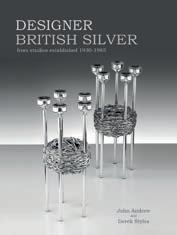
far as my husband and I are concerned, is a trip to Peterborough Festival of Antiques which is usually held around Easter and has, in most cases, been blessed by good weather. So it was a real shock to discover this year’s would be the last as the East of England Arena where it is held is being redeveloped to include new homes, sports pitches, a school, and other facilities.

Left One of the discoveries from the wreck of the Gloucester

Above right April saw the nal antiques fair at the East of England Arena in Peterborough
Below e George II candlestick was bought at a local fair
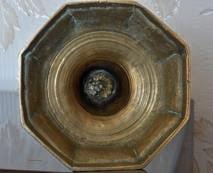

Some but not all the dealers we spoke to will be going to Newark, also run by the IACF, so it looks like that will be our next destination a bit further up the A1. Such a shame to see it go.
Helen Whitmore, Lowestoft, by email
The answers to the quiz on page 48
Q1 (c). Q2 (d). Sierra Leone’s stamps depicted the velociraptor; Eritrea’s depicted the triceratops and Liberia’s, the stegosaurus. Q3 (a) and (b). In German it was known as the krummhorn or ‘curved horn’. The reed, being concealed, was indirectly set in vibration and so the tone could not be varied. Q4 (d). Q5 (c). Firing glasses (rapped on a table during toasts and sounding like gunfire…hence the name) were used by many societies and clubs. The ice-cream glasses have been known to be sold as such by the unscrupulous to the unwary. Q6 (a). An 18th-century term for pearwood stained to simulate ebony. Q7 (a) A 17th/18th-century low stool for children, and (c). 17th-century plain three-legged table (it has been suggested that the three legs resembled the three stumps in cricket, the game). Q8 (c). An early 20th-century card-game published in London but printed in Saxony e.g. put an oriental head on a John Bull body over a Swiss milkmaid’s legs. Q9 (b). It had an arrangement for passing the smoke through water. Also spelt Nargilé. Q10 (d). Dating from the 8th/9th century it is a large scarf worn at High Mass covering the hand of the celebrant. (From Latin humerus, shoulder.)
Open cavern could be rearranged to make provenance; any odd cops could be rearranged to make caddy spoon; oilier film could be rearranged to make millefiori and earth vicar could be rearranged to make architrave.
is month’s postbag delivers a mystery candlestick and an exhibition recommendation from
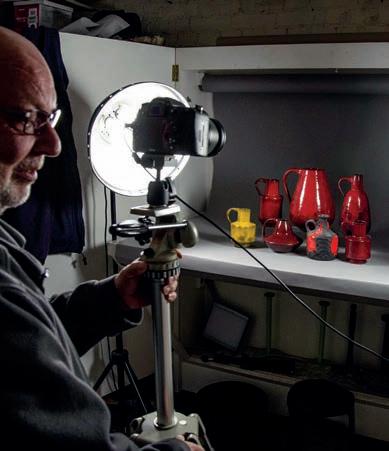


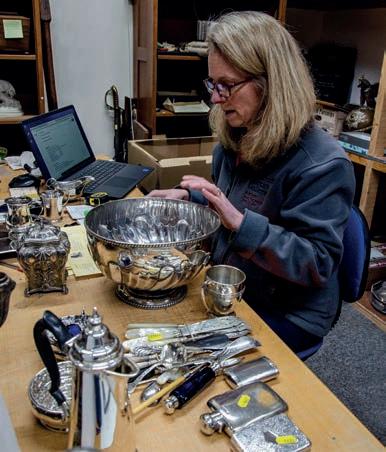

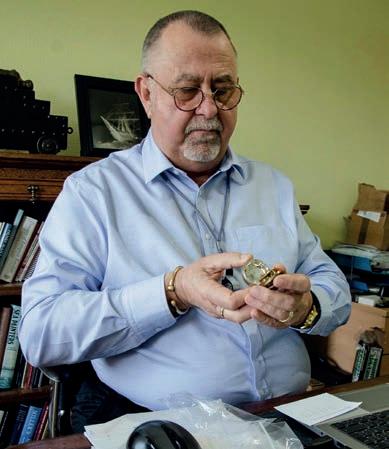


A bowl which the iconic studio potter Lucie Rie (1902-1995) gave to her cleaner sold for £35,000 at the auction house’s recent sale. e fullynished footed bowl in turquoise and manganese glaze had a presale estimate of £20,000-£30,000, re ecting the collectability of the footed style.
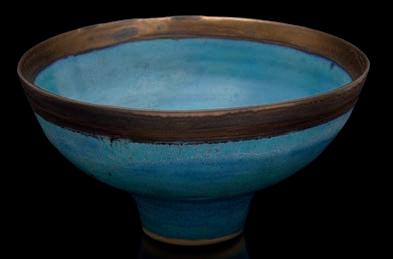
Rie, who was born in Vienna but ed to London to avoid the Nazis, also bequeathed a mould for making buttons to the vendor’s mother who worked for the potter at Rie’s home and studio at 18 Albion Mews, Paddington.
At the same sale a still life by the Polish artist Marek Zulawski (1908-1985), expected to make £200-£300, sold for £1,125. Zulawski’s early gift for painting was developed in Warsaw (1927-1933) and Paris (1935-1936). By 1937, he had settled in England where he soon became a noted gure in the London art world.

A late 19th-century Chinese silk robe bought by the wife of a senior naval o cer serving in the second Sino-Japanese war in the late 1930s sold for £2,500 at the Kent auctioneer’s sale on April 1. e garment, embroidered in silk and gold threads, is decorated with nine dragons, bats and oral sprays, above rolling waves.

It was consigned by the granddaughter of Lady Patricia Cunninghame Graham (1901-1998) who bought it when her husband, Admiral Sir Angus Cunninghame Graham was captain of HMS Tarantula and senior naval o cer on the West River in China.
A 16th-century Mexican feather mosaic picture, with a pre-sale guide price of £700-£1,000 sold for £18,000 at the North Yorkshire auctioneer’s recent sale.

Having ourished as an Aztec art form in pre-Columbian Mexico, the Spanish colonists prevented the Amantecas, or feather artists, from continuing to produce their traditional indigenous subjects, however they did encourage them to produce Christian subjects. In the 16th century many such pieces were sent to Europe to show the quality of this exotic art and also to represent the progress made in the conversion of the New World to Christianity.
At the same sale a late 18th-century George III Chippendalestyle mahogany and oak-lined chest on chest sold for £15,000 against an estimate of £2,000-3,000.

Paintings from the “circle of” two famous female artists caused a stir in the salerooms, along with a 2007 iPhone in its original caseThe chest on chest sold for £15,000 against an estimate of £2,000-£3,000 The 16th-century Mexican feather mosaic picture tickled bidders in Leyburn The footed bowl in turquoise with a manganese rim sold for £35,000 Marek Zulawski (19081985) Still life with Jug and Fish, oil on canvas sold for £1,125 The impressive robe sold for five times its low estimate
A late 17th-century nutmeg grater in the shape of a teardrop, which carried a pre-sale estimate of £300-£400 sold for £2,400 at the Dorset auction house’s recent sale.
Measuring 4cm x 3.5cm x 2.5cm high, it has the typical ‘stand away’ hinge of the period with the cover engraved with a rose and tulip. Early nutmeg graters were either heart-shaped or teardrop form, and big enough to hold a nutmeg.
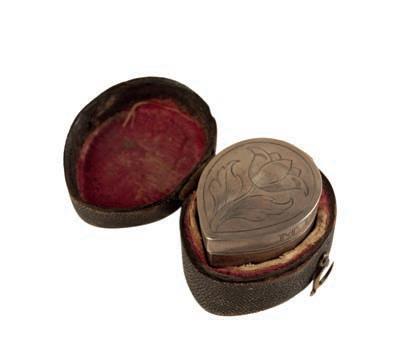
Used as a status symbol, it was fashionable for men to carry a personal supply of the spice and a small grater tucked into a vest pocket.
A circular painting, or tondo, catalogued as “from the circle” of Angelica Kau man sold for £67,000 at the Berkshire auction house. e oil on copper, titled Return of a Knight in Armour measured 13in (33cm) in diameter.

Kau man (1741-1807) was a Swiss neoclassical painter who found success in London where she was befriended by Sir Joshua Reynolds. Works “from her circle” usually sell for less than £1,000 but such was its superb execution, 18th-century date and good condition it sparked a heated bidding war.
The nutmeg grater defied expectations in the Dorset saleroom
The tondo, catalogued as from the “circle of Angelica Kauffman” sold for £67,000

A portrait of a lady catalogued as “from the circle” of Mary Beale (1632-1699) estimated at £2,000-£3,000, sparked a bidding war before selling for £31,000 at the auction house’s recent sale. e 4ft 2in x 3ft 5in (1.27m x 1.04m) oil on canvas was of a woman in a brown dress and blue cape who may have been one of the Fairfax family – well known land owners in Yorkshire. Su olk-born Beale was an English portrait painter and part of a small band of female professional artists working in London.
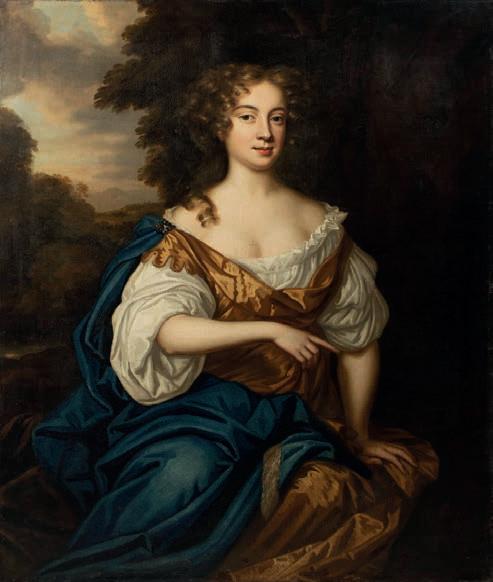
A Belle Époque platinum, sapphire and diamond bracelet, expected to make £2,000-£3,000 sold for £32,500 at the auction house’s recent sale.
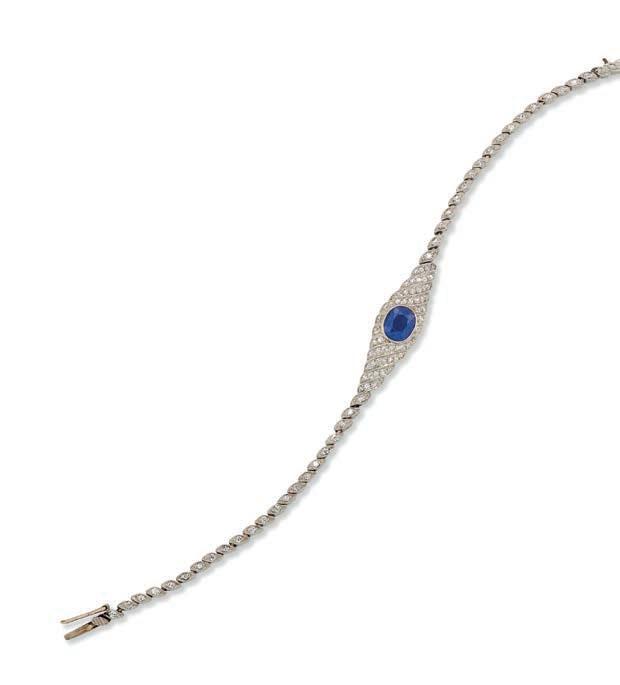
Dating from c. 1910 and measuring 16cm, the collet-set oval sapphire is set in an oldbrilliant-cut diamond bracelet.
An iconic Birkin bag by Hermès, bought directly from the maker last year for €8,400, sold for £19,500 at the London auction house’s specialist sale of designer bags. e price achieved for the leather Sellier Birkin 25 proved its enduring popularity. Elmwood’s co-owner, Ben Gosling, said: “Due to their immense popularity buyers can be on a waiting lists for years to buy at retail.” Inspiration for the Birkin came about about when Hermès chief executive, Jean-Louis Dumas, spotted the French actress Jane Birkin on a ight from Paris to London struggling with a straw travelling bag.
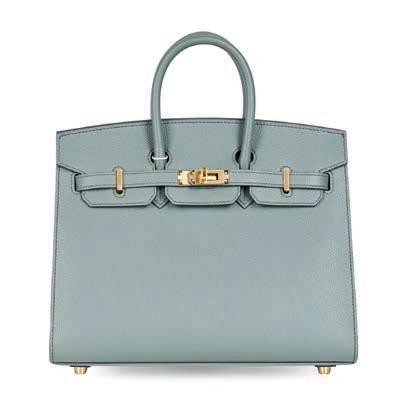
Buying a Birkin at auction is one way to avoid years-long waits for the iconic design
At the same sale a lapis lazuli and maw sit sit ring, c. 1970, attributed to Augustin Julia-Plana, exceeded its pre-sale estimate of £200-£300 to make £3,900.
Augustin Julia-Plana was born in Mataro, near Barcelona, in 1934. In his youth, he was a talented track and eld athlete, and in 1954 was the Spanish 4 x 400m relay champion. After military service, he attended art school before joining the Swiss jewellers Simon Schlegel in 1963. He was known for using unusual materials in his designs, such as wood, meteorite, maw sit sit (a bright green metamorphic rock often confused with jade) and selecting materials for their innate beauty rather than monetary value.
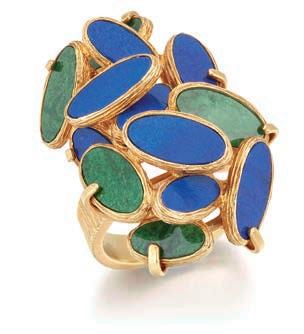
The AngloFrench medieval carving sold for £13,000
An unopened rst generation original Apple iPhone more than doubled its low estimate of $20,000 when it sold for $54,000 at the New Hampshire auction house’s recent sale called ‘Steve Jobs and the Apple Computer Revolution’.
e box features a life-size image of the iPhone with 12 icons on the screen, indicating that it is from the earliest production (2007); a 13th icon, for iTunes, came later in the year.

The pipe stand racked up a very creditable £2,800
An unusual 19th-century Anglo-American pipe rack, in the shape of an oak tree, sold for £2,800, against a guide price of £600-£800 at the Su olk auctioneer’s sale of the Beedham collection.
Dated 1800-1850, the stand, which is 69cm wide and 38.5cm high, is designed around a sporran-shaped tobacco pouch, with two pipes atop a 24-pipe aperture shelf.

At the same sale a rare 12th-century Romanesque, carved oak bear, which had been expected to make £2,000-£3,000 sold for £13,000. e Anglo-French carving, c. 1150, which is 60cm long and carved from one piece of wood, may have been used as a medieval door support.
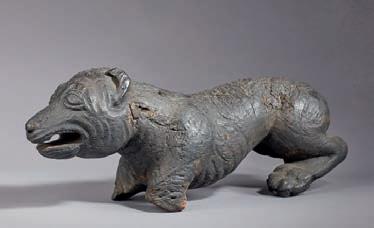
e auction house was recently charged with the sale of stock from Beedham Antiques, the Hungerford-based specialists in ne English and European 15th, 16th, 17th-century oak and early sculptural works of art.
A rare letter signed by the English essayist and lexicographer Samuel Johnson (1709-1784) sold for £13,200 at the Shropshire auction house, against an estimate of £3,000-£5,000.
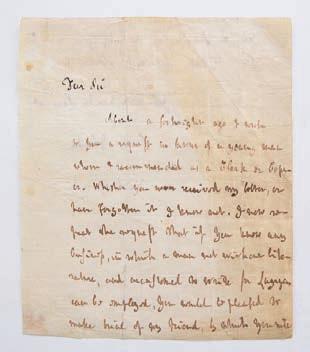
e high price re ects the scarcity of Johnson letters: American collectors Donald and Mary Hyde acquired 746 Johnson letters, more than half the known total which they bequeathed to Harvard’s Houghton Library in 2003.

The rare letter by Samuel Johnson is requesting employment for an acquaintance
e two-sided letter, written on March 17, 1783, urges the unnamed correspondent to employ a young man known to Johnson. He writes: “About a fortnight ago, I wrote to you a request in favour of a young man whom I recommended as a clerk or copyer... I now repeat the request that if you know any business, in which a man not without literature, and accustomed to write for lawyers can be employed, you would be pleased to make trial of my friend.”
e letter was purchased by the vendor at Sotheby’s in the 1960s, when the Hydes were very active, “to stop it from going abroad”.
It was consigned by an Apple employee who bought it on its release in 2007, but left it unopened as he received one through work.
At the same sale one of Steve Jobs’ Apple business cards, dating from 1983, sold for $6,188 against an estimate of $1,000.
e card notes his role as “Steven Jobs, Chairman Board of Directors” and features the iconic rainbow’ version of the Apple ‘byte’ logo.


e Force was with the daughters of a local toy salesman when they sold his prized Star Wars collection for £15,130 at the Sta ordshire auction house’s recent sale.
e gures, which had remained sealed in original blister packs for 40 years, included a sealed 1983 Kenner gure of Boba Fett from Return Of e Jedi, which sold for £1,600 and a Palitoy gure of Luke Skywalker which made £1,350.
ree original ‘Mail-away’ Boba Fett gures, sealed in original plain packaging – designed to have been ordered through the post via a special o er – totalled £3,300.

Between 1978 to 1985, American toy company Kenner produced and sold Star Wars action gures. In the UK, the licence was held by Palitoy with the company importing the gures for packaging in Britain on Palitoy branded cardbacks.

One of three original ‘mailaway’ Boba
figures which sold for a total of £3,300
The Palitoy
from the same film made £1,350.





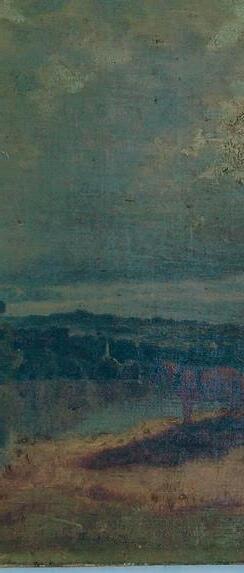


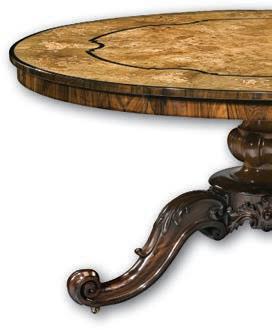
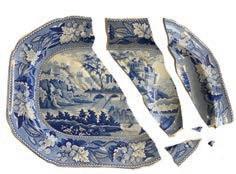
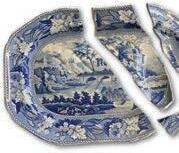




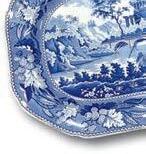



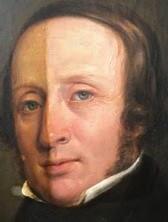
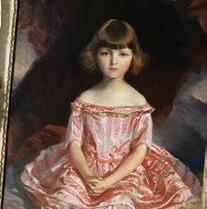

One of the reasons the world of antiques is so exciting is its unpredictability. We deal in unique pieces made over the past centuries, which means you can’t just phone or e-mail the factory to order another three of, say, model 28. On the other hand, surprises are only ever a phone call away.
When a collector called me a couple of weeks ago to tell me he was willing to part with a chest of drawers to pay for expensive repairs to his car I leapt at the opportunity. ree days later I was standing in front of this magni cent piece here in my showrooms.
Aesop’s quote “Good things come in small packages” was never truer than in this case. At 86cm (34in) wide the chest was smaller than I had expected but just sings Chippendale period when you look at it. With its sweeping, bold, serpentine front and the moulded edge
to the top, as well as the serpentine pull-out slide all emphasise its depth and quality.
When we refer to the “Chippendale period” we don’t necessarily attribute the piece to the Otley-born London cabinetmaker omas Chippendale (1718–1779) himself, but rather it was made at the time when he was working.

e chest and its decoration are derived from his famous book of designs e Gentleman and Cabinet Maker’s Director.


It was published in 1754 and the term “Chippendale” is regularly used to describe English Rococo furniture inspired by the illustrated designs within it.
e book contains 161 engraved plates for a wide range of domestic furniture in the Gothic, Chinese, and Rococo styles, as well as a series of plain domestic pieces. A virtually identical second edition was issued in 1755, and a third enlarged and revised edition appeared in 1762.

e canted corners on the piece are decorated with blind fretwork derived from plate 196 of the third edition of the Director. In plates 192 and 193 of the same edition there are eight further examples.


Chippendale’s book of designs was e ectively the rst ever trade catalogue from which customers could browse, select a design and then order a piece of furniture.
It was extremely successful and subscribed to by many cabinet makers throughout the country including rms such as Gillows of Lancaster.
In the case of this cabinet, the size and quality make me believe it was by one of the top makers of the middle years of the 18th century. In which case it could have been produced by a number of Chippendale’s contemporaries including Vile and Cobb, Hallet, Ince and Mayhew, William and John Linnell, or Channon.
Above e chest sings
Chippendale period
Above right e canted corners are decorated with blind fretwork
Right e fretwork is based on plate 196 of the third edition of the Director
A recently-acquired chest has all the hallmarks of one of the nest Chippendale period pieces, writes David Harvey
Left One of the Lascelles commodes and a detail of the handle
Right e handles on our chest are gilt on brass rather than brass
When I looked at the handles, backplates and escutcheons, they rang a bell. I had seen them before on pieces documented as being by Chippendale himself.
They are not ordinary brass handles but are gilt onto the brass with significant areas of the original gilding seen quite clearly.
They are very Rococo in style and show how decoration in the middle of the 18th century fused Gothic, Chinese and Rococo idioms all together in one harmonious piece of furniture.
In Dumfries House in Ayrshire, Scotland, one of Chippendale’s larger commissions for the 5th Earl of Dumfries, there is a large library desk supplied by Chippendale in 1759.
e identical handles and escutcheons have been used and at some time the backplates behind the pommels or posts have been turned through 90 degrees. It does look a little curious and in the Christie’s catalogue for the sale in 2007 (which never took place after the then Prince of Wales, now Charles III stepped in to save it) lot 30, on pages 123-129 of the catalogue shows the desk by Chippendale with the identical metalware. A similar design can also be seen in an illustration from a mid-18th century brassware catalogue.
e model gilt brass handles and escutcheons are favourites of Chippendale and appear on the very best of pieces by him. ey are also identical to those on a pair of commodes made by Chippendale, c. 1770, for Daniel Lascelles (1714-1784) at Goldsborough Hall, near Knaresborough, Yorkshire, now part of the Harewood estate. Once again we see here the sweeping serpentine
Below left Gilt brass handles and escutcheons are favourites of Chippendale
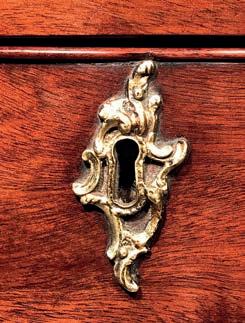
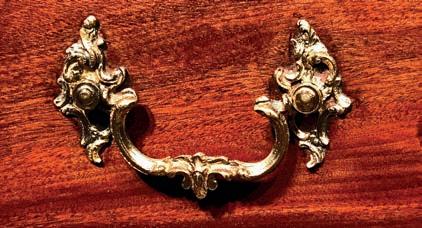
Below A similar design appears in An Eighteenth Century English Brass Hardware Catalogue by eodore R. Crom
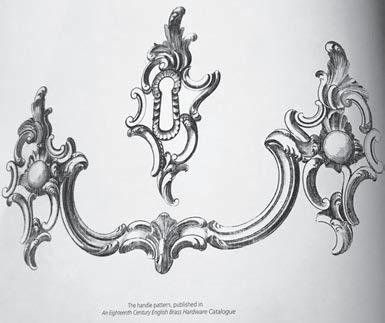
Below right e chest has a large ogee bracket foot
shape and moulded edge to the top. We know Chippendale supplied furniture to Lascelles at Goldsborough because of references in his Day Work Book.
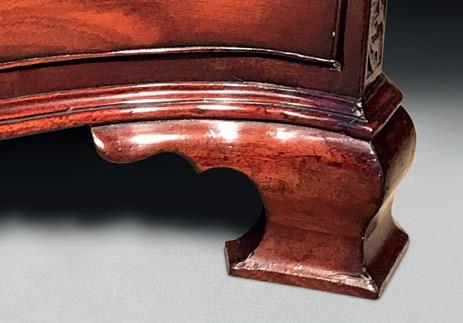
e splayed feet at the corners of the commode and the substantial ogee bracket feet on our chest, show the breadth of styles available at that time. e bracket foot being more traditional, with the splayed, scrolled foot of the commode clearly showing the in uence of contemporary French furniture designs.
In terms of date it is clear that the chest of drawers falls in the time frame of these two proven Chippendale pieces: the Dumfries desk of 1759 and the Lascelles commodes of 1770. e construction is very de nitely English and very high quality. Unlike Gillows, Chippendale did not use a maker’s mark, so verifying the item as being made by him or his craftsmen generally requires original documentation. If not the great man himself, surely this chest is the work of one of the age’s best makers?
David Harvey is the owner of Witney-based W R Harvey & Co. (Antiques) Ltd. For more details go to the website www.wrharvey.com
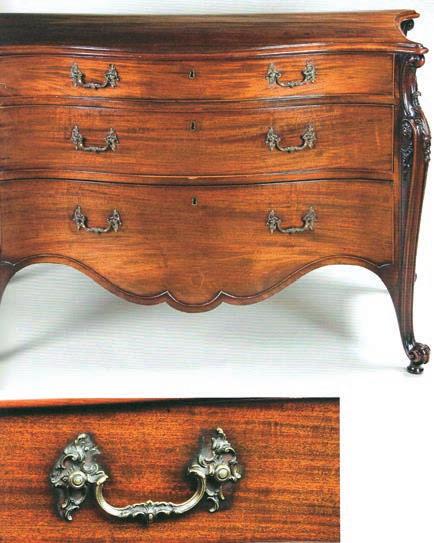
‘When I looked at the handles, backplates and escutcheons, they rang a bell. I had seen them before on pieces documented as being by Chippendale himself’
To me there is something hugely romantic about royal commemorations and their ability to unite individuals with a shared sense of history so I await this month’s event on May 6 with extra anticipation. e coronation ceremonies held during the 20th century have provided citizens of the Commonwealth with an opportunity for celebration and national pride.
e design of the coronations can tell us a great deal about the era in which they occurred, alongside the society and politics of the time.
ey can even re ect the monarch’s aptitude for the job – Queen Elizabeth II’s was strong, traditional and re ective of her family history. Charles III’s coronation is set to be
pared back, with the invitation re ecting the importance of the natural world.
Ordinarily, coronation furniture falls into two categories: chairs and stools. Coronation chairs were typically designed for peers while accompanying stools were designed to be used by the other distinguished guests, or their wives – or footmen.
During the 20th century, in order to recoup costs after the ceremonies, attendees were given the opportunity to purchase the furniture they had used. It is worth noting that dukes were given bespoke chairs, bearing their coat of arms. ese chairs are rare and seldom appear on the open market.

With this month’s coronation of Charles III, royal memorabilia devotee Stephanie Connell looks back on the furniture of previous ceremonies – and its collectabilityAbove A George VI coronation chair and stool (left) and a Queen Elizabeth II coronation chair (right) sold for £6,875 at Christie’s sale of the Althorp Estate in 2010 (against an estimate of £700-£1,000)
e coronation of Edward VII was held on August 9, 1902, famously postponed because of the king’s appendicitis operation. e event was planned as large ceremony, which would cement the power of the monarchy and the new king.
e great success of golden and diamond jubilee celebrations held for Queen Victoria only a few years prior helped form this assessment. erefore, when the committee to organise the event was established music and design were important factors. ere was, however, a deliberate attempt to widen the societal breadth of attendees, from government o cials to Indian maharajas. In all, 6,603 seats were allocated (rising to 7,139 for the coronation of George V nine years later).
e chairs used by the invited guests were simply designed, with a mahogany frame and rush seat, typical of the period’s arts and crafts aesthetic.
e design is sometimes credited to the Leicesterborn furniture maker and architect Ernest William Gimson (1864-1919), one of the most important makers of the arts and crafts movement.
Stools were also made in a similar style, but with a caned seat marked to the underside and matched with a splendid yellow velvet cushion bearing the Tudor rose.
A handful of notable Wycombe rms were to supply chairs and stools for ve planned coronations. To me the design captures both strength and simplicity. e back rail of each chair is stamped with details of the coronation itself.
e chair stretchers bear an impressed stamp to the back of seat rail: CORONATION and monogrammed E.R VII with a crown.

Above Frank O. Salisbury (1874–1962) Coronation of King George VI (18951952), image public domain
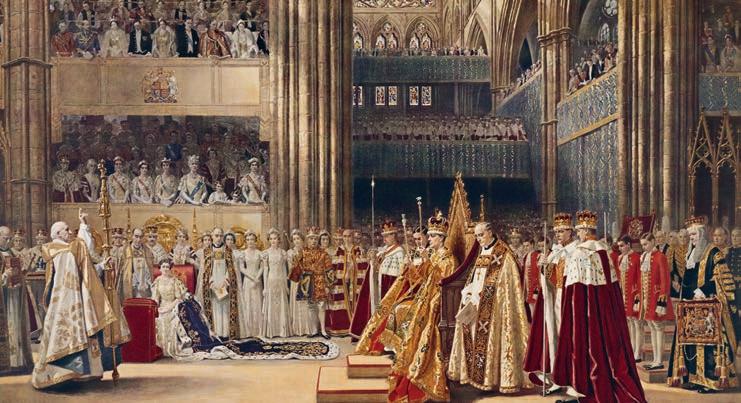
Below left A pair of original King Edward VII coronation chairs, 1902, in mahogany, with triple splats, drop in rushed seats and square form legs, image courtesy of Stephanie Connell Antiques
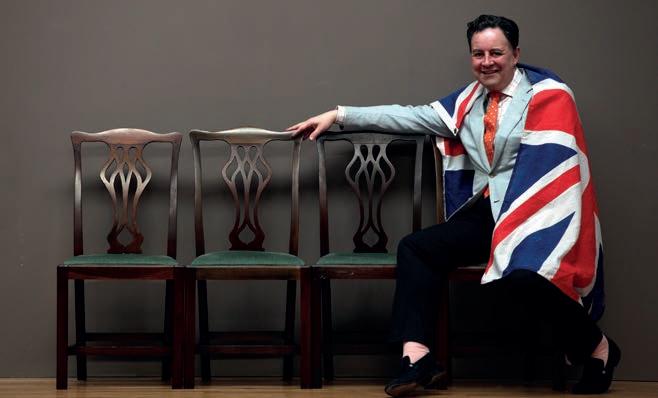

Bottom left e chair stretchers have an impressed stamp to back of seat rail CORONATION and monogrammed E.R VII, image courtesy of Stephanie Connell Antiques
Below Anderson and Garland’s Steven Moore with four chairs made for the coronation of George V in 1911. Two are stamped with the words George V coronation, a crown and a place number, image courtesy Newcastle Journal

George V’s coronation, held in June 1911, was a more grand and traditional a air. e chair design chosen for the ceremony re ects this, being Chippendale inspired with a leather seat. e stool, in common with those produced for Edward VII was of plain design. e stools were upholstered rather than caned but both the chair and stool are very di cult to recognise without discovering the stamp underneath.
George V coronation furniture was manufactured by B. North & Sons of High Wycombe (established 1864) and quite possibly by Frederick Parker & Sons (established 1871, later Parker-Knoll Ltd). e furniture was marked with details of the coronation itself. For the collector, George V coronation chairs can often be mistaken for an Edwardian Chippendale-style dining chair and it is important to look at them properly to identify them.
‘For the collector George V coronation chairs can often be mistaken for an Edwardian Chippendale-style dining chair and it is important to look at them properly to identify them’
Left e chair, thought to be designed by Edward Barnsley, was for a coronation that didn’t go ahead, image courtesy of Bonhams
After his abdication in early December 1936, the coronation of Edward VIII did not go ahead. As mentioned Edward took little interest in plans for a ceremony he didn’t want to take place. Chairs thought to have been produced for the coronation with a design often attributed to the furniture maker Edward Barnsley (1900-1987) have been sold at auction in recent years.
ere chairs are in a low-key Cotswold style, in a natural waxed oak with and without arms. Chairs after this design remained in production until the 1950s for use in government departments and the War O ce.
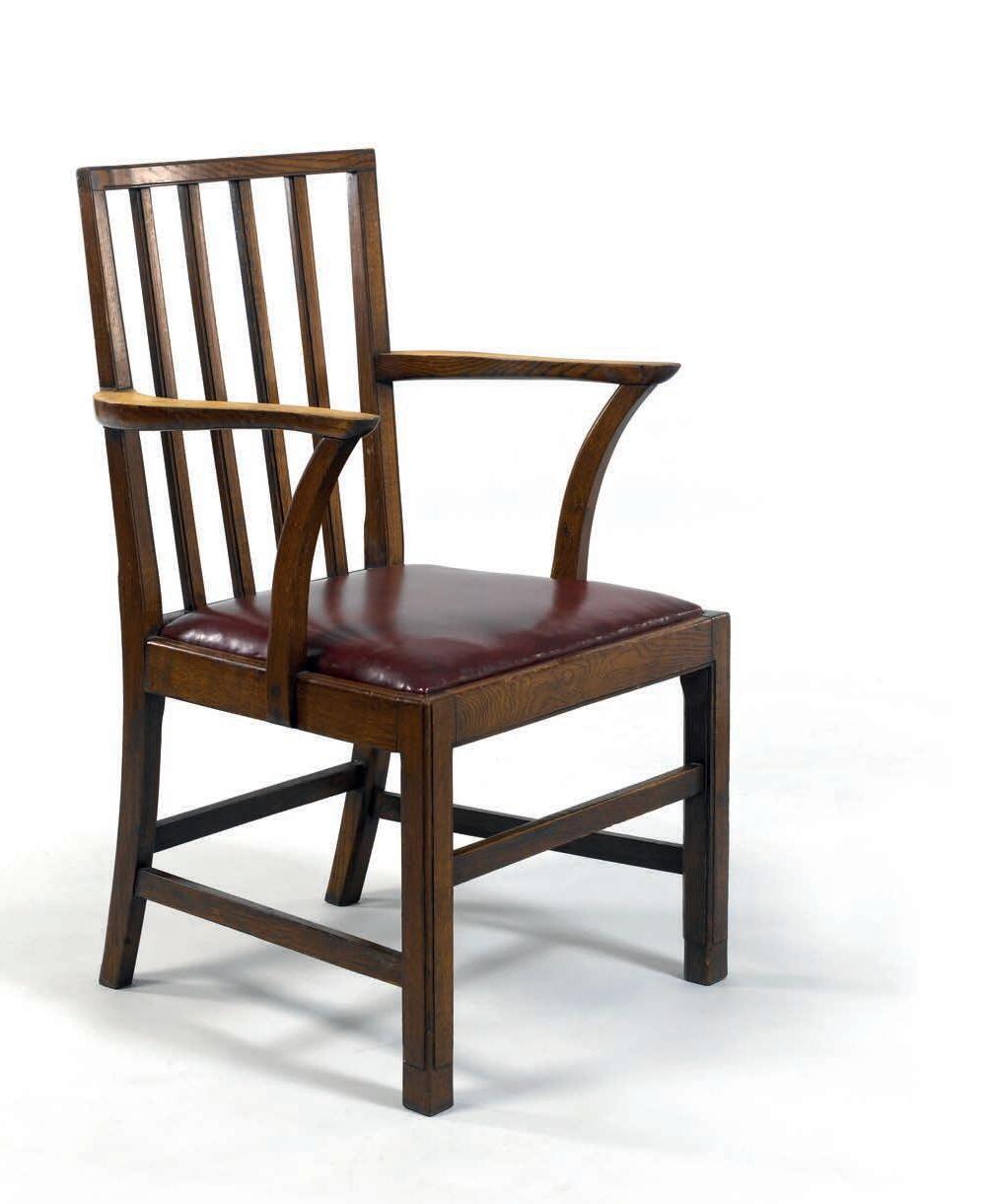
Following his brother’s abdication the coronation of George VI was set to take place on the same date. George VI had been heavily involved with the plans for his brother’s investiture and following the abdication crisis it was agreed the ceremony should be more of a show of royal power.
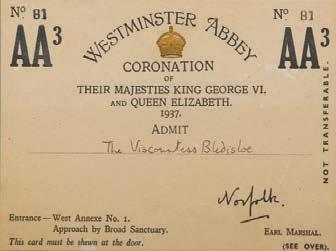
George VI
e furniture designed for the coronation of George VI in May 1937 was of a di erent sort entirely. One can see that great pains had been taken to give an added sense of pageantry and theatre not seen in the Coronation design


Despite the relatively large number of chairs and stools made, prices for coronation furniture are on the rise, as collectors begin to appreciate their historical associations – and practicality. Condition and originality is all-important, and some Elizabeth II chairs can still be found with their original cotton covers, preserving the velour beneath.
Many chairs on the market have been re-covered or otherwise re-upholstered. Stools can sell for over £500. Earlier furniture from the coronations of Edward VII and George V can be harder to find, in as much that sellers, failing to spot the coronation stamps, are often unaware of their furniture’s royal associations.
Edward VII stools are genuinely scarce, especially if they retain their original upholstered cushion. Association can

substantially affect values. A pair of coronation stools used by Douglas Fairbanks Junior and Mary Pickford at the coronation of Elizabeth II fetched $2,500 at Doyle’s New York in 2011, while the inscribed chair used by Queen Mary at the 1937 coronation fetched £38,000 at Christie’s in 2006.
Two George VI chairs and a re-upholstered stool fetched £6,875 at Christie’s in 2010. Both were from the Althorp Estate, the childhood home of the late Princess of Wales.
up to this point. e development in the design of the furniture also re ects the theatrical nature of the coronation ceremony.
Changes in technology meant for the rst time the ceremony could be broadcast to audiences across the globe.
e dowager
Queen Mary took great interest in the design of the furniture for the ceremony and ensured it had a traditional feel in keeping with previous coronation ceremonies.
A rare coronation day poster designed by Howard Stabler for the London Underground, re ects the revived emphasis on all things royal, with its rich use of imperial crown, ermine, purple cushion and royal cypher.

In contrast to the Edward VIII chair, the new version was constructed from limed oak, and featured rich regal blue-green velour upholstery and bore the royal cipher in gilt braid. e applied gold braid to the edges further adds to the sense of occasion. e stools, although relatively plain were covered in the same velvet and edged with gold braid. Both chairs and stools were made by reputable makers including W. Hands & Sons of High Wycombe, North & Sons, Maple & Co., and Waring & Gillow.
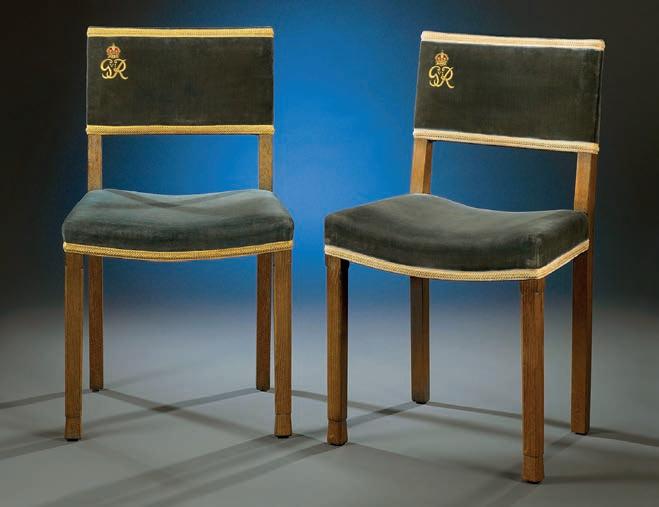
Recent research into a chair and stool has shown they were likely used by a peer and his wife at the coronation of George III in 1761.
As reported in a recent issue of Antique Collecting magazine the pair had been owned by coronation attendee Lord Gwydir, the deputy lord chamberlain of the day whose job it was to order all the furniture required for the coronation.
Above right e chair was described as a “George III mahogany bergère c. 1760” in a sale catalogue of 2012, image courtesy of Christie’s Left Coronation day poster, designed by Howard Stabler, Baynard Press, 1937, image courtesy of Stephanie Connell Antiques
Below right e George III mahogany footstool appeared with its chair, image courtesy of Christie’s

After the ceremony, Lord Gwydir took a number of pieces including a chair and stool which ended up in his home at Gwydir Castle in Wales where they remained for more than 150 years. In 1921, the pair appeared in the castle’s dispersal, listed as a “peer’s seat at the coronation of George III”. The stool was described as “‘in similar design in original covering en suite and was used as a Peeress’ stool at the same function.”
It later appeared at Christie’s in 2012 as part of the sale of deaccessioned pieces from the the Huntington Art Gallery where the chair was described as a George III mahogany bergère c. 1760 with a George III mahogany stool. The chair was purchased by the antique dealer David Love who was drawn to its unusually large size and both pieces are now reunited in a private collection.
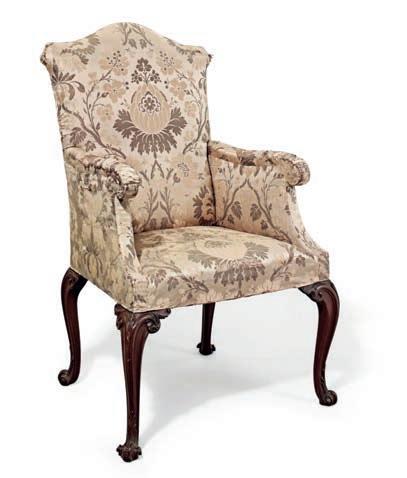
‘George VI had been heavily involved with the plans for his brother Edward VIII’s investiture who had desired no coronation ceremony at all, and only agreed upon a pared down service’
Chairs from the coronation of Elizabeth II on June 2, 1953 are of similar farthingale design to those of her father’s coronation, but feature legs in silvered oak, with upholstery in a Royal Blue.
Some 2,000 chairs and 5,700 stools made of limed oak and beech were manufactured for the coronation, with the Ministry of Works responsible for commissioning all furnishings for the coronation.
As had been the case for her father, George VI’s coronation, furniture manufacturers based in High Wycombe – the centre of English chair making during this period – produced all the chairs and stools.
Chairs for the peers and peeresses were made by two High Wycombe rms (North & Sons and Hands & Sons) with the stools made by four companies (North & Sons, omas Glenister, Castle Bros and Waring & Gillow). All were upholstered in a blue velvet embroidered with the royal cypher made in Bradford.
e design resurfaced again in 1977 when the Buckinghamshire furniture manufacturer, Hands, produced a limited replica edition for the Queen’s Silver Jubilee.
On June 23 Hansard noted: “In considering applications for chairs, preference will be given to those who occupied them. Chairs will cost £7 10s. 0d. each and stools £4 7s. 6d. each, including packing and delivery. Applications should be sent, not later than June 30, 1953, to e Controller of Supplies, Ministry of Works, Great Westminster House, Horseferry Road, London, S.W.1. e envelope should be marked “Abbey furniture.”
Any remaining items left unsold were available to purchase from the Ministry of Works. Prices have increased over the past ve years, with Elizabeth II examples being particularly sought after.
Above An Elizabeth II coronation stool, the blue velvet upholstery was woven at the Lister Mills in Bradford, image courtesy of Stephanie Connell Antiques
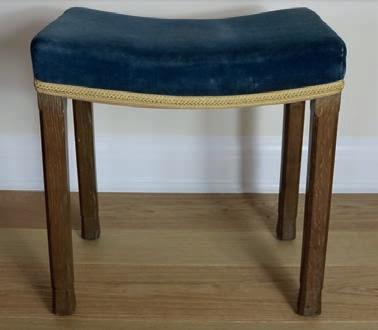
Above right A peeress’s coronation robe, possibly worn by Charlotte, Countess Spencer (1835-1903) to the coronation of Edward VII. It sold for £6,250 (against an estimate of £600-£800) at the Althorp attic sale in 2010, image courtesy of Christie’s
Below A pair of Elizabeth II coronation painted oak chairs, c. 1953, sold for £1,062 in 2015, one chair is stamped: ‘ER CORONATION, W. HANDS & SONS LTD’, image courtesy of Bonhams
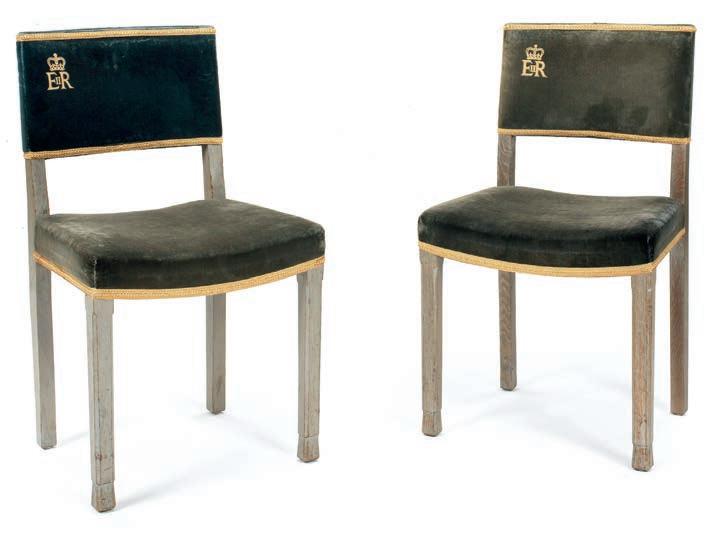
The coronation of Charles III is set to be a much less ceremonial event than in previous times.
In 1953, more than 800 lords and peers were invited to the coronation of Elizabeth II, with the abbey packed with 8,251 guests. For this month’s coronation, with just 2,000 attendees, only the most senior Cabinet ministers, Privy Councillors and opposition leaders will receive an invite, with many of the traditional rituals, including the presentation of gold ingots, not featuring.
In order to qualify for a role in Charles III’s coronation, peers had to be selected after submitting a claim to the Coronation Claims Office, making a case for their hereditary right to perform offices during the service. These might include carrying one of the king’s swords, bearing a standard, or even tasting his wine. Claims usually rest on an ancestor having performed the role at some time in the past.
At the coronation of Charles III peers will wear suits and formal dresses as opposed to ceremonial robes of former times.
The decision might come as a blow to the aristocracy in possession of carefully-stored coronation robes which would have been handed down through the generations. Such robes were made of crimson silk velvet, extending to the feet, whilst the rank of the peer is indicated by rows of “ermine tails” on the miniver cape: four for a duke, three-and-a-half for a marquess, three for an earl, two-and-a-half for a viscount and two for a baron.

For the coronation of King George IV in 1820, a full set of coronation robes for a baron, complete with a fine linen robe and coronet case, and a cedar robe chest with patent lock, brass hinges, and inscription plate, cost £3,250
In 1935, royal dressmaker Norman Hartnell designed a new peeresses’ robe which was open over a sleeveless gown, with an all-round cape collar of white fur, with ermine according to rank.



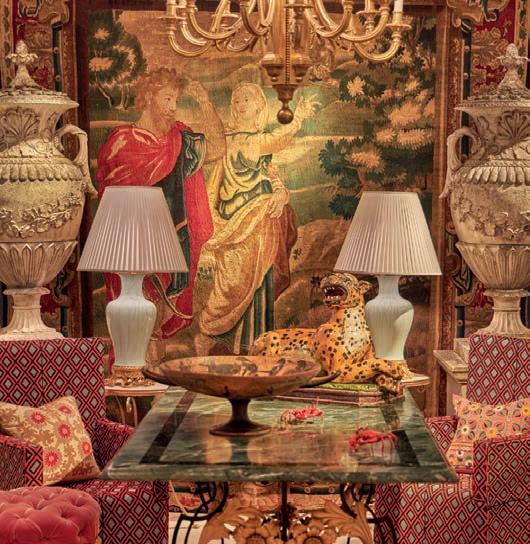
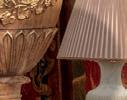



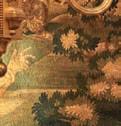

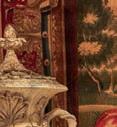



For the collector, Doulton
Lambeth wares present a huge range of materials, processes and decorative treatments, not to mention some 9,000 designs. As a collection goes under the hammer in Essex this month Antique

Collecting reports
Above A selection of George Tinworth (18431913) pieces in this month’s sale, including (l-r) a Doulton stoneware
Mouse Musician gure, 1885, modelled playing a sousaphone, 10.8cm high, which has an estimate of £600-£800; a Doulton stoneware
Mouse Musicians group, c.1885, modelled as three mice, 12cm wide 7.5cm high, which has an estimate of £1,500£2,000 and a rare Doulton Lambeth Nautical clock, 1878, 27.5cm wide, 22cm high, which has an estimate of £3,000-£5,000
Right George Tinworth (1843-1913) a ‘Nautical’ clock, 1878, decorated by Hannah Barlow also appears in this month’s sale

This month sees the rst part of the Ann Turner collection of Doulton pottery go under the hammer at Sworders auction house in Stansted Mount tchet. e sale will see 100 lots of Lambeth Doulton up for sale with estimates ranging from £200 to £5,000.
Ann Turner, a musician whose husband worked for a Swiss bank, built up a collection of Doulton over 40 years, with her Hertfordshire home adorned oor to ceiling with pieces.
Sworders head of design, John Black, said: “ e range of this collection is truly astonishing. Not only are all of Doulton’s best known artists represented but many of the pieces are the best of their kind.”
e pottery made by Doulton in Lambeth on the banks of the River ames is a far cry from the ornate, decorative pieces we associate with the later 19th century (Edward VII granted a royal warrant to Doulton in 1901 and the right to use ‘Royal’ in the name).
We have to go back as far as 1812 to nd John Doulton working at a small pottery in Vauxhall Walk in Lambeth. He was employed by John Watts, the manager of the pottery who was so impressed by the quality of Doulton’s work he o ered him a partnership in the pottery into which he invested his life savings of £100. By 1826, Doulton & Watts had outgrown their Vauxhall Walk premises and moved to Lambeth High Street.
At the time the company was riding high due to its role in the ‘sanitary revolution’ - pioneering the general use of stoneware drain pipes and water lters to improve living conditions. Doulton had come up with a smooth-glazed, stoneware portable lter case containing a block of charcoal and the successful implementation of this system changed the face of the British sanitary structure.
In 1835, John Doulton’s son, Henry Doulton, entered the rm, aged 15, soon establishing his credentials for business acumen, not least of which with his application of steam to drive the potters’ wheels.
Soon after Doulton & Co. as it was then known exhibited a single stoneware salt cellar decorated with incised banding and heightened with blue glaze. It was the rst Doulton Lambeth decorative piece and gave birth to the art pottery that would follow.


When it comes to Doulton Lambeth two names spring to mind: George Tinworth (1843-1913) and Hannah Barlow (1851-1916) – both of whom were taken on in the 1860s after Henry’s decision to diversify into art pottery.
Central to Doulton’s expansion was the Lambeth School of Art, an institution created for educating working class boys in the skills of technical and engineering draughtsmanship, and its principal John Sparke.
Tinworth was born in Walworth in 1843, the son of a far from well-o wheelwright. From an early age he showed an aptitude for carving little gures in wood and stone, a talent looked down on by his father but encouraged by his mother. In 1866, after studying at the Lambeth School of Art he joined Doulton as a pottery modeller – his puritanism (he was against alcohol and tobacco and spent his dinner breaks reading the Bible) –cutting a strange gure at the kiln.
e partnership between Doulton and the school was rst evident in a set of terracotta heads depicting notable European potters, including Wedgwood and Palissy. Not only was Tinworth able to concentrate on gural work he was able to design a number of vases and steins using what would be known as a “seaweed” pattern of incised banding and applied orets, a style and colour that is a recognisable characteristic of Doulton’s Lambeth pottery.
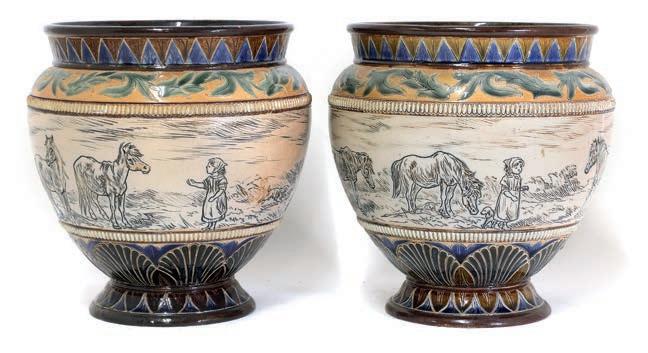
By 1867, a collection of vases, jugs and mugs had been created that was good enough to display at the Paris Exhibition that year, where it received a favourable response that persuaded Doulton to start building up a signi cant art department.
Above George Tinworth (1843-1913) two Doulton stoneware Mouse Musician menu holders, both dated 1885, one with a mouse playing a harp and another a squeeze box, the other a mouse playing a harp and one on a cello, 9.5cm and 10cm high. e pair has an estimate of £1,000£1,500


Below George Tinworth (1843-1913) a terracotta plaque in Lambeth High Street, showing Henry Doulton (seated towards the right); Hannah Barlow (seated on the left with her cat under her chair); George Tinworth (centre, holding the pot), image public domain

Tinworth is best remembered by today’s collectors for his witty and cleverly designed animal figures and tableaux. They also gave expression to Victorian humour and the fine line between the comic and macabre. While one group was titled Playgoers another was called Drunkards showing a group of mice slumped over a table.
The Mice Musicians was a series of 40 figures modelled for the 1884 Exhibition of Invention and Music, two subjects from the series went on to be adapted as Doulton Ware menu holders.
Most of the menu holders were designed by Tinworth in the mid to late 1880s and early 1890s but several were repeated in slightly varying versions well into the next century. Though reproduced from moulds, they were hand finished by Tinworth and no two treatments of the same subject are ever the same. His Steeplechase mouse group, a model featuring frogs riding mice over a jump, sold for £4,800 at Tennants in 2011.
In 1876, at the time of the Philadelphia Exhibition for which Doulton received ve rst-class awards, the British art critic, John Forbes-Robertson, said: “ e name which is destined to make pottery famous for all time is that of George Tinworth… He is a sort of Rembrandt in clay and unquestionably the most original modeller that England has yet produced.”
‘In 1866, after studying at the Lambeth School of Art, Tinworth joined Doulton as a modeller. His puritanism (he was against alcohol and tobacco and spent his dinner breaks reading the Bible) cut a strange figure at the Lambeth studio’Below Hannah Barlow (1851-1916) a pair of Doulton Lambeth stoneware jardinières, one dated 1883, each incised with a girl and a dog with a group of ponies, incised artist’s monograms, impressed marks, 23cm high. e pair has an estimated of £400-£600 at this month’s sale Above George Tinworth (1843-1913) a Doulton stoneware Mouse Musician spill vase, e Conjurors’ signed with monogram and impressed marks, 13.3cm high. It has an estimate of £1,000-£1,500
Tinworth was soon joined by a stream of former pupils from the Lambeth School of Art, most notably the Barlows: Arthur, Hannah and Florence – and for a short time their sister Lucy. With Tinworth they were pushing the boundaries forward, not only of decorative skills and techniques but, in the case of Hannah and Florence, setting new standards of acceptance for women working in a technical occupation.
e lasting popularity of Hannah and Florence is due in no small part to their ability to sketch animals, a skill learnt at an early age - the siblings grew up in a number of villages in Essex and Hertfordshire. eir sketches were incised on to clay or often sgra to decorated (incising through a layer of slip) which became such a recognisable characteristic of Doulton’s Lambeth wares.
Florence started out producing designs very much in the style of her sister, but when Doulton introduced pâtesur-pâte wares in 1878, she became particularly adept in
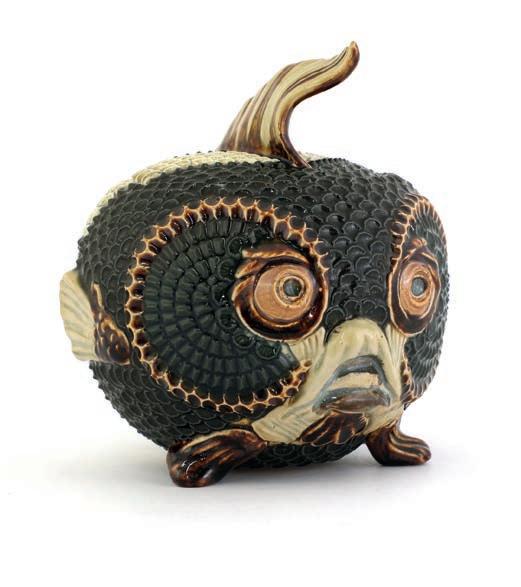
Left Florence Barlow (18551909) a Doulton Lambeth stoneware vase with pâte-sur-pâte birds on branches, incised to the rim with artist’s monograms and numbered ‘327’, impressed mark to the centre of the base, 45cm. It has an estimate of £300-£500 at this month’s sale

the technique. Pâte-sur-pâte, a French term meaning “paste on paste”, is a method of decorating one body with another of a di erent tint. e body (or paste) was mixed with pigment (18 di erent colours or tints were available) and applied with a brush, creating a slightly raised e ect. Hannah’s work is incised with an HBB monogram usually followed by the year it was made, while Florence used FEB and the date, in both cases with the Doulton Lambeth mark nearby.
It was agreed between the sisters that Florence would do birds while Hannah would con ne herself to the rest of the animal kingdom. Hannah’s depictions of horses and cattle proved to be the most proli c. Aside from the domestic farm animals, Hannah was inspired by many di erent living creatures, with a kangaroo appearing in 1878 on a tea service possibly inspired during preparations for the Sydney International Exhibition in 1879.
Above left Hannah Barlow (1851-1916) a Doulton Lambeth stoneware vase, 1878, featuring donkeys, geese and a girl, incised with artists’ monograms, impressed marks, numbered ‘223’ and dated ‘1878’, 42.5cm high. It has an estimate of £400-£600
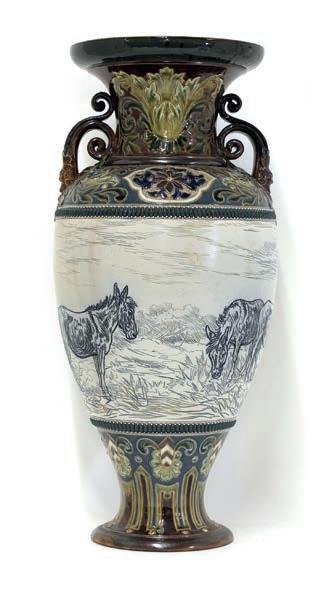
Above Hannah Barlow (1851-1916) and Florence Barlow (1855-1909) a Doulton Lambeth stoneware ewer, with a dog and two panels of a heron and spring owers, with artists’ monograms, impressed marks and numbers, 26.5cm high. It has an estimate of £150-£200
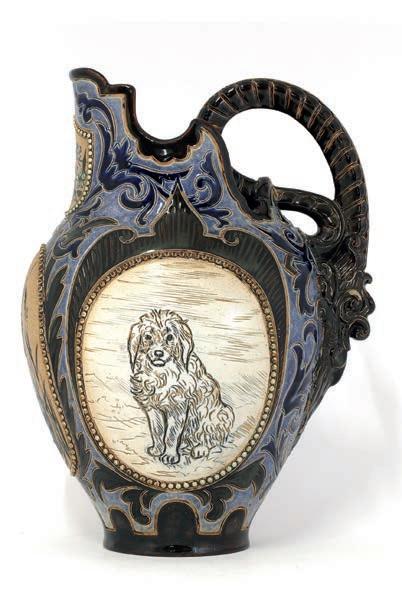
In the four years from 1871 to 1874 Hannah and Florence designed 9,000 di erent pots – on occasions Hannah being known to decorate 20 pieces a day. When rheumatism struck her right hand, leaving it partially paralysed, she trained herself to use her left hand with little or no loss of quality.
Nowadays the work of Hannah and Florence is rather overshadowed that of their brother Arthur who also joined the rm. Arthur su ered an injury to his right hip when he was 13 leaving him with limited mobility. Another pupil at the Lambeth School of Art, John Sparks, said of him that “his good taste and perfect mechanical ingenuity have carried his art into elds of decoration of unexpected beauty.” His style di ered greatly from that of his sisters.
Developing a particular talent for organic, plant-like forms. Arthur Barlow died in 1879 at the age of 34, so his signed work is much rarer than that of his sisters, although not necessarily more valuable.
For a short period from 1882 to 1885 a fourth Barlow sibling, Lucy, came to work in Lambeth as a decorator, working mainly on the pots
Left Florence Barlow (18551909) a Doulton Lambeth stoneware vase, with pâtesur-pâte birds, incised artist’s monogram, impressed marks and numbered, 57.5cm high. It has an estimate of £300-£500
Right Mark V Marshall (1843-1919) a Doulton Lambeth gural stoneware jar and cover, modelled as a blow sh, incised with artist’s monogram and with impressed marks, 15.5cm high. It has an estimate of £400-£600
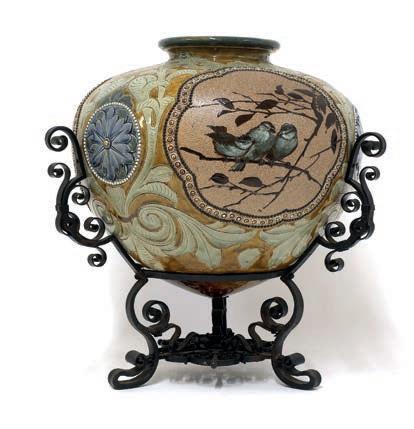
produced by her sisters, adding borders and other details to o set their bird and animal studies. Lucy, considerably less talented than her brother or sisters, left to keep house for Hannah and Florence, now well established and, presumably making a reasonably good living, and this arrangement continued for the rest of their lives.
In 1872, the trio of Tinworth, Arthur and Hannah Barlow was joined by another student from the Lambeth School of Art, a deaf and almost mute potter called Frank Butler. Butler, who decorated this vase, was one of Doulton’s longest serving employees, spending nearly 40 years at the rm, during which time he produced many thousands of vases, jugs, bowls and other pots. In the well-worn path, it was John Sparkes who introduced Butler to Doulton where his creative talent ourished, becoming known for his originality of designs that re ected changing styles from Victorian up to and beyond art nouveau. Butler worked at Doulton’s for almost 40 years from 1872 to 1911. Today his oral work and irregular-shaped vases are highly prized.

e rst part of the Ann Turner collection of Doulton pottery will be auctioned at Sworders in Stansted Mount tchet on May 16, for more details go to www.sworder.co.uk
Right Mark V Marshall (1843-1919) a Doulton Lambeth stoneware bowl, modelled as a sh, incised with artist’s monogram, with impressed marks, 19cm wide. It has an estimate of £300-500
Left Frank Butler a Doulton Lambeth stoneware vase and cover, 1883, incised with artists’ monograms, impressed marks, numbered ‘581’ and dated ‘1883’, 53cm high. It has an estimate of £300-£500
Below left A pair of Doulton Lambeth stoneware jardinières, 1877, with a band of ducks to the rim, impressed marks and dated ‘1877’. e pair has an estimate of £150£250
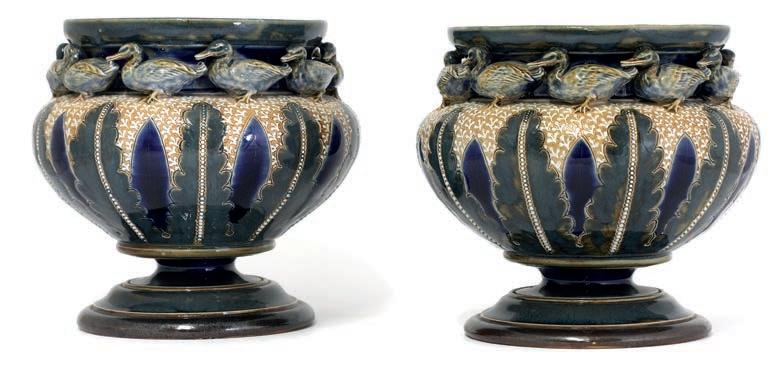
Below right A Doulton Lambeth stoneware jar and cover, modelled as an owl, the cover as its head, impressed marks, 20cm high. It has an estimate of £400-£600
School of Art who worked at Doulton from 18781912, producing some of the factory’s most creative models.
Before joining Doulton, Marshall had been a stone carver working on Victorian gothic revival churches. He had also worked for a time with the Martin Brothers, where he may have developed his particular talent for modelling animals both as whimsical figurines and as relief decoration on vases and other shapes.
He went on to become known for his depictions of lizards, dragons and mythical creatures trailing around vases or resting on rocks. Marshall’s work is some of the boldest and most exuberant ever produced of the Doulton Art Pottery. Doulton stoneware by Mark Marshall is almost always signed M.V.M.

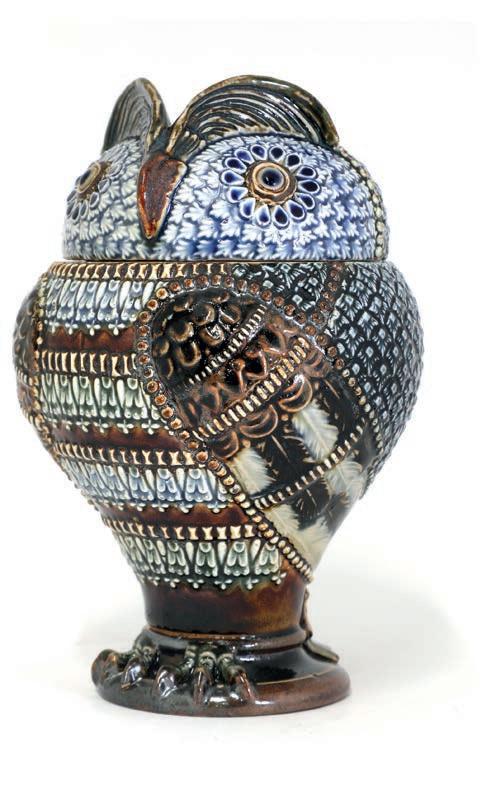
From interior designers to Hollywood stars, Guinevere, the long-established antiques shop at the heart of the King’s Road is nothing short of a go-to resource. Its celebrated window designs have been praised by Gwyneth Paltrow, while the Italian fashion designer Valentino, when asked by the Evening Standard to reveal the shops on his “secret” address book, replied: “For gifts, I like Guinevere Antiques on the King’s Road.”
After 60 years in business, Marc Weaver, son of Guinevere Weaver who founded the business, said: “We are looking at a restructure. e properties at King’s Road are currently on the market. ere will be a shift in our business but there will de nitely be an increase in online.” Part of the restructure sees a number of lots from from the store go under the hammer at Dreweatts.
It marks the end of an era at one of London’s most loved dealers on the King’s Road, with the sale being the last chance to shop at Guinevere in the old-fashioned way.
Above Guinevere presents a mini Grand Tour for collectors
Above right A rare wool and silk historic tapestry depicting a scene from the life of Hannibal, estimated at £15,000£25,000

Below A pair of silvered and lacquered leaf chairs by Joy de Rohan Chabot, estimated £1,200-£1,800
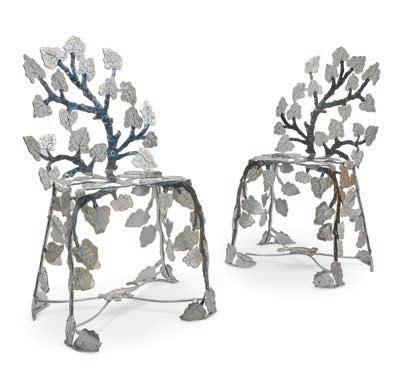
Right A Victorian silver plate novelty cruet set by Gotscher & Co. Birmingham, estimated at £150-£250
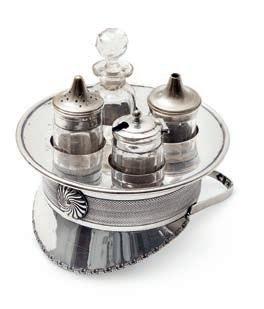
Guinevere was founded in 1963 by the French-born Genevieve Weaver. Having trained as a hat designer in Paris in the 1950s, she moved to London and started a family. At the same time she became interested in antiques opening the dealership at 574-580 King’s Road, in what was then, the disreputable end of the famous Kings Road, Chelsea. Since then the area has become known for its art galleries, smart restaurants and interiors shops.
Her philosophy was to mix di erent styles and eras of furniture together – ancient and modern, East and West. e style is continued by Genevieve’s sons, Kevin and Marc Weaver who now run the business with the same air for combining styles of furniture and objects.
Currently Guinevere consists of four adjoining shops (and windows) on the King’s Road, and has an international, loyal following of private collectors and the world’s best interior designers.
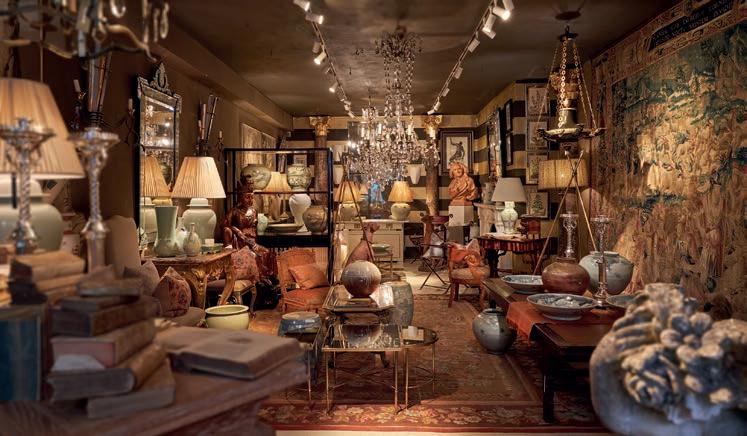
Among the highlights in the sale is an Italian marquetry inlaid vellum sideboard by Italian designers Giuseppe Anzani and Paolo Bu a. Anzani and Bu a collaborated on many commissions from the 1930s to the 1950s working with architects and artists to produce inlaid panels to be mounted on furniture. In the piece on sale, dated 1941, the panels depict cupid-like gures in chariots.
Another sought-after piece is a pair of French silvered and gilded bronze Pompeiian tripod torchères, attributed to the French sculptor Ferdinand Barbedienne (18101892). Barbedienne was one of the most signi cant casters of bronze works of the late 19th century and the founder of one of the most important artistic foundries of the period. His business evolved into the creation of domestic works in bronze and other metals for the home, as well as huge

is month sees an end-of-an-era sale of treasures from one of the King’s Road’s destination antiquesAbove Italian marquetry inlaid vellum sideboard by Italian designers Giuseppe Anzani and Paolo Bu a, it has an estimate of £7,000-£10,000
public commissions for which he was awarded several prestigious honours.

Also on sale is a set of four ‘en-grisaille’ oil paintings of winged putti representing the arts in the manner of Belgian artist Piat Joseph Sauvage (1744-1818) .
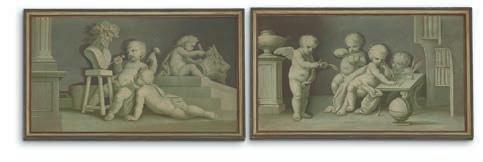
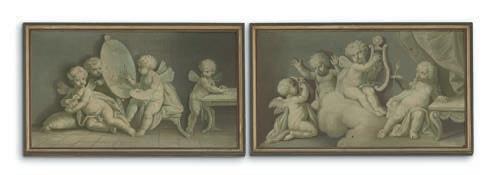
‘En-grisaille’ is a historic technique of painting in neutral shades to imitate sculpture. It was usually used in large decorative schemes and was a stunning art form in its own right.
Early known examples date back to the 13th century and some are still used today, with a wider colour palette. Sauvage was a master in the art form, undertaking a numer of royal and public commissions.
AUCTION fact file
Where: Dreweatts, Donnington Priory, Newbury, Berkshire RG14 2JE
When: May 23, 10.30am
Viewing: Online at www.dreweatts.com
IN MY OPINION...
Have you got a favourite lot?
Guinevere’s current four shops now occupy more than 7500 sq ft. so it really is extremely difficult to pick just one thing. But my favourite piece would have to be the Hannibal tapestry. It is made from wool and silk and would exude warmth in any interior while creating a great atmosphere. At the opposite end of the price range I adore the novelty cruet set by Gotscher & Co. with the silver mark of a bull for Birmingham. It is a charming four-piece set and would be a great addition to the dining table plus, with an estimate of £150-£250, it wouldn’t break the bank.
Where are you expecting interest to come from?
Far left A pair of French silvered and gilded bronze Pompeiian tripod torchères, c. 1890, attributed to the French sculptor Ferdinand Barbedienne (18101892), estimated at £5,000-£8,000
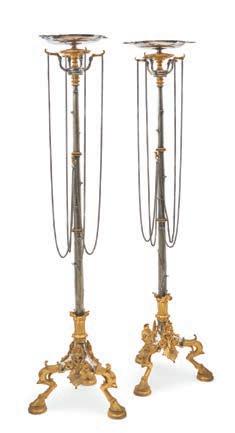
Left A 19th-century Chinese powder blue rectangular section gilt metal ‘gu’ vase mounted by Escalier de Cristal in Paris, estimated at £800£1,200.
Below left A pair of 20th-century Italian glazed pottery models of leopards, estimate at £3,000-£5,000
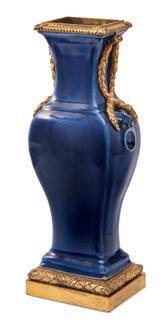

As well as being a ‘go to’ for interior designers Guinevere has always attracted private clients looking to furnish their home or find a gem.
Because of this we are expecting a lot of interest from interiors specialists, but the diversity of pieces on offer is bound to attract collectors. The shop has always boasted a global following so there are sure to bidders from across the world.
Do you have any personal memories of the shop?
As you enter the premises you wander through expansive galleries on a mini ‘Grand Tour’, with rooms arranged as settings for dinner, drinks, relaxing or entertaining. The arrangements also change regularly, so you never have the same journey twice.
The shop’s awe-inspiring settings speak for themselves, taking you on a foreign journey through various continents and history.
How would you sum it up?
The main draw was the range of extraordinary finds sourced on Genevieve’s travels around the world. These rare and sometimes oneoff pieces were a thrilling find to a London clientele and cemented her reputation as a tastemaker who continually set new trends and broke boundaries – something the company prides itself on continuing.
‘The shop specialises in carefully chosen works including rare furniture, textiles, lighting, decorative works of art, and curious antique pieces, as well as contemporary works considered out of the ordinary’
For generations Guinevere has been at the centre of London’s famous international antiques and interior design world. Famed for their fusion of cultural influences from around the world and range of periods, from antiquity to modern and contemporary, they have a amassed a truly global client base.
Above left A set of four ‘en-grisaille’ oil paintings of winged putti representing the arts in the manner of Piat Joseph Sauvage (1744-1818), it has an estimate £3,000-£5,000 in this month’s sale
Often embellished with symbols and traditions, marriage portraits provide us with a tantalising glimpse of centuries-old alliances and the central role marriage played in the complex politics of the 15th and 16th centuries.
Auspicious unions were a vital part of political life in 15th and 16th-century Europe, with the Holy Roman Empire, France, and England constantly vying to gain international prominence. ey were also an integral part of the shifting ties between Italy’s rival city states, at a time when the country itself was the sparring ground for its competing neighbours. Even though they were at an early age, portraits of children as possible future spouses were circulated among the small group of powerful rulers.
Portraits of eligible women (and men) were equally in demand by would-be matchmakers. Artists called on to record a likeness had to steer a safe course between accuracy and pleasing a potential spouse. When Henry VIII met Anne of Cleves in the esh, after seeing Holbein’s portrait of her apparently he was so disappointed it led to divorce.

When it came to the ceremony itself, unlike today’s church or registry o ce, the rituals of marriage varied regionally, were multifarious and depended on lawyers and
Above Hans Burgkmair (1473-1531) Marriage
Portrait of Jakob Fugger and Sybilla Artzt, Schroder Collection, Holburne Museum
Top right Antonio di Puccio Pisanello, (13951455) marriage medal of Lionello d’Este, signed and dated 1444, bronze, diameter 10.3cm, Victoria and Albert Museum
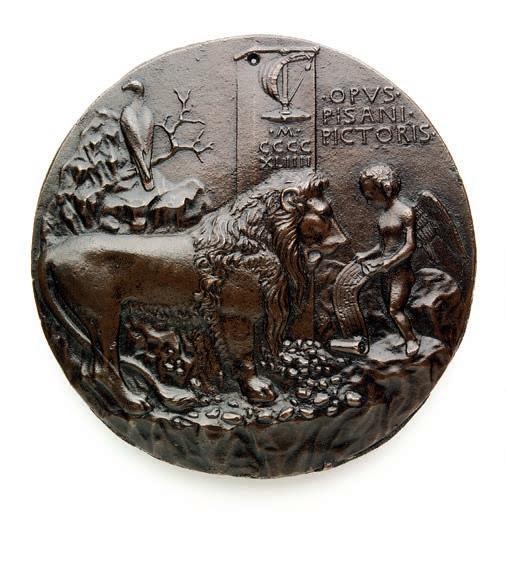
Above right Giovanni da Oriolo (d. 1474) Leonello d’Este, 1447, egg tempera on wood, National Gallery, London

immediate families more than the Church, or State.
A starting point for the exhibition is the double portrait of Jakob Fugger and Sybille Artzt, by Hans Burgkmair (14731531) to mark the couple’s marriage. Neither party looks particularly thrilled at the union – despite the groom being known as ‘Fugger the Rich’, – the Augsburg merchant was the major nancial force behind the Habsburg empire.
e painting not only re ects the solemnity of matrimony, in it the couple is presented as if at a window,like royalty showing themselves to the people. e purpose was to e ectively publicise the marriage and therefore act as a form of validation. It is also, in some ways, the precursor to wedding photographs.
While his arm interlinked through hers may be seen as an act of tenderness, it can also be viewed as one of possession. ere is the customary age gap between groom and bride – he is 39 and she 18. Similarly, with modern weddings often being a form of show, the Fuggers are displaying their wealth. Sybille is wearing a jewelled headdress, while Jakob wears his trademark Venetian-style cap of gold.
As well as portraits, Renaissance medals commemorated individuals or events, including weddings. ey were used as gifts and mementoes and were similarly inspired by Roman coins, with their portraits of rulers and allegorical representations on the reverse.
e medal above marks the marriage of Leonello d‘Este,(1407-1450), the marquis of Ferrara, one of the wealthiest and most cultured city-states in northern Italy, to Mary of Aragon, daughter of King Alfonso V of Naples, in 1444. It shows Leonello in pro le on the obverse and an allegory of the marriage on the reverse.
e loan of Renaissance marriage portraits to Bath’s Holburne Museum has sparked an exhibition on 15th and 16th-century nuptials. Art historian Lucy Whitaker reveals what it can tell collectors
A similar pose was used by the Florentine artist Alesso Baldovinetti (1427-1499) for his marriage portrait of e Lady in Yellow (right). e association with Roman coins and medals, signals high social rank. It is the sitter’s virtue and the prestige of the family she would marry into, rather than her personal identity, that is important.
As was customary at this date the groom’s family was responsible for dressing the bride and her ne jewels and fabrics show o his family’s wealth and status. e cost of these items, as well as the commemoration of the marriage alliance, justi ed the expense of commissioning a portrait. e skill of the artist and the beauty of the bride would further enhance the family’s reputation.
e perfect white pearls at her neck and the cluster on her head symbolise her purity. Prominently displayed on the woman’s sleeve are the groom’s coat of arms, emphasising that this woman is now a member of his household.
Luxury tableware used at the wedding feast was also an opprtunity to showcase a family’s wealth. After the ceremony, a marriage or wager cup, would have toasted the union.
e double drinking vessel has a skirt-shaped large cup for the groom and a smaller swivel cup for the bride. e contents were to be consumed at the same time, without spilling a drop, intended to bring prosperity to the marriage.
Left Alesso Baldovinetti (1427-1499) Portrait of a Lady in Yellow, c.1465, tempera and oil on wood, National Gallery, London
Right Bartolomeo Veneto (1502-1555)
Portrait of a Young Lady, c. 1500-10, oil on wood, National Gallery, London
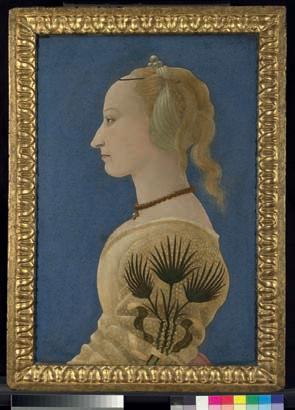
Below left A German silver and silver-gilt wager cup has an estimate of €8,000€12,000 at Bonhams Paris sale on April 19, image courtesy of Bonhams (not in exhibition)
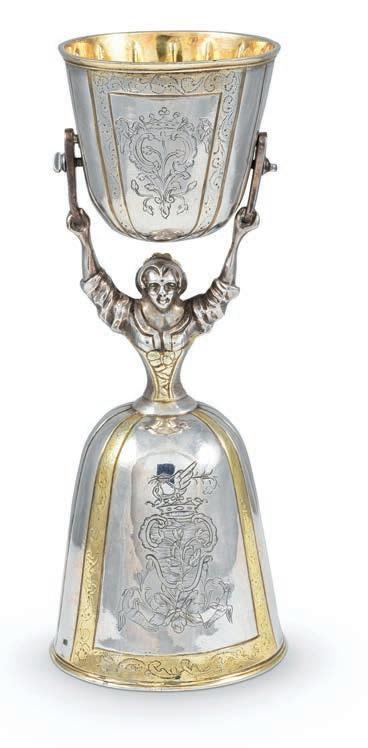
Below right A gimmel ring, southern German, second half 16th century, image courtesy of the Metropolitan Museum of Art (not in exhibition)

Gifts, often jewels, from groom to future bride featured largely in 15th-century marriages. In Italy a formal ring ceremony, the anellamento, usually took place at the bride’s home before she would be led to her husband’s home in a great procession with chests containing her trousseau and gifts.
In England marriages could take place in church but they were, as in the rest of Europe, a personal matter. However, after Henry VIII’s split from Rome and the establishment of the Church of England the new national church began to promote its own laws on religion and marriage and exert more authority over marriage.
Rings were exchanged during courtship including English posy rings and English and Italian fede and gimmel rings, most inscribed with appropriate mottos or sayings such as, As hands be shvt so sewerly knyt (as hands be shut, so surely knit).
Fede rings usually took the ancient form of two clasped hands, fede meaning faith while gimmel rings featured two intertwined hoops or halves – the word gimmel coming from the Latin word gemellus, a twin.
Other wedding gifts might include a necklace similar to the one worn by the young women in the portrait by Bartolomeo Veneto (above). In it hexagonal beads are decorated with symbols and letters that probably form parts of words from a prayer or a religious text. The presence of such costly, yet devotional, beads suggests the portrait was linked to a marriage contract and served to confirm the piety and virtue of the sitter. A woman’s personal adornment was
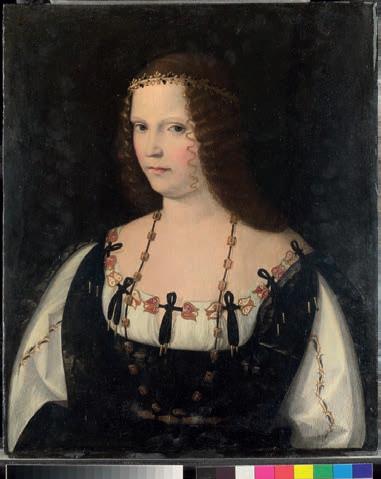
‘As was customary in the 15th century the groom’s family was responsible for dressing the bride and her fine jewels and fabrics show off his family’s wealth and status. The cost of these items, as well as the commemoration of the marriage alliance, justified the expense of commissioning a portrait’
of love between two people that continues to fascinate us. Miniatures of loved ones were cherished and always kept close at hand, if not worn. The exhibition includes a pair of portraits by Nicolas Hilliard (1547-1619) of Elizabeth I and Robert Dudley, Earl of Leicester (1532-1588).

e fashion for majolica plates featuring images of beautiful women is another example of the preoccupation with ideal beauty and relates to the search for an exemplary marriage partner.
Love was a major iconographic theme in the decoration of majolica. Besides the amorous themes from myth and legend, there exist numerous plates painted with the idealised portrait of a woman, often accompanied by her name.
Known as belle donne (beautiful women) plates, these have usually been interpreted as tokens of love relating to courtship and marriage, and re ect the concerns with courtly standards of beauty, believed to be an outward show of inner virtue, found in contemporary treatises. In this example both a man and woman are depicted. Behind the pair runs the motto DULCE EST AMARE (sweet is love).

Above Giacomo Mancini, tazza, c.1550, Deruta, Italy, tin-glazed earthenware, Victoria and Albert Museum
Below left Nicolas Hilliard (1547-1619)
Queen Elizabeth I, c.1595-1600, watercolour on vellum, 65mm x 53mm, Victoria and Albert Museum
Below Nicholas Hilliard (1547-1619) Robert Dudley Earl of Leicester, 1571, watercolour on vellum, 4.4cm, Victoria and Albert Museum
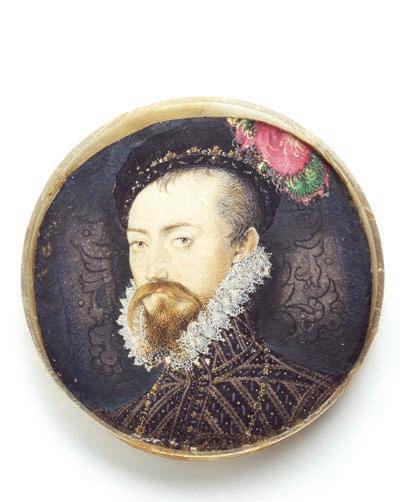
From the start of the reign of Elizabeth I (15331603), the question arose about her potential husband. She had many suitors, including Philip II of Spain (1527-1598), Erik VIX of Sweden (1533-1577), and, closer to home, Robert Dudley, Earl of Leicester (1532-1588). Yet she never took a husband, regardless of mounting political pressure to produce an heir.



Despite Dudley being already married – as a teenager, he had wed Amy Robsart the daughter of a Norfolk squire – he and Elizabeth spent almost all their time together and were said to have a “secret understanding” to marry in the event of Dudley’s wife being “sent into eternity”.
When Amy died suddenly in 1560, many people believed that Dudley had arranged for his wife to be murdered in order to free himself to marry Elizabeth. Dudley was almost certainly innocent but the cloud of suspicion hanging over him meant for Elizabeth to accept him may have cost her the throne.
At the time of the portrait in 1571 Dudley had not yet given up hope of marrying but was starting to look for love elsewhere.
By 1575 he was in a secret relationship with his future wife Lettice Knollys, to which Elizabeth reacted with immense jealousy. Did Dudley commission the portrait as a gift for Elizabeth as part of this final effort to secure the Queen’s hand?
It is evident their’s was a lasting relationship. Famously one of the letters, written just six days before Dudley’s death, was kept by the Queen as a treasured possession until her own death, when it was found in a casket by her bed.


‘The bride often carried a carnation on her wedding day. According to folklore the flower could be concealed on her person to be found later by the groom’
Marriage was an essential tool in maintaining and strengthening royal houses in the Tudor period. One such was the dynastic marriage of Louis XII to Henry VIII’s sister, Mary Tudor on October 9, 1514, e French portraitist Jean Perréal (c.1455-c.1530) was sent to England as part of the marriage negotiations, to help ensure Mary’s wedding apparel conformed to French taste and perhaps to paint her portrait. It seems most likely that he brought his portrait of Louis XII with him Mary Tudor, more than 30 years younger than Louis had been unhappy with her upcoming nuptials as she was almost certainly already in love with Charles Brandon, 1st Duke of Su olk. She agreed to the match on the understanding that on Louis’ death she would be allowed to wed the man of her choice, which she eventually did, marrying Su olk in Paris after Louis died in 1515.
Painted Love: Renaissance Marriage Portraits is on at e Holburne Museum, Bath, from May 26 to October 1.
Above Workshop of Jean Perréal (d. 1530) Portrait of Louis XII, c.1510-1514, Royal Collection Trust
Above right Hans Holbein the Younger (1497-1543) Mrs Jane Small, formerly Mrs Pemberton, c.1536, watercolour on vellum in decorated case, diameter 52mm, Victoria and Albert Museum
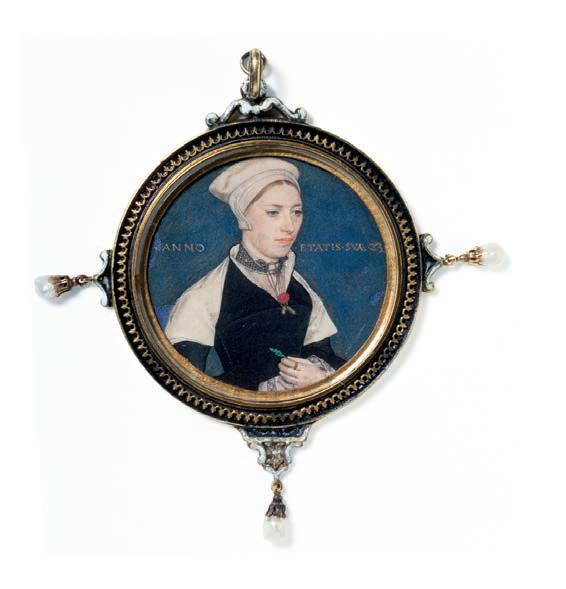
Right Andrea Solario (1460-1524) A Man with a Pink, c. 1495, oil and egg on poplar, National Gallery, London.
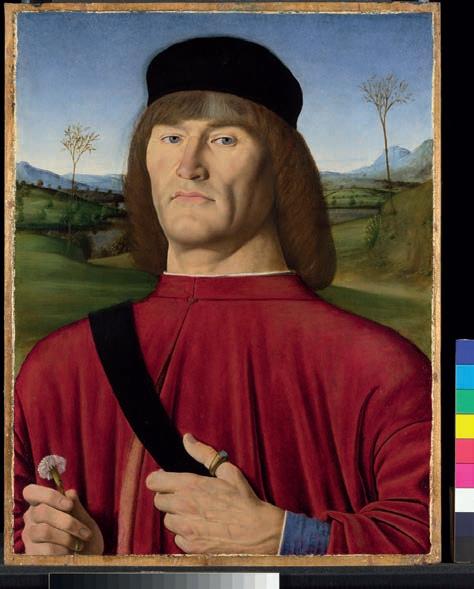
Because of its bright red colour, the carnation is usually depicted as a symbol of love. The Greek name for carnation, dianthos, means “flower of God” and they were popular motifs in northern Italian Renaissance painting. A bride often carried a pink, the carnation’s relative, on her wedding day. According to folklore, the flower could also be concealed somewhere on her person, to be found later by the groom.
One of the emblems worn by Jane Small in the miniature portrait by Hans Holbein (above) is a red carnation which probably refers to her betrothal to the prosperous London merchant, Nicholas Small, in about 1540.

In Andrea Solario’s portrait (below) a man carries a pink, or carnation, in his right hand. Its presence here, along with the large blue and gold ring on the man’s left thumb, suggests that the portrait commemorates his marriage.
Although the man’s identity is unknown, his outfit tells us he was a Venetian of high rank. The cap and stole – the piece of fabric folded across his chest – signified maturity in Venice. His tunic suggests he may have been a magistrate, as only members of one of the city’s councils were permitted to wear red.


Left Queen Elizabeth II on her coronation day, by Cecil Beaton, Royal Collection, image Public Domain
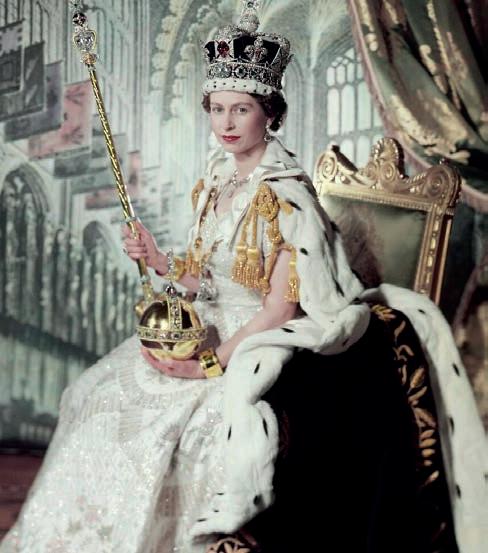
Right e lot comes with royal dressmaker Norman Hartnell’s handwritten notes
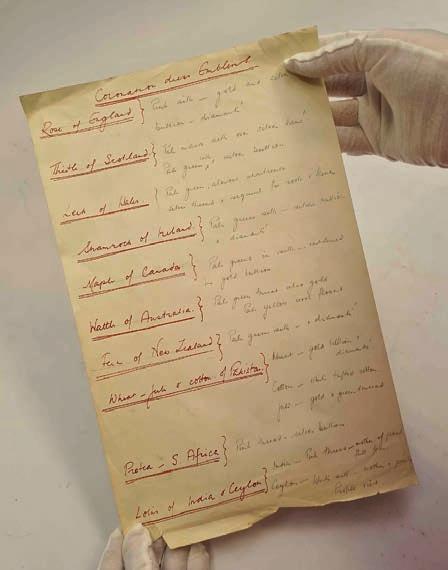
Below e embroidery depicts the emblems of the four home nations and the Commonwealth, in silver and gold thread, diamante, silver bullion and mother-of-pearl

death in 1979. Hartnell made her wedding gown, and she called upon his skills again to create her white satin coronation dress in similar form.
It is thanks to Hartnell’s kindness that this fragment has been saved for posterity. e seller’s late aunt worked as a PA for the designer for 43 years. Hartnell gave her the embroidery.
When the Queen invited him to design her coronation dress in late 1952 it sparked eight months of painstaking hard work as he grappled with research, design ideas and workmanship to make its intricate embroidery.
On the eve of the crowning of Charles III, an exquisite piece of oral embroidery made for Elizabeth II’s coronation dress could sell for thousands at auction, and I am so proud to be able to o er it. e 70-year-old framed sample was created during the design process for one of the most important dresses of all time and depicts the emblems of the four home nations and the Commonwealth, in silver and gold thread, diamante, silver bullion and mother-of-pearl.
It comes with handwritten notes titled ‘Coronation dress emblems’, detailing the colours and materials for each emblem.


Her exquisite gown was created by Norman Hartnell (1901-1979), a leading British fashion designer best known for his work for the royal family. Hartnell was Queen Elizabeth II’s dressmaker from the mid-1930s until his
He produced nine designs in total and, along the way, examples of decorative embroidery were made for the Queen to approve. She wanted her dress to honour the nation she served so emblems of Great Britain were created. However, the Commonwealth could not be forgotten either. Consequently, embroidery was made featuring owers of the Commonwealth with the Tudor Rose at its centre. Hartnell’s hard work paid o because the Queen liked her coronation dress so much she wore it six more times, one event being the Opening of Parliament in New Zealand and Australia in 1954. For any admirer of our late Queen, I can’t think of a more touching royal memento to cherish.
e embroidery will be o ered at Hansons Auctioneers’ Monarchs and Majesty auction on May 16 with a guide price of £1,500-£2,000.
On the eve of a royal milestone, Charles Hanson comes across an embroidery sample made for the coronation gown of Elizabeth II
‘It’s a remarkable piece of royal memorabilia made to mark one of the most important British occasions in the 20th century, a milestone day for the monarchy and the first televised coronation’
A fine Chinese pink ground famille rose vase, Jiaqing seal mark and probably of the period


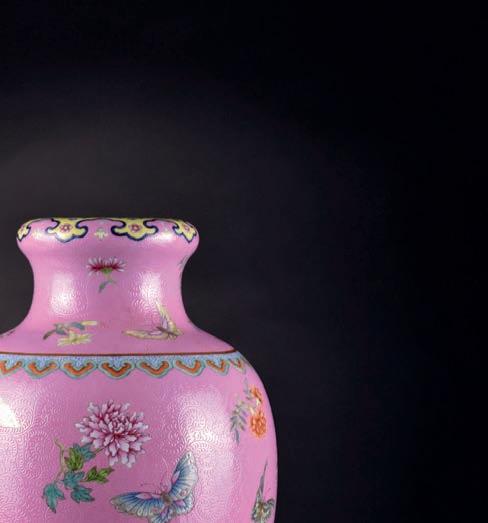






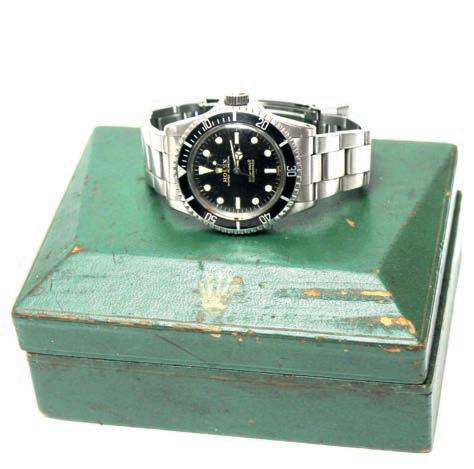
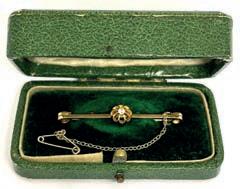

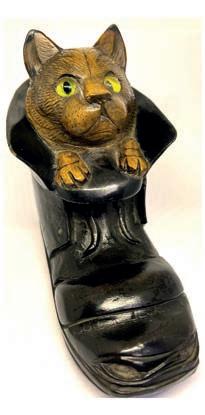
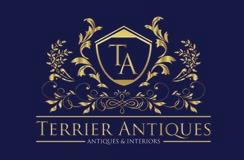
is year sees the 400th anniversary of what many regard as the most important book ever published: the single volume compilation of Shakespeare’s works now known as the First Folio. Book specialist Adam
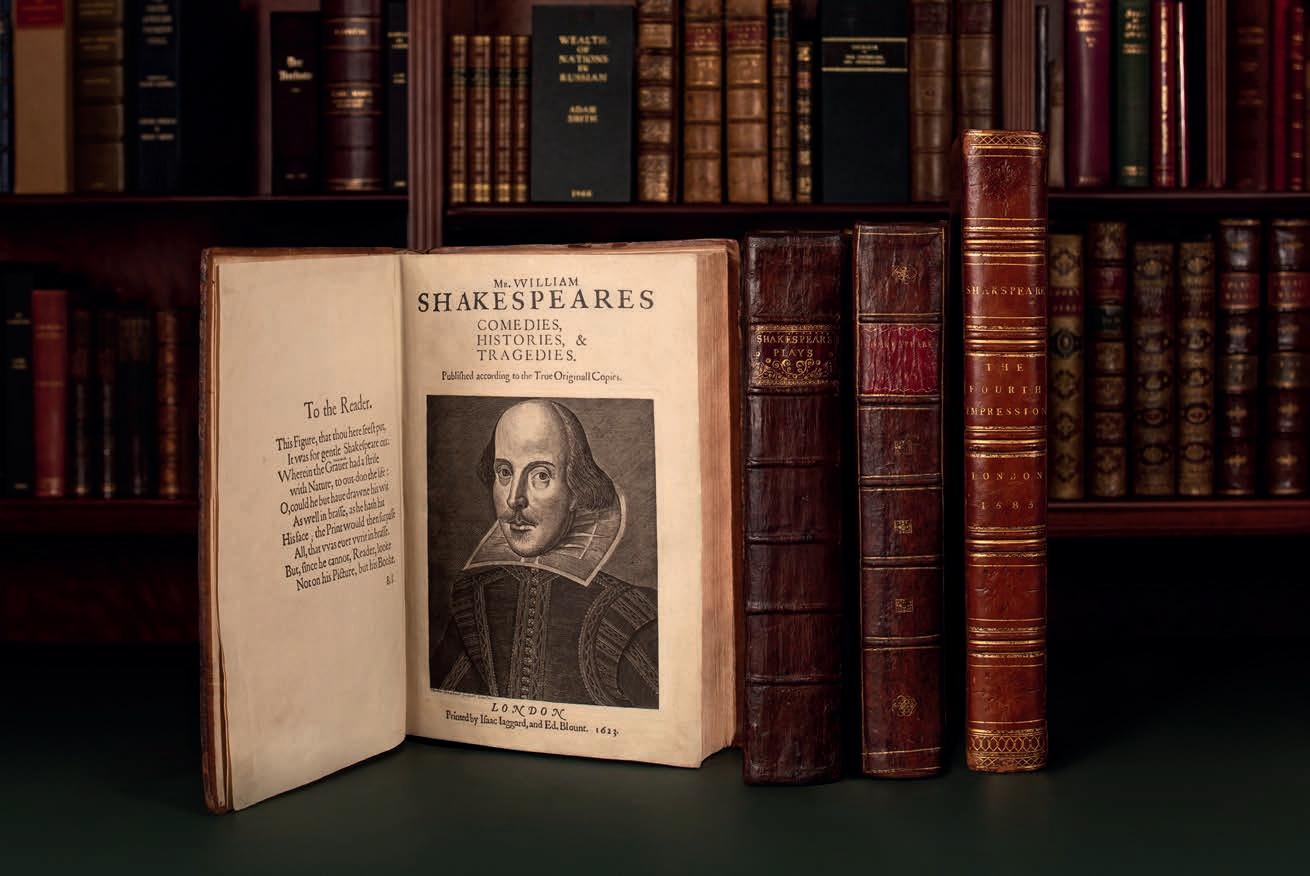
The rst recorded buyer of the First Folio was Edward Dering, an English antiquary, who made an entry in his account book on December 5, 1623, recording his purchase of two copies for a total of £2. Today of the estimated 750 First Folios printed, 228 are currently known to survive worldwide. If you want to own one expect a price tag in the millions of pounds.
So what makes the First Folio remarkable? Well, it was the rst book solely dedicated to printed plays ever to be published in the prestigious folio format– the imposing size usually reserved for books such as Bibles or collections of sermons. If it were only that, it would have made it merely a curiosity in literary history.
Above Peter Harrington is o ering all four of Shakespeare’s folios and a copy of his rst collected edition of poems, all images unless otherwise stated courtesy of Peter Harrington
e First Folio’s real importance rests on the fact that it contains 36 plays by William Shakespeare, half of which had never been published before. In Shakespeare’s day, plays were written to be performed, and rarely printed – and as a result many were lost. Without the First Folio, 18 of Shakespeare’s plays would have been lost forever, including some of his most loved and well-known works such as As You Like It, Twelfth Night, Macbeth, Julius Caesar and e Tempest.
It’s sometimes argued that these immortal plays would have made it into print eventually, but without the First Folio, it’s unlikely anyone would have had much incentive to publish them. e unpublished plays were the property of Shakespeare’s theatrical company, the King’s Men, with manuscripts in the possession of Shakespeare’s two fellow company members and friends, John Heminge and Henry Condell. ey gathered, collated and published the materials in 1623, seven years after their friend’s death, by which time most of Shakespeare’s plays had fallen out of the repertoire.
Were it not for the First Folio, the scattered papers would have been worthless. With its great heft and imposing appearance, the First Folio established the Shakespearean canon for all time.
In book form, the ephemeral plays found a new lease of life. e First Folio was reprinted in 1632, again in 1663, and in 1685, the four Shakespeare folios spanning the
century, eclipsing the rival collections of Ben Jonson and Francis Beaumont and John Fletcher, the English dramatists who collaborated in their writing during the reign of James I (1603–1625).
Shakespeare was the only dramatist to achieve four folio editions in the 17th century, so the publication of the four editions in relatively quick succession set the seal of distinction on Shakespeare’s reputation as England’s foremost playwright.
Shakespeare’s Elizabethan and Jacobean plays, already a little old-fashioned in 1623, were among the rst to be revived in the Restoration, when the theatres reopened for business after the enforced darkness of the puritanical Commonwealth. ey have continued to be performed ever since.
We know more about the publication history of the First Folio than any other single edition of its era, not excepting the Gutenberg Bible. Of the surviving copies most are
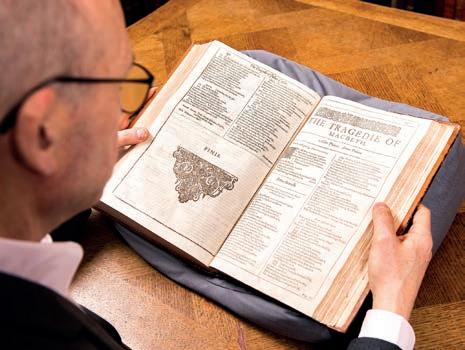
Left One of the rare First Folios which had an original edition size of 750
Right e Chandos

Portrait of William Shakespeare, painted between 1600 and 1610, image Public Domain

Below right Martin Droeshout’s engraved portrait of Shakespeare shows similarities with the oil painting, image Public Domain
Below Spotlight on Hamlet in the First Folio
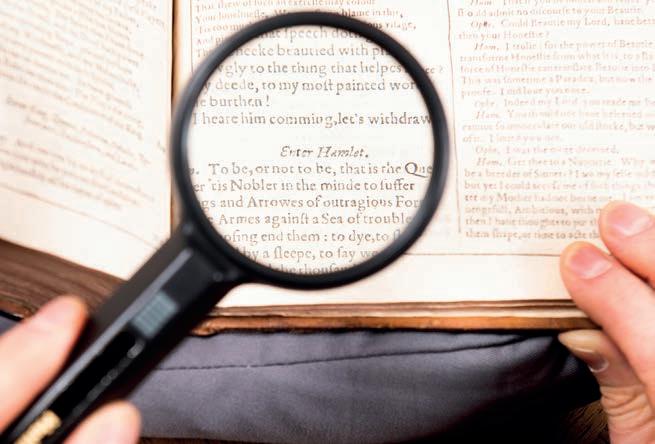

Despite Ben Jonson’s famous line in the opening pages of the First Folio, which entreats readers to “Looke not on his picture, but his Booke”, one crucial element in the First Folio’s success was the striking engraved portrait of Shakespeare on the title page. Not many realise it was the same copperplate used for all four folios.
It is thought to have been based on the oil painting known as the Chandos portrait, the most famous depiction of the playwright.

The painting dates from 1600 to1610 and is named after the 3rd Duke of Chandos, who formerly owned the painting. It was given to the National Portrait Gallery on its foundation in 1856, and it is listed as the first work in its collection.
The ubiquitous portrait that appears on the First Folio was by Martin Droeshout (1601-1650) an English engraver of Flemish descent whose family migrated to England to avoid persecution for their Protestant beliefs. Without Droeshout’s engraving, we would have no visual reference for the most important writer in the English language.
missing some of their original leaves, with only about 56 copies complete, and many of those have been “made-up” with leaves supplied from other copies.
It was during the 19th century, when the First Folio became rmly established as a popular item with collectors, that many of these “improvements” were made, and when many an early calf binding was discarded and replaced with shiny red goatskin shimmering with gilt.
e most assiduous folio hunter of all time was the president of Standard Oil, Henry Clay Folger, who bought his rst First Folio in 1903 and whose Folger Shakespeare Library in Washington, DC, now has the world’s largest holdings, comprising 82 copies, of which 13 are complete.
e vast majority of First Folios are similarly housed in major libraries, universities, and other institutional holdings. Only 27 or so copies remain in private collectors’ hands, and only six of those are complete.
‘In Shakespeare’s day, plays were written to be performed, and rarely printed – and as a result many were lost. Without the First Folio, 18 of Shakespeare’s plays would have been lost forever’
Without Shakespeare’s plays, we would not have had such phrases as: we have seen better days; too much of a good thing; neither rhyme nor reason; I have not slept one wink; cruel to be kind; the clothes make the man; in my heart of hearts; own flesh and blood; eaten me out of house and home; a dish fit for the Gods; it’s Greek to me; sterner stuff; the be-all and the end-all; jealousy is the green-eyed monster; what’s done is done; foregone conclusion; wear my heart upon my sleeve; all that glitters isn’t gold; a blinking idiot; the world is my oyster; short shrift; a tower of strength; star-crossed lovers; wild-goose chase; break the ice.
We could stock an entire library with books that use snippets of Shakespeare for their titles, from Aldous Huxley’s Brave New World to racier fare like Alistair MacLean’s The Way to Dusty Death. Agatha Christie lifted three book titles from Shakespeare’s plays, Taken at the Flood, Sad Cypress, and By the Pricking of my Thumbs, and the title of her most enduring theatrical hit, The Mousetrap, from the play-within-a-play in Hamlet. The postmodernist doorstopper, Infinite Jest by David Foster Wallace, takes its title from the same play. As far as authors are concerned, Shakespeare’s infinite variety can never stale.
Complete copies of the First Folio emerge in commerce once in a generation. e rst complete copy of the 21st century was from the library of the Chicago collector, Abel E. Berland, sold at auction by Christie’s in New York, on October 9, 2001.

Known as the Canons Ashby copy and bound in early panelled calf, c.1690-1730, it had passed three times through the hands of the famous Philadelphia bookseller, Dr A. S. W. Rosenbach.
Like most complete First Folios, it was not perfect and had its title-leaf and two, possibly three, other leaves supplied from another copy. It sold for $6,166,000 to Paul G. Allen, co-founder of Microsoft.
Nearly 20 years later, the same auction house sold a complete First Folio that had been bequeathed to Mills College in Oakland, California, for $9,978,000. e relatively small price uplift over two decades re ects the truth that no two copies of the First Folio are strictly alike. is copy was bound in full blind-stamped russia in about 1810 and had been shown at the 1951 Festival of Britain Exhibition of Books.
Below
It had the rst leaf with Ben Jonson’s verse address “To the Reader” inlaid, a few letters on the title and a portion of the portrait restored, and the last leaf re-margined.
It was 15mm shorter than the copy bought by Paul Allen, having been trimmed very close at the top of the leaves, often removing the upper box-frames. ese factors were enough to keep it from breaking the $10m mark. Even so, it remains the most expensive work of literature ever auctioned.

Shakespeare’s primacy as the earliest and greatest writer in modern English has led to some unsupportable claims made for him.
It used to be argued that he was a preternaturally inventive wordsmith, with a huge number of original coinages attributed to him.
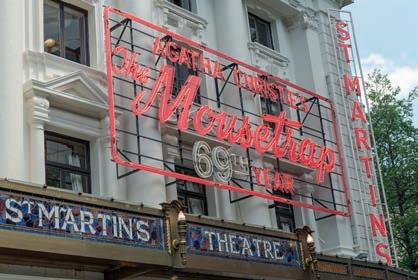
But he wouldn’t have been so popular in his lifetime if he couldn’t make himself understood to the general playgoer. What Shakespeare displayed was an extraordinary linguistic ability to redeploy parts of speech in unexpected contexts, a process of transference known as functional shift.
In Troilus and Cressida, for example, he describes how “Kingdom’d Achilles in commotion rages”, where he converts “kingdom” from a noun to an adjective. It’s the earliest instance of this usage recorded in the Oxford English Dictionary and just one of many such that we can assume to be Shakespearean creations.
Shakespeare may not have plucked new words out of thin air (a phrase rst found in e Tempest), but he had a special gift for combining words to create resonant phrases that made their way out of the First Folio into the English language. Only one other book, the King James Bible of 1611, has had such a profound and lasting in uence on the common stock of English phrases.

Adam Douglas is a senior specialist at Peter Harrington. e London-based book seller is the rst in living memory to o er all four of Shakespeare’s folios for sale at the same time, together with a copy of the Bard’s rst collected edition of poems. e ve books comprise all of Shakespeare’s collected works to be published in the 17th century and are listed at a combined value of £8.76m. Go to www.peterharrington.co.uk for more details.
A copy of the First Folio owned by Dulwich College is on show at the National Maritime Museum in Greenwich until September 24.
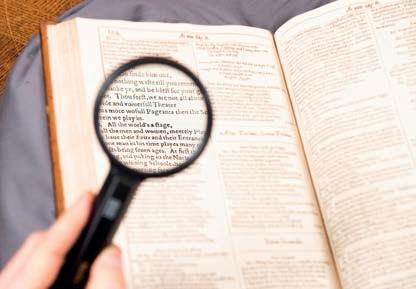
Emma Smith, professor of Shakespeare Studies at Hertford College, Oxford, will present a talk Shakespeare’s First Folio: from London to the World - and Leeds at Rupert Beckett Lecture Theatre, Leeds University on May 3.
The British Library is also to hold an exhibition this year on the First Folio. A feature film and a screenplay by Richard Bean and Clive Coleman is also in production. Two books, The Making of Shakespeare’s First Folio and Shakespeare’s First Folio: Four Centuries of an Iconic Book, both by Emma Smith are due out this year. For details on all the events go to www.folio400.com
Top right Comedies; Histories and Poems; Tragedies by William Shakespeare c.1920 £275
Middle right e Sonnets by William Shakespeare, illustrated by Eric Gill, edited by Margaret Flower (1933) £750
Above right e Tempest by William Shakespeare, illustrated by Arthur Rackham (1926) £900. First trade edition, rst impression.
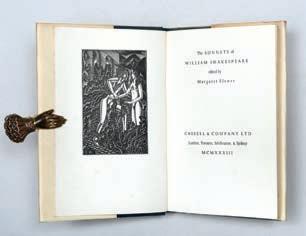
Left Look out for a host of events taking place around the country this year to celebrate the 400th anniversary
Right Hamlet’s iconic “To be, or not to be” as seen in the First Folio
If your collecting budget doesn’t quite stretch into the millions of pounds, there are more accessible and affordable ways to collect your favourite works by Shakespeare.
An attractively bound set of Shakespeare’s complete works, with three frontispiece portraits of the Bard by E. J. Sullivan (18691933) acclaimed by fellow artist A. S. Hartrick as “naturally the most gifted of the younger black-and-white artists of my time, not excepting Beardsley.” Sullivan’s illustrations first appeared in his 1911 edition of the author’s works.
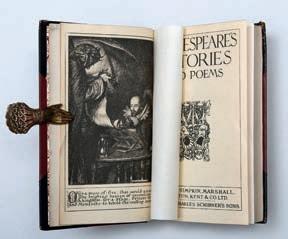
First Gill edition of The Sonnets of William Shakespeare, one of 500 copies only, handsomely printed and here retaining the scarce dust jacket. Eric Gill (1882-1940) was a British sculptor, engraver, typographic designer and writer. Typefaces he designed included Perpetua (1925) and Gill Sans Serif (1927).
A review of this edition of The Tempest, published in The Bystander on December 8, 1926, noted that it was “most exquisitely illustrated by Arthur Rackham, and some of the colour plates were the loveliest things of their kind that I have seen”.
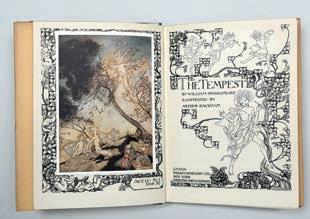
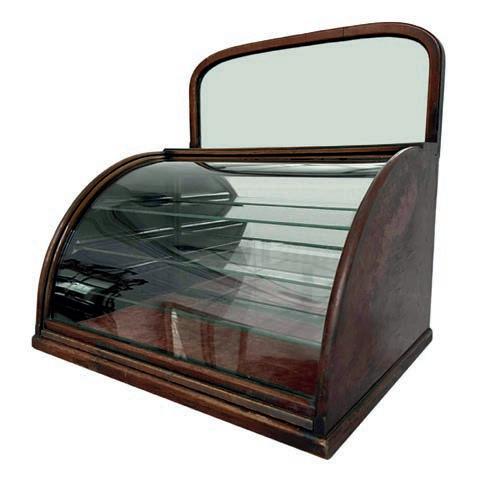
While today’s dwindling high streets are kept a oat with tanning salons and charity shops, a nostalgia for its elegant heyday is kept alive in our growing regard for its antique shop ttings.
At odds with the trend for internet shopping, when it comes to our choice of interiors it seems we want to recreate the golden age of shopping, largely viewed as being from Georgian period to the 1950s.
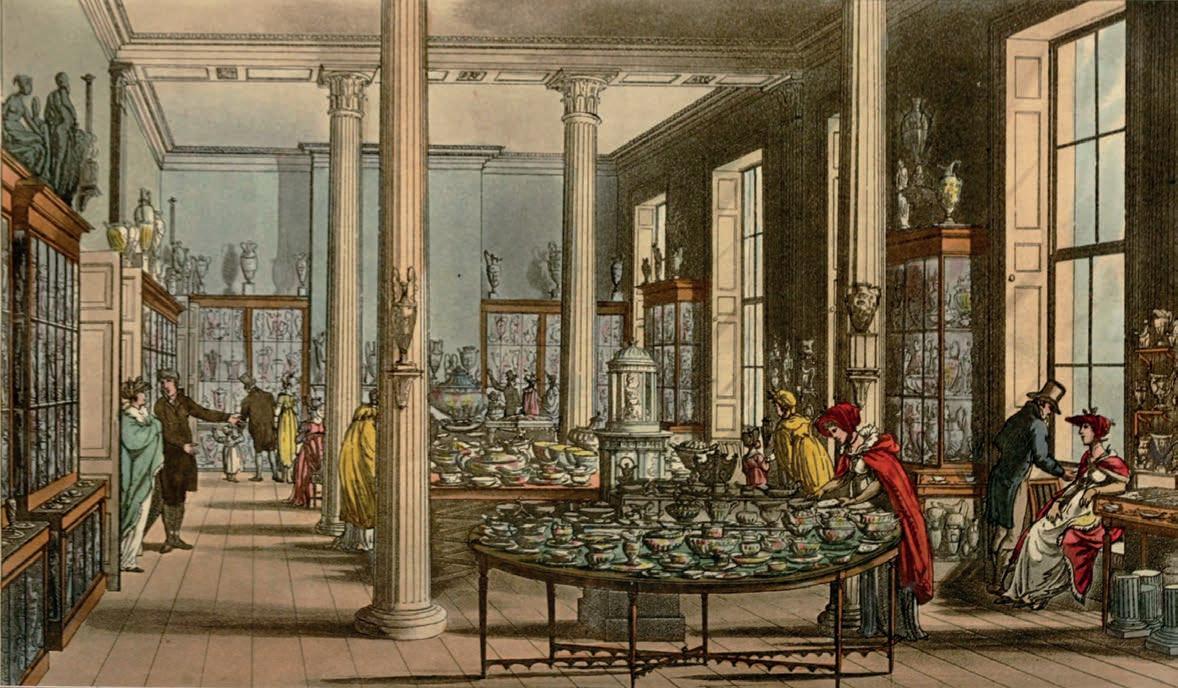
e lavish interiors of numerous late-Victorian and Edwardian shops have survived, partly because of their quality, allowing us a glimpse of what shopping was like before self service. For today’s collectors the period has left a dizzying array of pieces from glove holders to haberdashers’ cabinets, as well as greatly sought-after shop signs. is month’s popular Decorative Antiques and Textiles Fair in Battersea hosts a number of dealers which specialise in antique shop ttings and interiors.
Andrew Angell from Interior Boutiques, who will be at the fair from May 9-14, said: “I started selling antique advertising and shop ttings at Portobello Road, mainly to museums and private collectors. Over the years, it has changed and more and more people have been putting one-o individual pieces in their homes such as chemist cabinets and haberdashery units.”
e quality of the pieces means they make a sturdy basis for repurposing. Richard Wait from Hatchwell Antiques, also at this month’s fair, said: “Haberdashery cabinets are always popular with interior designers and for home furnishings as they are great storage, and are generally very good quality, in terms of their construction, and materials used, such as timber and metalwork.
has never been stronger. Antique CollectingAbove Ackermann’s Repository of Arts, 1816, illustration of the interior of the Wedgwood shop, London, c. 1809, image public domain Right A 20th-century shop display box with a curved glass opening front and mirror, made by S. Mawson & Sons Ltd. On sale from James Worrall antiques priced £950
David Levi, another of the dealers at this month’s spring edition of the fair, said: “ ere are a number of ways they can be repurposed, from a cabinet to house a collection of smaller pieces, or even as a cabinet in a walk in wardrobe. Smaller cabinets can be used to store cds, or in the kitchen for spices. It is their quality of construction that really makes them stand out.”

e human need to exchange goods has shaped our towns and cities since medieval times. In the 12th and 13th centuries, well-o customers acquired their possessions directly from the makers whether silversmith or tailor who would visit them in their homes.
Meanwhile the vast majority of the population bought from pedlars or at market. A small number of annual large fairs served most of the population – some by royal consent such as Stamford fair, St Ives fare at Easter, Boston fair in July and Winchester fair which took place in September.
As time progressed permanent markets began to proliferate and by 1300 permanent structures had begun to intrude on open market places. ese islands of buildings originated as temporary stalls arranged in narrow rows devoted to particular trades.
For hygiene reasons butchers and shmongers started to erect larger stalls, or shambles, in the market place. Shop furniture was sparse, with benches and shelves the mainstay and a co er housing most of the stock.
The Royal Exchange could be described as the country’s first shopping arcade. It was built by Sir Thomas Gresham in 1570, modelled on the Antwerp Bourse and designed as a gathering place for international merchants in London. In this etching from 1644, the scene includes two Muscovy merchants in fur caps and a woman ballad seller. What was new in the Royal Exchange was that these were retail shops. One of the first shoppers was Queen Elizabeth herself, who opened the Royal Exchange.
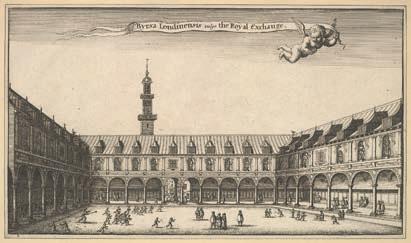
While merchants exchanged news of ships coming in, and could buy and sell goods, the complex housed some 120 boutiques: a single row of ground-floor shops, two rows of first floor shops and an attic. Each had open fronts with stall-boards displaying a miscellany of goods. In a time of mass illiteracy, shops were identified by their hanging signs.
Shops also grew up in front of workshops with the manufacturing taking place at the back. Due to the size of the booths fittings would have been limited, with shelves making up most of the display, along with a coffer to house stock.
It was the Georgians during the mid to late 18th century who reinvented shopping as a leisure pursuit. Arcades and bazaars as venues for the beau monde appeared as markets were swept into purpose-built halls catering for the growing middle classes. e a ordability of large bowglazed windows at the time also allowed light to illuminate what had been rather dingy pitches.
In 1796, Harding, Howell and Co.’s Grand Fashionable Magazine opened on Pall Mall, described by an enthusiastic observer as “perfectly unique in its kind”.
Like many of the founders of the early department stores Anthony Harding (1762-1851) was a silk merchant. John Lewis and Whiteleys in London, were alsoboth founded by drapers, who knew how to appeal to middleand upper-class women who spent most of their time in the home, o ering a respectable space in which women could operate unchaperoned.
Harding, Howell and Co. was divided into four departments, o ering furs and fans, haberdashery, jewellery and clocks, and millinery, or hats. Shoppers were
Right View of the courtyard of Gresham’s Royal Exchange, etching, rst state, 1644, image courtesy of the Metropolitan Museum of Art Below A walnut haberdashery cabinet on sale from Dee Zammit priced £3,250‘Many of the founders of the early department stores including John Lewis and Whiteleys in London, were drapers, who knew how to appeal to middle- and upper-class women by offering a respectable space in which women could operate unchaperoned’
encouraged to browse and were no longer limited to the range o ered by door-to-door tradesmen.
Shopping was now for the rst time a leisure pursuit with shops designed to be as attractive and enticing as possible, with large glazed windows, glass chandeliers, tall ceilings from which to hang the fabrics and large, glass-fronted cases to display the merchandise.
It was accompanied by new ways of displaying products. Traditionally, goods were arranged en masse, piled high to impress customers with sheer quantity.
As well as Sage & Co. a number of fitters rose to prominence, with their work as sought after today as it was then.
Birmingham shopfitters Harris & Sheldon was founded in 1880 by Sydney Harris who was later joined by John Eccleston. For more than a century their work could be seen in the most prestigious retailers throughout the country.
The London shopfitters Pollard’s was founded in 1895 by Edward Pollard in London’s Kingsland Road. In 1906 it moved to a ‘City’ showroom on the Clerkenwell Road. After WWI, a second factory making jewellers’ sundries was built in Highbury.
Throughout the 1920s and ‘30s Pollards continued to expand, opening West End showrooms at 299 Oxford Street, and establishing branches in Bristol, Manchester, Glasgow and Dublin. The company held the English patents for “invisible glass” an American invention which used concave glass to deflect light towards matt black baffles to prevent reflection in the window. It was installed in several important London stores, including Simpsons of Piccadilly (now Waterstones), where they remain today.
Originating in Bristol, Parnall & Sons Ltd was set up in 1820 by William Parnall, initially making weights and measures, before expanding into shop keeping equipment and shop fittings. By the 1880s it was the largest shop fitting company in England with showrooms in Bristol, London and Swansea.
Below left A mahogany counter-top shop display cabinet for embroidery silks c. 1890 sold by Interior Boutiques. Prices for similar pieces start at £800
Below right Jessops in Nottingham, shop interior, 1937, John Lewis Partnership Archive collection

Bottom right A 54-drawer golden oak haberdashery or shirt maker’s cabinet, with brass label holders, c. 1930. On sale from Hatchwell Antiques, priced £3,600

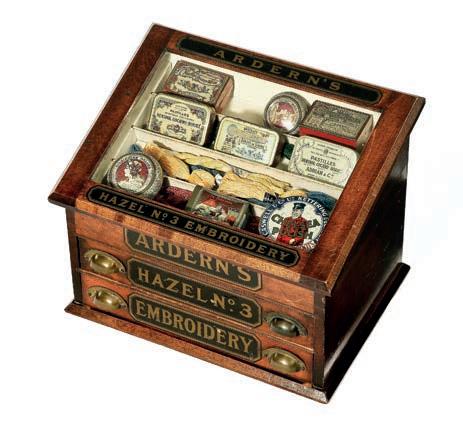
e department store, operating on a model of quick turnover made possible by new methods of mass production, repurposed the ‘massed’ display as an indispensable tool for shifting old stock, emphasising bargains. High-end products, meanwhile, were arranged in open displays – showroom settings that gave context, and therefore aspirational value, to the goods.
Le Bon Marché was established in Paris in 1852, heralding another evolution of the magasins de nouveautés –shops that showcased newly developed products. It was the store’s progressive owner, Aristide Boucicaut, who developed many of the retail practices we have come to know as standard today.
In the early 19th century, products did not have set prices, sales were instead negotiated through bartering, allowing shopkeepers to charge higher prices for more a uent-looking patrons. Boucicaut, however, abolished this system, with xed pricing creating a transparency to the buying experience and encouraging people to browse.
He also introduced home delivery, allowing articles to be exchanged; mail order; seasonal sales and a reading room for waiting husbands. eir new style of commerce was soon copied the world over.
By the early 20th century, shop windows and entrances took on greater prominence, and ever more inventive window decorations became the norm. e arrival of Selfridges department store in London in 1909 probably kickstarted the sophisticated art of window dressing as we recognise it today.
With the boom in shopping so, too, came the need to present wares in the most attractive way. One of the rst men to capitalise on the trend was Su olk-born Frederick Sage a journeyman apprentice and later cabinetmaker who started his career making speaking tubes before moving into shop tting.
By the beginning of the 20th century Harrods had set its stall out to be the nest retail establishment in the world. From I900 to I905, it called on Sage & Co. to design its shop furniture, a commission that consolidated the company’s reputation.
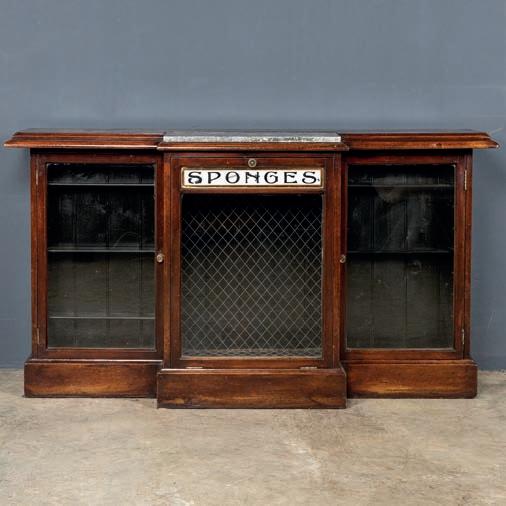
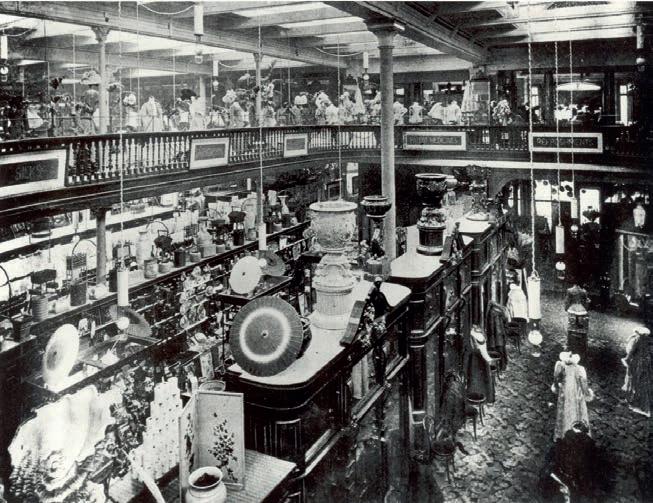
Part of the contract demanded the manufacture of some of the ttings in Milan, and the company sent a squad to Italy to oversee the work, as well as ttings made in its workshops in London and Peterborough.

Other commissions followed in Dickins and Jones in


If the trend for antique shop fittings is in the ascendancy it is nothing compared to the boom in shop and pub signs. Folk Art specialist, David Levi, explained: “The increase in interest in authentic antique signs has been humungous.” Growing interest has been so great it has even spawned an industry of fakes both in the UK and India.
Trade signs and related ephemera are historic devices of identification and persuasion. Even in classical times there is evidence that the Greeks, Romans and Egyptians all used forms of signage. Emblems, symbols and pictorial designs were practical when the majority of the population was illiterate. “At the sign of the…” was the easiest way for people who couldn’t read to locate a business, inn or buildings close by.
In medieval Europe, the use of emblems to distinguish inns and trades became more complex as heraldic imagery was incorporated, and establishments gained vernacular names based on eye-catching elements of the coats of arms which marked them – The Talbot, The Red Lion, The Crossed Keys etc.
Certain identifiable trade signs that survive into modern times include the three balls of the pawnbrokers (a symbol said to have originated with the Lombards who came to London as bankers in the Middle Ages), and the red and white pole of the barbers.
Traditionally they were barber-surgeons, distinct from medical doctors, and the red drapes on the pole indicated they could perform operations such as blood lettings, tooth extraction or (rather grizzly) amputations and the like – the red symbolising the colour of blood.
Above right Early 19th-century shop/ trade sign, priced £4,500, on o er from David Levi Antiques
Right A 19th-century pub sign sold for £6,500 at Bishop & Miller’s recent sale, it came from e Wild Man public house in Sproughton, Su olk

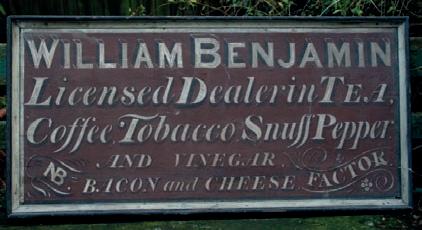
Left A sponge cabinet on sale from Dee Zammit priced £2,950
e spring edition of the Decorative Antiques and Textiles Fair in Battersea from May 9-14 includes a number of dealers who regularly stock shop ttings and signs, including Dee Zammit, David Levi, D J Green Antiques, e Home Bothy, Hatchwell Antiques, Christopher-Hall Antiques and Interior Boutiques. For more details turn to page 58 or visit www.decorativefair.com
Above Vivien Leigh by Yevonde (1936, printed 2022-3), purchased with support from the Portrait Fund, 2021 © National Portrait Gallery, London

when it was viewed as the poor relation of monochrome. e exhibition, opening on June 22, will showcase more than 150 of her works, 25 of which have only been recently discovered. One such is a previously unseen self-portrait in vivid Vivex tricolour from 1937 which sees Yevonde looking directly into the lens and at the viewer, positioned alongside her weighty one-shot camera. Yevonde was known for using props, many of which she made herself, and the portrait includes the book Art Now - Herbert Read’s survey of modern art from 1933 - to demonstrate her artistic credentials.
Madame Yevonde started life as Yevonde Philomene Cumbers, born in Streatham, south London in 1893 to a prosperous family. She was the eldest of two daughters, and with Verena, her younger sister, the family moved to Bromley in 1899. Her upbringing was both lively and, for the time, liberal. From an early age she displayed an independent attitude citing Mary Wollstonecraft as her girlhood champion.
At the age of 16 she was sent to a convent school in Belgium, but nding her life their dull and restrictive she quit the school returned to Bromley and joined the Su ragette movement, seeking out a lifestyle and income which would allow her independence. She said: “I was already fed up with the ower arranging and gossip that constituted the life of well-to-do girls.”
e same year Yevonde answered an advert in a local paper requiring an assistant for a London photographic studio. She was duly taken on by one of the leading society photographers of the day, Madame Lallie Charles (1869–1919) as an apprentice. In her autobiography, In Camera (1940) Yevonde wrote: “I took up photography with the de nite purpose of making myself independent. I wanted to earn money of my own.”
Next month the National Portrait Gallery unveils the largest exhibition ever devoted to the life and 60-year career of Madame Yevonde (1893-1975). While her name may be known to few today, Yevonde was a society photographer of note chronicling, among others, the Bright Young ings of the day. She was also a pioneer of colour photography at a time
Right Mask (Rosemary Chance) by Yevonde (1938, printed 2022-3), purchased with the support of the Portrait Fund, 2021 © National Portrait Gallery, London
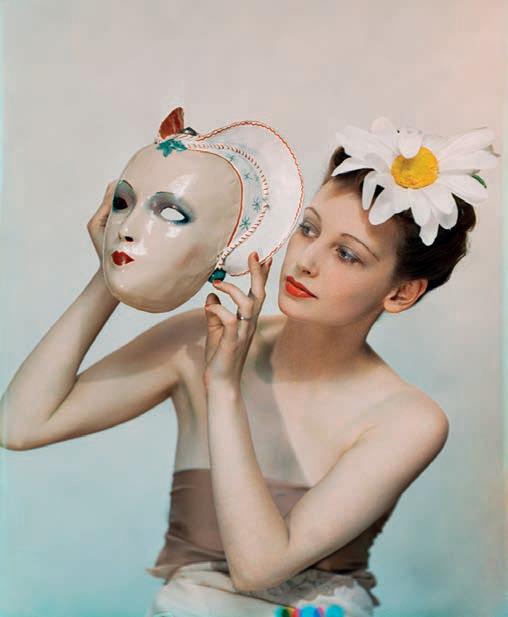
In the rst of a new series Maudji Mendel explores the life, work and collectability of unsung female artists, starting with the pioneering photographer Madame Yevonde
Yevonde worked in Lallie Charles’s Curzon Street studio for a year, learning the technicalities of photography as well as how to handle aristocratic clients.
In 1914, realising that Lallie Charles’s romantic Edwardian treatment of women as submissive objects of beauty was becoming old fashioned she decided to go it alone. With the technical grounding she received from working with Charles, and a gift of £250 from her father, at the age of 21, months before the outbreak of WWI, Yevonde set up her own studio at 92 Victoria Street, London, and began to make a name for herself by inviting well-known gures to sit for free. working under the title ‘Madame Yevonde – Portrait Photographer’ – taking the title from her erstwhile employer. It is estimated that throughout Yevonde’s six-decade-long career 10,000 personalities passed through her doors, with early clients including Winston Churchill, Arnold Bennett, Rebecca West, and Evelyn Waugh.

Yevonde’s most renowned body of work is a series of women dressed as goddesses posed in surreal tableaux made in 1935, first exhibited as part of An Intimate Exhibition: Goddesses and others at her Berkeley Square studio in London.
It was inspired by an Olympian ball held at Claridge’s for socialites and celebrities at which they were encouraged to dress as Greek heroes, and Roman deities. The party goers jostled to have their picture taken by Yevonde.
With a total of 24 sitters, the project became full of striking images including the mysterious model known as Baroness Gagern, who was photographed embracing a stuffed bull.
Mrs Charles Sweeney, who posed as Helen of Troy was photographed through translucent blue paper, her skin has the icy gleam of statuary.

Clare Freestone, curator of the show at the National Portrait Gallery, said: “It resulted in the recognition of the power of colour photography and ultimately culminated in Yevonde’s most celebrated body of work.”
In 1940, Yevonde recalled the shoot: “Mrs Gisborne posed as Psyche. Her mournful brown eyes, exquisite mouth and fair hair seemed to me to express the pleasure as well as the pain that Psyche was forced to endure.”
Yevonde’s photographic work was frequently eccentric, often refusing to portray her models in conventional poses. Many of her seated portraits featured goddesses o ering an empowering representation of womanhood rarely seen at the time. In addition, Yevonde was passionate about colouring some of her images which were extraordinary in their vibrancy – these vivid colours making them stand out from other photographers’ blackand-white prints.
In 1921, she became the rst woman photographer to be invited to talk at the Professional Photographers’ Association. During her lecture, titled ‘Photographic Portraiture from a Woman’s Point of View’, Yevonde claimed, in her typically outspoken manner, that “Women
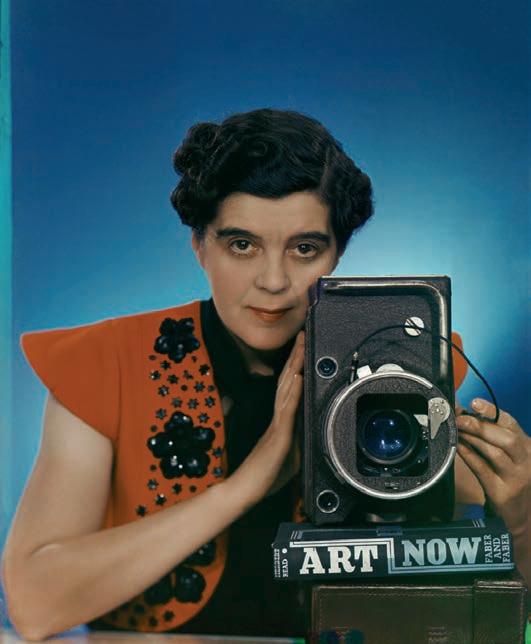 Left Self-Portrait with Vivex One-Shot Camera by Yevonde (1937), purchased with support from the Portrait Fund, 2021 © National Portrait Gallery.
Right Dorothy Gisborne (Pratt) as Psyche by Yevonde (1935), purchased with support from the Portrait Fund, 2021 © National Portrait Gallery, London
Below Edward James by Yevonde (1933) purchased with the support of the Portrait Fund, 2021 © National Portrait Gallery, London
Left Self-Portrait with Vivex One-Shot Camera by Yevonde (1937), purchased with support from the Portrait Fund, 2021 © National Portrait Gallery.
Right Dorothy Gisborne (Pratt) as Psyche by Yevonde (1935), purchased with support from the Portrait Fund, 2021 © National Portrait Gallery, London
Below Edward James by Yevonde (1933) purchased with the support of the Portrait Fund, 2021 © National Portrait Gallery, London
‘Yevonde’s photographic work was frequently eccentric, often refusing to portray her models in conventional poses. Many of her seated portraits featured goddesses offering an empowering representation of womanhood rarely seen at the time’
Left Lady Dorothy Warrender as Ceres by Yevonde (1935), given by the photographer, 1971 © National Portrait Gallery, London
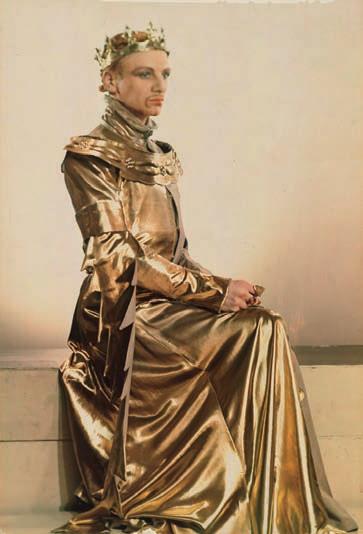
Below John Gielgud as Richard II in Richard in Bordeaux by Yevonde (1933) given by the photographer, 1971 © National Portrait Gallery, London
Bottom right Margaret Sweeny (Whigham, later Duchess of Argyll) by Yevonde (1938) purchased with the support of the Portrait Fund, 2021 © National Portrait Gallery, London
Despite a general hostility to colour photography from photographers and the public alike, Yevonde’s commitment to the new process makes her a central gure in the development of modernist photography. As well as re ecting a new style of portraiture, Yevonde was a pioneer of colour photography.
From the early 1930s, Yevonde experimented with techniques such as Solarisation (the e ect of tone reversal observed in cases of extreme overexposure of the photographic lm in the camera) and the Vivex colour process (a wash-o relief process using three negatives on waxed cellophane, one for each primary colour).
In 1932, during an address to the Royal Photographic Society, she said: “If we are going to have colour photographs, for heaven’s sake let’s have a riot of colour, none of your wishy-washy hand tinted e ects.” In the same year, she mounted a solo exhibition of her work at the Albany Gallery in Sackville Street, the rst in England to include colour portrait photographs.
make better photographers than men because they put more character into their work.”
In 1925, she was invited to submit work to the Professional Photographers’ Association International Exhibition of Professional Photography, held to celebrate a century of photography at the Princes Gallery, Piccadilly.
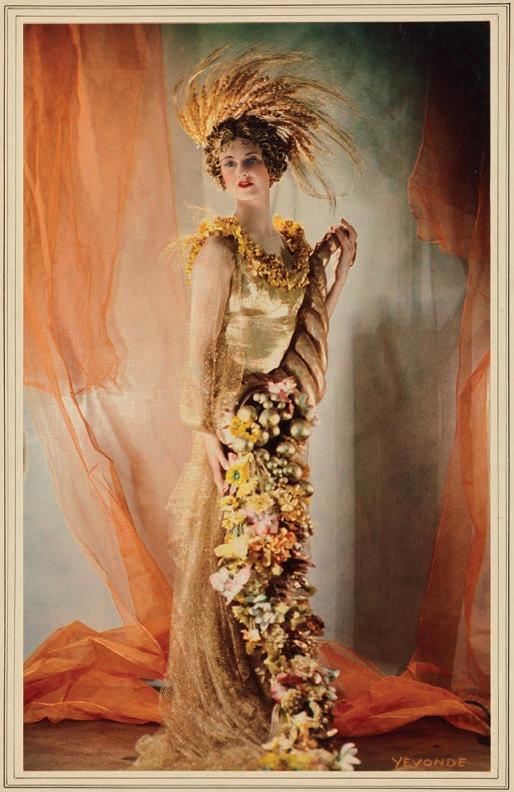
Yevonde’s work quickly became published in leading society and fashion magazines such as the Tatler and the Sketch, depicting new freedoms in fashion and leisure as well as capturing the growing independence of women.
Her commercial work also appeared as advertisements constructed through humorous still life or by using models in tableaux.
Yevonde’s audience included the readers of the growing eld of women’s magazines such as Woman and Beauty and Eve’s Journal. Her clientele comprised some of the most famous faces of the time - from John Gielgud to Princess Alexandra.
However, such was the prevalent prejudice that her colour cover shots for Tatler and the Sketch ended up being printed in monochrome.
After working as a land girl during the war, Yevonde returned to photography but the period of her most intense creativity was over. In 1939, she had to stop her colour work, due to the demise of the Vivex colour process, the same year in which her husband the playwright Edgar Middleton died. In 1940, she was elected as a fellow of the Royal Photographic Society for her work

in leading society
in colour photography. Yevonde continued to experiment with black and white photography and exhibit her work producing a number of notable portraits. Yevonde died in 1975, aged 83.
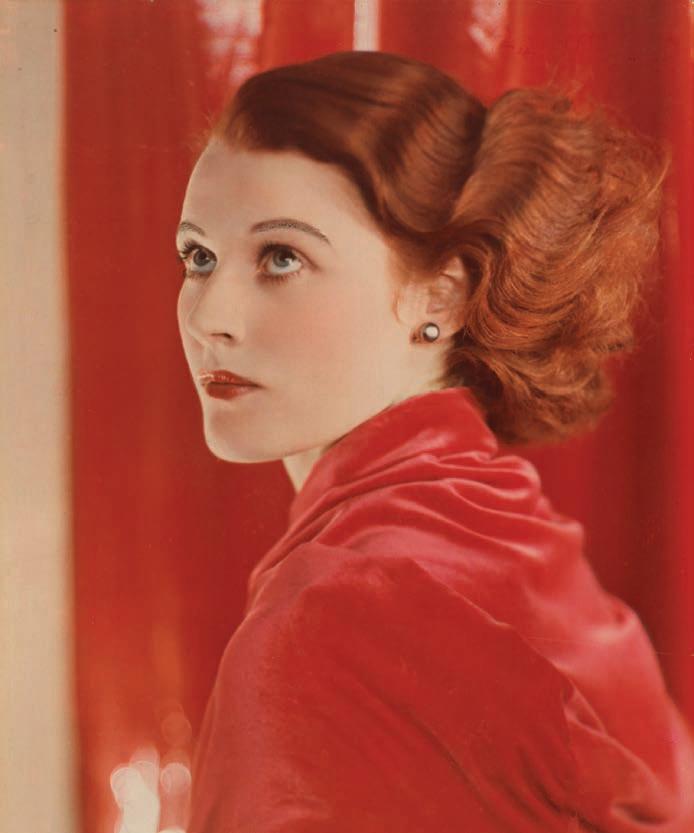
To celebrate her 80th birthday, the Royal Photographic Society gave an exhibition of her work. roughout her career she lived up to her maxim “be original or die!”




Almost 50 years later, her place as a key photographer in the 20th century is nally being recognised by a wider audience. National Portrait Gallery curator, Clare Freestone, said: “She is not a household name, partly due to the lack of female representation in the history of art and photography. She also de es easy categorisation: as well as being an excellent experimenter, the output of her 60-year career also encompassed advertising work which could have been seen to dilute the brilliance of her most creative work.”
With only 20 works having passed through auction since 1992, Yevonde’s record price in the public sphere currently stands at £14,484 (2012) for a still-life photograph shot in 1935. Most of her other photographs and prints currently sell for under £1,000, a lowly sum considering her pioneering methods and ingenuity.
Maudji Mendel is a curator at RAW, Rediscovering Art by Women. Yevonde: Life and Colour is on at the National Portrait Gallery in London from June 22 to October 15.
This month the work of Dorothea Lange (18951965) another pioneering 20th-century female photographer is in the spotlight when it goes under the hammer at Sotheby’s New York.

Among 18 photographs by the American photojournalist in the sale on May 1-2, is Migrant Mother, Nipomo, California (1936), one of the most famous images ever taken of Depression-era America.
Taken while photographing for the Farm Security Administration, the image transformed the subject — a hungry and desperate mother — into a Madonna-like figure and icon of the Great Depression. Lange took the picture returning home from an assignment for the Resettlement Association in March of 1936 when she came across a sign reading “Pea Pickers Camp”.
In 1940, Lange travelled to Arizona to document the working conditions of cotton workers. Migratory Cotton Picker, shows an anonymous migrant worker leaning against a fence with his cotton sack thrown over his shoulder. He presents his hand to the camera in an attempt to obscure part of his face but unexpectedly offers perhaps a more intimate portrait.

e photographs are part of the sale of images from the San Franciso gallery Pier 24 Photography featuring the work of some of the most in uential photographers of the 20th century at Sotheby’s New York on May 1-2.
Above right Dorothea Lange (1895–1965) Migrant Mother, Nipomo, California, 1936, printed 1940s
Right Dorothea Lange (1895–1965) Migratory Cotton Picker, Eloy, Arizona, 1940, printed 1940s
Put your art and antiques knowledge to the test with two pages of puzzles from our crossword editor Peter
Q1 What does the term ‘alwyte’ mean, or who uses it? (a) an auctioneer’s greeting, (b) a Renaissance artist’s lead-based paint, (c) medieval armourer, (d) 1920s kitchenware manufacturer.

Q2 Sierra Leone, Eritrea and Liberia issued special coins in 1997 as part of the Preserve Planet Earth campaign. What was depicted on them? (a) di erent species of monkey, (b) sh, (c) aquatic, but non- sh animals, (d) dinosaurs?
Q3 A cromorne is an early European reed instrument. What was special about it (two answers)? (a) the reed was concealed in a wooden cap, (b) it was curved, (c) it had a simple ‘mute’, (d) some holes had a hinged slip-over cover.
Q4 Which of the following cubist artists is reported to have said: “I paint objects as I think them, not as I see them.”?


(a) Georges Braque, (b) Juan Gris, (c) Fernand Léger, (d) Pablo Picasso.

Q5 In the 1930s ice-cream was sometimes sold in glasses shaped as what? (a) dumpy animals, (b) Platonic solids, (c) ring glasses, (d) WWI mess-tins.
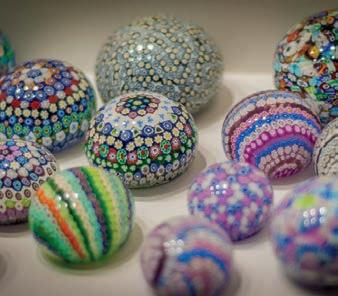
Q6 What is/was bois noici? French (a) ‘ebonised’ wood, (b) black veneered wood, (c) painted balsa wood, (d) any wooden model for the full-scale object i.e. of doll’s house size.
Send your answers to Crossword, Antique Collecting magazine, Riverside House, Dock Lane, Melton Woodbridge, Su olk, IP12 1PE. Photocopies are also acceptable, or email your answers to magazine@ accartbooks.com. e rst three opened by May 20 will win a copy of Jackson’s Hallmarks, Pocket Edition: English, Scottish, Irish Silver & Gold Marks From 1300 to the Present Day, worth £6.95

The letters in the highlighted squares can be rearranged to form mystery clock
The winners, who will each receive a copy of the book are F. Jones, Nevern, Pembrokeshire; Simon Green, by email and Bessie Fisher, Peckham, by email.
Q7 Which two of the following is associated with the term ‘cricket’? (a) a stool, (b) a bed, (c) a table, (d) a sideboard.
Q8 What was ‘national mis tz’? (a) early drafts of international treaties (b) European clothes (especially hats) with metric rather than ‘long measure’ (inch) sizes, (c) an amusing game based on assumed national characteristics, (d) German ladies’ boot sizes.
hats) with metric rather than ‘long measure’ (inch) national characteristics, (d) German ladies’ boot sizes.
Q9 What is a narghilly? (a) a 19th-century jug, (b) a Persian tobacco-pipe, (c) a 17th-century Welsh ponytrap, (d) scrimshaw made using a narwhal tusk.
trap, (d) scrimshaw made using a narwhal tusk. game arithmetic,
Q10 What is a humeral? (a) an early 20th-century game to teach arithmetic, (b) a 1920s shoulder strapbag for evening-dress wear, (c) a pomander worn around the neck, (d) a scarf for the shoulders.
Finally, here are four anagrams open cavern, any odd cops,oilier lm and earth vicar. Rearrange them in order to form…the documented history of an item; atware for measuring tea (two words); a glass pattern-making technique, and a moulded architectural framework.
For the answers turn to page 10.
2 James _____’s London auction house founded 1766. (8)
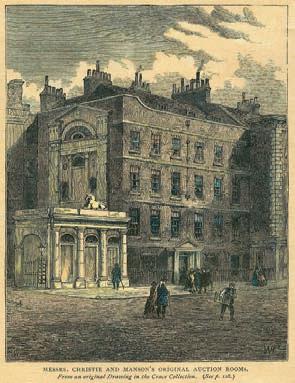
6 ____ glass. Developed by Tiffany…usually asymmetrical objects with a rough surface. Also a craze of lamp from the 1960s. (4)
7 One of the principal Hindu deities. (5)
9 ____ chair. High-backed with arms and sometimes a canopy. (5)
10 Twisted fibres…and a string of pearls. (4)
12 Chair and table leg termination introduced into England in the late 16th century. (4-3-4)

15 Vast continent and source of a huge number of styles, civilisations etc. (4)
16 ____ easy chair. Late 19th-century name for an armchair with a high back and rollover arms. (5)
18 Fabric folded back on itself and secured in place. (5)
20 ____ Blyton (1897-1968). English writer of children’s books. (4)
21 Mollusc that has ruined many a wooden structure/artefact in the sea. (8)
1 Lockable decanter case. (8)
2 Mould or shape material into artefacts. (4)
3 Ubu-___ Alfred Jarry’s (1873-1907) 1888 play, written when he was 15, and now considered the first of the avant-garde theatre. (3)
4 Ancient Egyptian amulet and impression seal. (6)
5 Jane ____ Charlotte Brontë’s 1847 novel. (4)
8 Ancient Greek goddess of women and family. (4)
11 Andrea _____ (1508-1580). Influential Italian architect. (8)
13 Cover, settle or round off (an auction?). (4, 2)
14 20th-century art movement of the European avant-garde. (4)
15 ____ and crafts. Late 19th-century British movement reforming design and manufacture. (4)
17 Separate article or entry. (4)
19 Et in Arcadia ___ also known as The Arcadian Shepherds
17th-century Nicolas Poussin (1594-1665) painting. (3)
Finally, rearrange the letters in the highlighted squares to form the name of the mid-19th c. group of disillusioned artists who numbered Ruskin among their ardent admirers. (3-11)
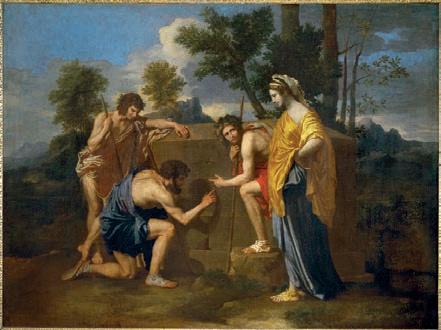
It remains to be seen which pieces of commemorative ware for this month’s coronation will stand the test of time and become the sought-after antiques of the future. It is generally considered it was Charles II whose coronation was rst celebrated on a piece of china.
Much of the rarest pieces of commemorative ceramics and glassware have found their way into royal collections and museums, out of the reach of the ordinary buyer. But for the collector there are still plenty on o er. e advent of transfer printing on pottery, rather than hand painting, was a watershed in the mass production of commemorative ware. But it was the Industrial Revolution that really fuelled the country’s ravenous desire for royal souvenirs. As a collecting sphere royal commemorative ware is unbeatable. Long may it reign.
George III
George III came to the throne in 1760 at the start of the Industrial Revolution which heralded a huge progression in living standards and national wealth. It saw the start of a middle class at which so much latter royal commemorative ware would be aimed. Ceramics from the date of his coronation are scarce and highly sought after
In 1789, the king’s health declined and hasty arrangements were made for the transfer of sovereign power. In the event he recovered and the arrangements were not implemented.

Right e scent bottles are 10.4cm high

Below right e plate sold for £140 in Bamfords, Bakewell
Below left e pearlware jug sold for £220 in 2017 at the Berkshire auctioneers Historical and Collectable
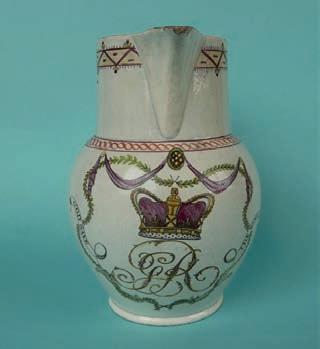
Below A pearlware loving cup, c. 1789, has an estimate of £400£600 at the Berkshire auctioneers Historical and Collectable’s sale on May 2
A number of ceramics were produced to celebrate George III’s return to health. e pearlware jug (below left) dates from around 1793 and is hand painted with the then royal cypher ‘GR’ and the crown, with swag decoration.

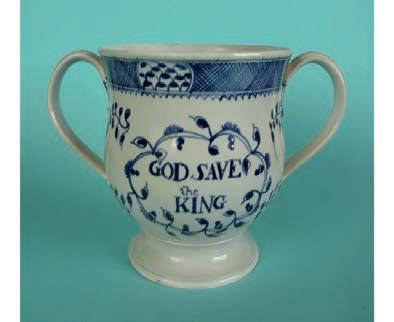

It fetched £220 in 2017, meaning it is not out of the reach of the ordinary buyer.


Having served as the Prince Regent since 1811, George IV ascended the throne in 1820 and was crowned in 1821. is plate is a good example of a creamware which was a typical of the ceramics of the period. It sold in January this year for £140.
A decent amount for royal commemorative piece but not exactly breaking the bank and would make a great addition to any collection.
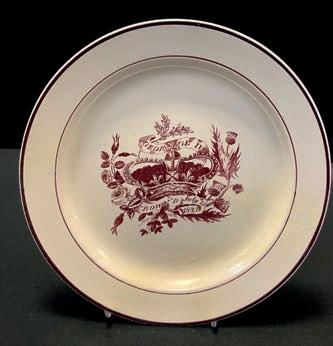
On the eve of this month’s coronation, antiques valuer Edward Rycroft looks back on the most collectable royal commemorative ware from previous monarchs
As well as plates, a range of jugs, bowls, cups and other types of creamware and pearlware from George IV’s reign appear at auction. Glassware is rarer. A pair of doublewalled crown scent bottles (below left) marking the same coronation of George IV are priced £650 (left) and £550 (right) from the Wiltshire glass specialist Delomosne.
William IV had one of the shortest reigns ever when he ascended the throne at the age of 64 reigning for just seven years from 1830 till 1837 and, just like George IV, he was crowned a year later in 1831.
While some royal commemorative ware dates to his coronation, it is much rarer than later monarchs.
Below is a good example of a pearlware transferprinted jug depicting the coronation of William IV and his wife Queen Adelaide whose widespread popularity was down to her charity work, church-building, and accessible middle-class values. e jug sold for a creditable £200 at the Wiltshire auction house Woolley and Wallis in September 2021.

Right e mug designed by Eric Ravilious sold for £580 at Canterbury Auction Galleries
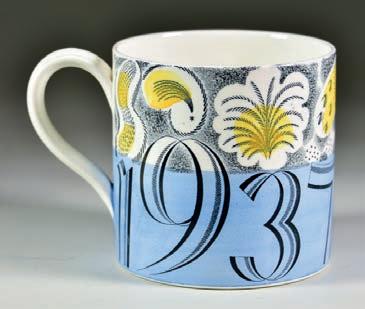
Below right Dame
Laura Knight’s design was adapted for the coronation of George VI and sold for £42 at the East Yorkshire auction house Hawleys
Below left e jug marking the coronation of William IV and Princess Adelaide sold for £200 at Woolley and Wallis, Salisbury
Bottom A Swansea pottery waisted mug dated to 1838 has an estimate of £200£300 at Historical and Collectable’s sale on May 2
Bottom right A pair of ‘Ace of Diamond’ candlesticks sold at Clarke’s Auctions, near Shaftsbury in Dorset for £280 in 2019
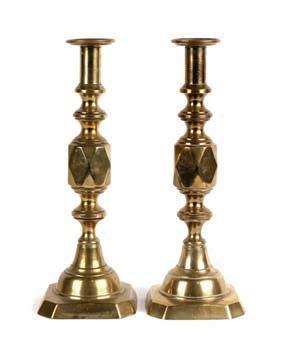

The coronation that didn’t happen still sparked a lot of commemorative ware with one of the most notable pieces being a mug designed by the in-vogue British painter and illustrator Eric Ravilious (1903-1940) who started a working relationship with Josiah Wedgwood & Sons in 1936. Following Edward’s abdication in December 1936, the design was recycled, revised and reformulated to celebrate both the coronation of George VI in 1937 and Elizabeth II in 1952.
More overlooked than those by Ravilious are mugs designed by Dame Laura Knight (18771970). They are often referred to as the “circus design” because, along with St George and the

After the end of one of the shortest reigns for centuries, came the second longest serving monarch. Queen Victoria reigned for 64 years and, in that time, oversaw the dramatic changes brought by the Industrial Revolution when ceramic and glass production was booming.
Early Victorian royal commemorative ware is rarer than that made towards the end of her reign. One of the most sought-after Victorian pieces is a Swansea purple transfer mug marking her coronation in 1838. With an o the shoulder dress and her hair in ringlets it portrays an image of the monarch rarely seen. It is one of the most expensive multi-circulation items of royal commemorative china.
At the other end of Victoria’s reign, her diamond jubilee in 1897 produced a massive haul of commemorative ware. But it wasn’t limited to ceramics. Birmingham brassfounders James Clews and Sons designed a series of candlesticks to mark the occasion. e smallest in the range is the ‘Diamond Princess’ at 27cm high, the ‘Queen of Diamonds’ at 29cm high, followed by ‘Diamond Prince’ at 30cm high, then the ‘King of Diamonds’ at 31.5cm. e ‘Ace of Diamonds’ towers over them all at a whooping 35.5cm high. is pair of ‘Ace of Diamonds’ (below) sold for £280 in 2019. All the designs have similar square bases with clipped edges and a large centre knop with the namesake diamond.

‘On his accesssion Edward commissioned half a million beakers from Royal Doulton to be presented to children and the needy. They have since become known to collectors as “The King’s Dinner Beaker” and come in blue, brown, green and purple’
Left
At the end of Victoria’s long reign, Edward VII ascended to the throne in 1901 and was crowned the following year. Commemorative ware was all the rage and, after his mother, Edward takes the gong for the most designs in his name.
On his accession
Edward commissioned half a million beakers from Royal Doulton to be presented to children and the needy.
ey are since known to collectors as “ e King’s Dinner Beaker” and, made in blue, brown, green and purple, collecting all four is one collecting idea.
Also by Royal Doulton are some rarer pieces, such as this attractive pair of stoneware vases. ey are each applied with portraits, with one depicting Edward and the other his wife, Alexandra. ey also bear inscriptions commemorating the occasion and are coloured in underglaze green with royal blue. Despite the quality they sold for a very a ordable £80 in 2019.
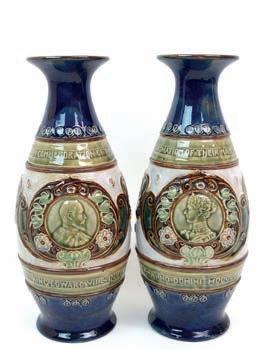
George V reigned for quarter of a century, from 1910 until his death in 1935. e Industrial Revolution had
Ranging from pill boxes to a leather bookmark with a pair of coronation socks thrown in, the Royal Collection Trust recently released details of the official coronation range.
The central feature of the design is a royal coat of arms supported by a garland of laurel leaves symbolising peace. In the decorative border, oak leaves signifying strength and longevity appear alongside emblems of the UK’s four nations – thistle, rose, shamrock and daffodil.
Below A selection of English commemorative pressmoulded glass, c. 1937, for the coronation of George VI has an estimate of £150-£250 at Dreweatts’ sale on May 16
Below right is lot of 14 items sold for £10 at the Norfolk auction house TW Gaze
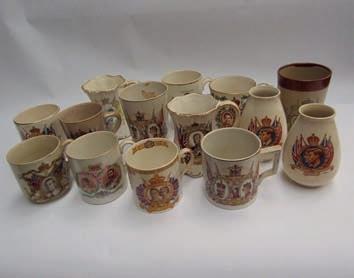
transformed Britain and ceramic and glass factories up and down the land were churning out an avalanche of items by the millions, which, of course, means it is eminently a ordable. While some quality “cabinet” pieces are available, the lot below (right) of 14 items sold for £10 at auction.
George VI came to the throne in 1937 after Edward’s abdication. While the outbreak of WWII was to later curtail the mass production of commemorative ware, there was a number of a ordable and attractive items dating from the coronation of the father of Elizabeth II.

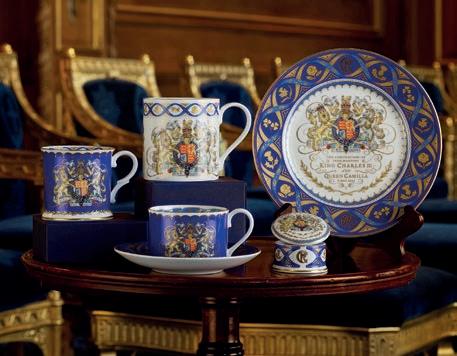
A selection of English commemorative press-moulded glass, c. 1937, including a set of six bon-bon dishes has an estimate of £150-£250 at Dreweatts’ sale on May 16.
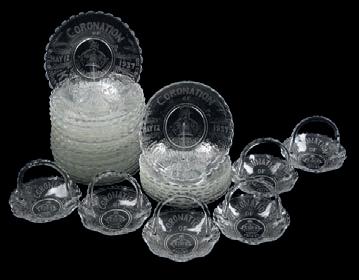
The commemorative china is made from clay sourced in Devon and Cornwall which was cast, fired and decorated by hand at the potteries in Stoke-onTrent, where china has been produced to commemorate royal occasions for generations. From the development of initial designs to the hand-finishing in 22-carat gold, the production process has involved more than 50 skilled artisans working in 12 factories.



Though rooted in traditional methods, the design and production methods of the range has evolved to incorporate efficiency and sustainability.
Adaptations have been made to the design of cup handles to require fewer kiln firings, thereby reducing the amount of energy consumed.
The official chinaware range comprises a coffee mug priced £30, pillbox costing £40, a tankard priced at £50 and cup and saucer costing £75.
Other pieces in the range include a set of four souvenir spoons topped with a hand-painted coronation motif, orb, sceptre and crown, as well as the King’s cypher which is priced at £40. A pair of
cotton coronation socks is priced £16. There is also a coronation tea blend, with a £9.95 price tag, presented in a keepsake tea caddy made in London using solar power.
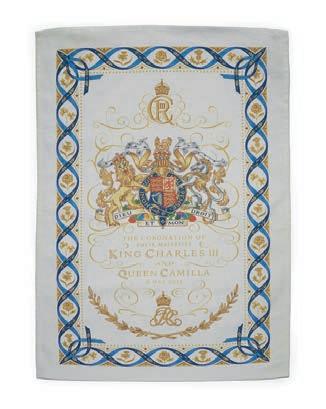
Left e range includes a dessert plate, mug and pill box
Right A cotton tea towel printed in Northern Ireland is priced £10.95
Below e o cial co ee mug is priced £30



Mark Goodger Antiques will be offering a solid oak tea caddy in the form of a sentry box at the Petworth Park Antiques and Fine Art Fair from May 19-21.
Dated to 1890 and the reign of George V it features a painting of a Grenadier Guard. The peaked roof lifts to reveal a tea storage compartment with a floating lid to help keep the tea leaves fresh. The inner compartment has traces of its original lining. It is priced £2,950 at this month’s fair, see page 58 for more details.
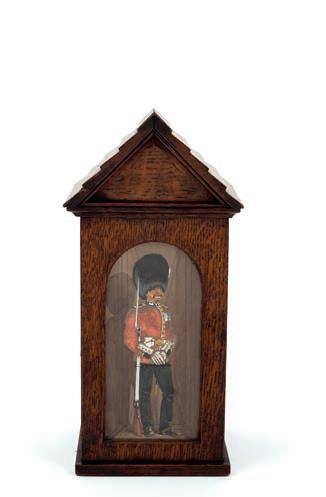
A portrait of Charles III’s grandfather, George VI, by Herbert James Gunn R.A. (1893-1964), is priced £18,000 from Petworth and St. James’s art dealer Rountree

Tryon Galleries
The painting, showing the monarch in his uniform as Admiral of the Fleet, is a preparatory portrait for a final version, commissioned by the British Council.
In the present painting, Gunn captures the king’s relaxed expression in contrast to the more serious demeanour of the finished work.
The portrait is on offer at the Petworth Park Antiques and Fine Art Fair from May 19-21, see page 58 for more details.
A 19th-century chest full of confectionary and culinary cutters and moulds which belonged to the chef of Edward VII is estimated at £200-£300 at Hansons’ Monarchs and Majesty auction on May 16.
Chef Louis Cabuzet cooked for Queen Victoria before going on to be head-hunted by the Earl of Sefton who made him head chef at his country estate of Croxteth Park.
A historical document prepared by Charles II in April 1660 is expected to make £400,000-£600,000 when it goes under the hammer at Sotheby’s coronation sale on May 4.
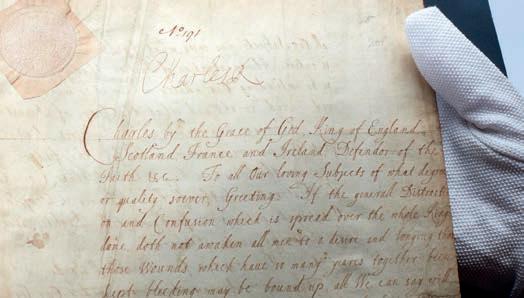
The Declaration of Breda sets out promises made by the monarch, including pardoning many of the crimes committed during the English Civil War, in return for his restoration to the throne after spending years in exile. Of the original five documents written, only two copies are known to have survived.
A set of four blue velvet stools used at two 20th-century coronations has an estimate of £1,000-£1,500 at Dreweatts’ sale on May 16. One was made for the coronation of George VI, with the remaining three used at the coronation of Elizabeth II. At the same sale a wooden armchair from the investiture of the Prince of Wales at Caernarfon Castle in 1969 has an estimate of £700-£1,000.

Following the ceremony the chairs were dismantled and offered for sale ‘flat-pack’, the attendant guest then had first refusal on their purchase. Lord Snowdon, who designed the chair, purchased six for himself. For more on coronation furniture see

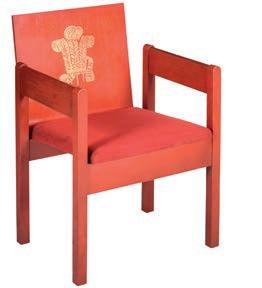
To celebrate thismonth’s coronation, dealersandauctionhouses up and down the land are pullingoutallthestops
A gold pocket watch, with an unusual repeat movement, has an estimate of £1,000-£2,000 in the Dorset auction house Charterhouse’s twoday sale on May 4-5.
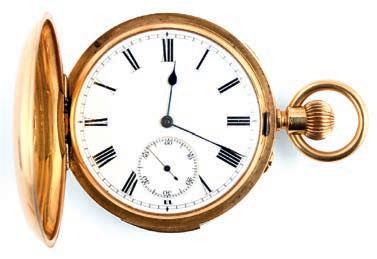
The 18ct gold full hunter had languished in a safe deposit box for many years. The back of the case is engraved with a crest and with the motto below Dextra Fideque or By my right hand and my faith
Auctioneer, Richard Bromell, said: “It is a very smart watch and still running well today. It repeats the quarters should you need to know the approximate time in the dark!”
A painting by the female Italian artist Orsola Maddalena Caccia (1596-1676) has an estimate of €20,000–€30,000 at Dorotheum’s Old Master paintings sale on May 3 in Vienna. It is only recently female artists of the 17th century have begun to receive the recognition and acclaim they deserve.

While a painting by Artemisia Gentileschi (1593–1654), one of the most celebrated female painters of her time, appears in the same sale with a canvas called Abraham and the Three Angels. Artemisia received her artistic training from her father Orazio Gentileschi, one of Caravaggio’s earliest followers.
Right Orsola Maddalena Caccia (15961676) Saint Catherine of Alexandria, oil on canvas, 100cm x 72cm, has an estimate of €20,000–€30,000
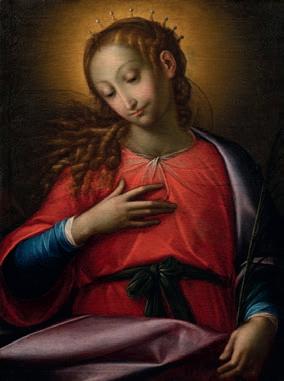
Below Artemisia Gentileschi (15931654) Abraham and the ree Angels, oil on canvas, 144.5cm x 200.8cm, has an estimate of €150,000–€200,000
A primitive chair made from ash, sycamore and pine and dated to 1800, has an estimate of £5,000-£7,000 at Suffolk auctioneers Bishop & Miller’s oak interior sale on May 24-25.

The chair, which has traces of historic red paint, was once in the collection of Pelham Olive, the son of Gabriel Olive, one of the founders of the Regional Furniture Society. Pelham grew up surrounded by his father’s rare antiques and artefacts. Pelham Snr studied the social and cultural context of traditional furniture makers while owning a shop in Wincanton, Somerset.
An extremely rare diamond called The Eternal Pink is expected to fetch more than $35m at a Sotheby’s auction, potentially breaking records as the most expensive price per carat ever to come to market.
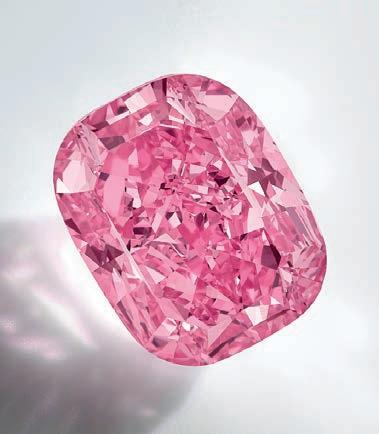
The 10.57 carat rock will go up for sale on June 8 in New York as the showpiece lot in Sotheby’s jewels auction.
The cushion-cut internally flawless diamond also carries the highest price per carat estimate ever placed on any diamond or gemstone ($3,311,258).



An early 19th-century desk seal belonging to the Scottish author Sir Walter Scott (1771–1832) has an estimate of £12,000£18,000 at Lyon & Turnbull’s sale of the matrix collection of David Morris on May 19 in Glasgow.

Made from lapis lazuli and gold, the amethyst stamp (or matrix) is carved intaglio and includes the mottoes Reparabit cornua Phoebe (The moon will replenish her horns) and Watch weel (Watch well).
Although not much is known about the makers of 19th-century seals, it is generally accepted they were sold by a ‘toyman’. In the Georgian period toyshops sold desirable luxury items, including etuis, jewellery, watches, travelling cases, snuff boxes and seals.

Asian art devotees have the chance to delve into the world of contemporary Chinese ink painting this month when the collection of Michael Goedhuis goes under the hammer at Bonhams New Bond Street
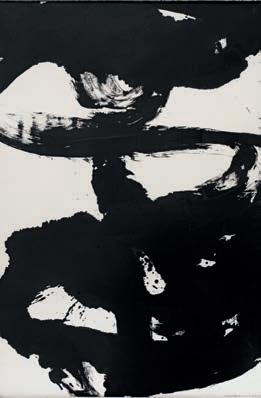


Goedhuis, left a successful career in investment banking in 1975 to pursue his interest in Asian art. He considers ink artists as the successors to the ‘literati’, the gentlemanscholars who, for centuries, practised the Chinese art of calligraphy, and its associated arts of painting, poetry and music, as a means of self-expression and cultivation.
He said: “Just as Picasso, Braque and Cézanne studied the old masters in order to create a new pictorial language in the early 20th century, these ink painters connected with literati culture to formulate fresh, new work that is relevant to, and meaningful for, the world of today.”
In the 1980s Goedhuis’ focus shifted further east to China and Japan when works of art in bronze joined ink painting as a focal interest. A number of bronze pieces also appear in this month’s sale.
In 2001, he staged what he describes as the first major show of Chinese contemporary art and design in the West called China without Borders: Chinese Contemporary Art
The well-attended event attracted 2,800 visitors to the opening night at Sotheby’s New York.
Leading the sale is Liu Dan’s (b.1953) 2007 work Old Cypress from the Forbidden City, depicting a gnarled tree isolated from its landscape. Lui Dan’s paintings of trees are rare, with most of his work usually depicting rocks or flowers. Liu Dan has emerged as one of the most gifted ink painters of his generation. He studied the Confucian classics, poetry, painting, and calligraphy from his grandfather. He returned to China in 2006 after living in New York and expanded his repertoire of subject matter to encompass trees and flowers having, for years, had an abiding fascination with rocks, which represent “the stem cells of landscape”. The guide price is £200,000-£300,000.
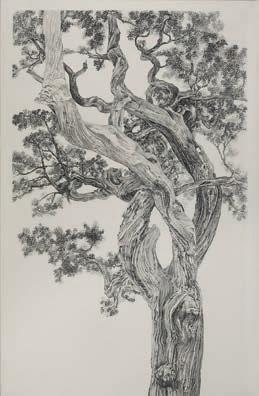
The sale also includes a 1972 work by Lui Shou-Kwan (1919-1975) one of the most prominent ink painters of the 20th century and a founder of the Hong Kong New Ink Movement. He is recognised for his uniquely experimental approach and credited with expanding the tradition of Chinese painting by incorporating bold, gestural and abstract mark-making.

Zen Lotus dates to the last decade of his life when he developed a deep fascination with Buddhism which transformed his artistic output. In his Zen paintings, the lotus is a symbol for eternity, purity, and Buddhahood.
Goedhuis told Bonhams magazine: “The Bonhams sale is a way for me reach an audience I do not know. I would like to help raise the appreciation of contemporary Chinese ink artists for a new generation.”
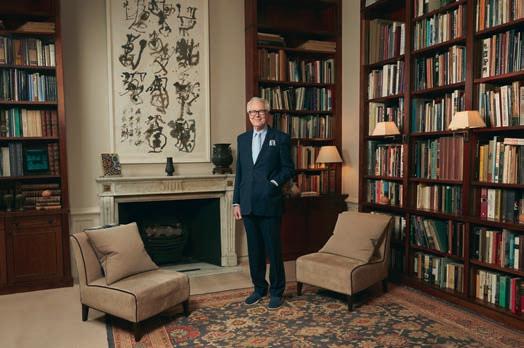
The Michael Goedhuis: Brush and Bronze sale will take place at Bonhams New Bond Street on May 18
1Michael Goedhuis in his living room. Wei Ligang’s Chinese Poem-Bronze Script hangs above the mantelpiece 2 Liu Dan (b.1953) Old Cypress from the Forbidden City, 2007, has an estimate of £200,000-£300,000 at this month’s sale 3 Wei Ligang (b.1964) Chinese Poem-Bronze Script, 2010, is estimated at £8,000-£10,000 4 Wang Dongling (b.1945) Confrontation of Yin and Yang, 2005, is estimated at £15,000-£20,000 5 Lui Shou-Kwan (1919-1975) Zen Lotus, 1972, estimate £30,000-£50,000 6 Qiu Deshu (b.1948) Mountainscape (Red), 2005, estimate £30,000-£50,000


ISBN 9781788842174
RRP £30.00

OFFER PRICE £19.50
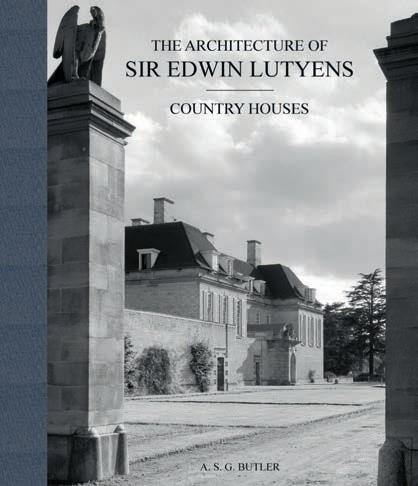 BY A.S.G. BUTLER, WITH GEORGE STEWART & CHRISTOPHER HUSSEY
BY A.S.G. BUTLER, WITH GEORGE STEWART & CHRISTOPHER HUSSEY
ISBN 9781788842181
RRP £125.00
OFFER PRICE £81.25



Edwin Lutyens, one of the most famous architectural names of the 20th century, died in 1944. As a memorial, three large volumes of his drawings and photographs were commissioned from the thousands found in his office and were published by Country Life. All three volumes will be republished in 2023. This first volume contains his own plans, elevations and copious details of the finest examples of his domestic buildings, on which his huge reputation principally rests. The book embodies the quintessence of the man and his work; the variety of style and design seen in the houses brings together in one volume the many strands of Lutyen’s fertile mind. (Two further volumes will include his corporate and public buildings.)
Geoff MacCormack’s remarkable photographic memoir, charting his lifelong friendship with David Bowie. Images bring MacCormack’s stories to life, showing the places he and Bowie inhabited, the people they met and the adventures they shared. Beginning at Burnt Ash Primary school in the mid-1950s, the years go by in a whirlwind of discovering and making music. The book contains nearly 150 photos taken by MacCormack throughout the years, some never seen before.
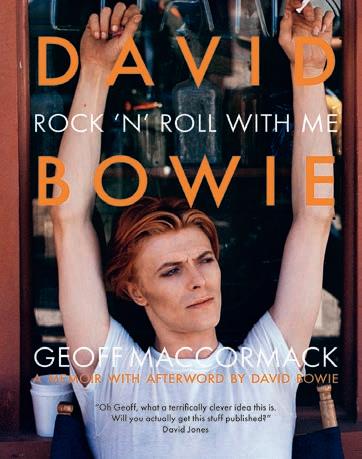
ISBN 9783740818630
RRP £13.99
OFFER PRICE £9.09
With a wealth of insider’s local knowledge and engaging anecdotes, 111 Places in Glasgow That You Shouldn’t Miss will guide you round a huge variety of intriguing sights, unique venues and surprising corners of this great city, helping you understand how the people made Glasgow and how Glasgow made its people.

 BY PETER FRIESS
BY PETER FRIESS
ISBN 9783961713707
RRP £49.95
OFFER PRICE £32.47


These lavishly illustrated books present some of the most important timepieces from the more than 3,000 watches exhibited at the Patek Philippe Museum in Geneva. These precious timepieces have been passionately assembled over more than 40 years by Philippe Stern, Honorary President of the company, and include some of the most valuable pieces in watchmaking history. The books allow you to take the Patek Philippe Museum’s exhibition home with you, or, alternatively, to get a preview of its treasures before you visit.
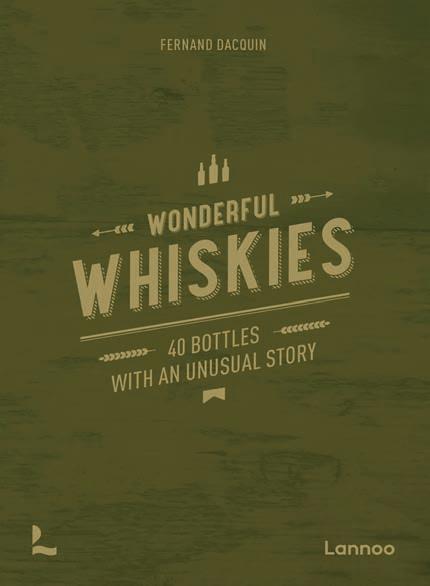 BY FERNAND DACQUIN
BY FERNAND DACQUIN
ISBN 9789401486293
RRP £25.00
OFFER PRICE £16.25
Whisky expert and enthusiast Fernand Daquin has gathered 43 amusing, surprising, and memorable anecdotes about the most beautiful and luxurious bottles of whisky he has encountered. For almost 40 years, he has been travelling through this wonderful whisky world, in search of the most striking stories and images. At close to 400 pages, with enticing illustrations, he shares these stories in his own engaging style, offering the ideal entertainment for the reader with a glass of whisky in hand.
ISBN 9783740818616
RRP £13.99
OFFER PRICE £9.09

This unusual guidebook explores 111 of the area’s most interesting places, it leaves the well-trodden paths to find the unknown: marvel at a stained-glass window which inspired the American flag, let others flock to Hill Top while you explore Beatrix Potter’s holiday home, walk through ancient forest to talk to fairies and swim with immortal fish. Pause to wonder at a stunning lake where a President proposed, view a constellation of stars like nowhere else, find out why exotic spices are used in local cuisine.



Taking place the week after the coronation, the Spring Decorative Antiques and Textiles Fair returns to its purposebuilt pavilion in London’s Battersea Park.
At the start of the new Carolean era, the foyer display will showcase furniture from the reigns of Charles I (1625-1649) and Charles II (1660–1685).

Running from May 9-14, the event is one of the most popular events in the UK fair calendar, regularly attracting everyone from “A” list celebrities, including Eddie Redmayne and Phoebe Waller-Bridge, to the cream of the interior design world seeking “one-off” statement pieces.
Its first staging of the year in January reported record sales and an overwhelming attendance, perhaps sparked by the folding of Masterpiece London and Art & Antiques Fair Olympia, as well as the recent shuttering of the Chelsea Antiques Fair.
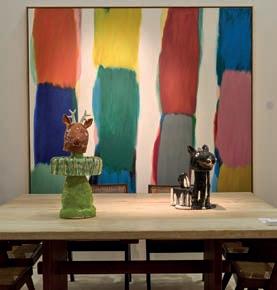

The ninth annual Petworth Park Antiques and Fine Art Fair opens its doors from May 19 to May 21 at a specially designed marquee in the grounds of Petworth House in West Sussex. A complimentary minibus will be on hand to take visitors to the market town of Petworth, packed with shops and galleries.
Up to 60 dealers will showcase their latest acquisitions, several for the first time – including Knightsbridge fine art dealers Gladwell & Patterson. The gallery will present an oil on canvas by the artist Ivon Hitchens who quit his Hampstead studio at the start of WWII to live in a caravan near Petworth Freshfords Fine Antiques will offer a Regency period chinoiserie table cabinet, as well as a rare early 19th-century rosewood bookcase cabinet, c. 1820 by the maker Gillows. Tickets to the fair also grants access to Petworth House owned by the National Trust which is home to one of the trust’s best art collections.
Event organiser Ingrid Nelson, from the Antiques Dealers Fair Limited, said: “With the sad demise of several fairs since the pandemic, we now have an even greater choice of dealers wishing to exhibit, so can offer visitors a really varied variety of specialisms from the ancient to the contemporary.”
This month 150 exhibitors will be offering traditional and informal antiques, 20th-century design and works of art, architectural objects, planters and statuary with prices ranging from £50 to more than £50,000.
Above e fair combines traditional antiques with contemporary style
Treasure trove
More than 40 leading dealers have signed up for a new June art fair set to take the place of the cancelled Masterpiece fair. The Treasure House Fair, formerly the London Summer Art Fair, will take place from June 22-26 in the grounds of London’s Royal Hospital Chelsea.
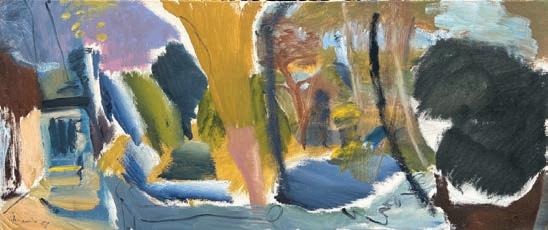

It is the brainchild of two of the original founders of Masterpiece – the London dealer Thomas Woodham-Smith and Harry van Der Hoorn, who owns the Dutch stand-building company Stabilo
Estimated to be a third of the size of Masterpiece, which launched in 2010 with 140 dealers, the fair will embrace a diverse range of items from fine art and furniture design to jewellery and antiquities.
Exhibitors for the fair’s first edition include Ronald Phillips, Osborne Samuel, Tomasso, Peter Harrington and SJ Phillips.
Because this list is compiled in advance, alterations or cancellations to the fairs listed can occur and it is not possible to notify readers of the changes. We strongly advise anyone wishing to attend a fair especially if they have to travel any distance, to telephone the organiser to confirm the details given.
LONDON:
Inc. Greater London
Adams Antiques Fairs
020 7254 4054
www.adamsantiquesfairs.com
Adams Antiques Fair, The Royal Horticultural Halls, Elverton Street, SW1P 2QW, May 14
Etc Fairs
01707 872 140
www.bloomsburybookfair.com
Bloomsbury Book Fair, Turner Suite at Holiday Inn, Coram Street, London, WC1N 1HT, Bloomsbury Book Fair, May 14
Sunbury Antiques
01932 230946
www.sunburyantiques.com
Kempton Antiques Market, Kempton Park Race Course, Staines Road East, Sunbury-on-Thames, Middlesex TW16 5AQ, May 9, 30
The Decorative Antiques & Textiles-Spring Fair
020 7616 9327
www.decorativefair.com
Evolution London, Battersea Park, London SW11 4NJ, May 9- 14
SOUTH EAST & EAST ANGLIA: including Beds, Cambs, Essex, Hertfordshire, Kent, Norfolk, Suffolk, Surrey, Sussex.
Arthur Swallow Fairs
01298 274493
Decorative Home & Salvage Show, Loseley Park, Polsted Lane, Guildford, GU3 1HS, May 19-21
Arun Fairs 07563 589725
Rustington Antiques & Collectables Fair, The Woodland Centre, Woodlands Avenue, Rustington West Sussex, BN16 3HB, May 14
Continiuity Fairs
01584 873634
www.continuityfairs.co.uk
Antique Fair, Epsom Downs Racecourse, Tattenham Corner Rd, Epsom, KT18 5LQ, May 16
Dovehouse Fine Antiques Fair 07952689717
dovehousefineantiquesfairs.com
Antiques and Decorative Arts Fair, Dorking Halls, Reigate Road, Dorking, Surrey, RH4 1SG, May 28
Grandmas Attic Antique and Collectors Fairs
www.grandmasatticfairs.co.uk
Antique and Collectors Fair, The Westgate Leisure Centre, Via Ravenna, Chichester, PO19 1RJ May 7
Antique and Collectors Fair, Woking Leisure Centre, Kingfield Road, Woking, GU22 9BA May 14
Love Fairs 01293 690777
www.lovefairs.com
Brighton Racecourse Fair, Freshfield Road, Brighton, East Sussex, BN2 9XZ, May 21
Lingfield Park Racecourse Fair, Racecourse Road, Lingfield, Surrey, RH7 6PQ, May 28
Marcel Fairs 07887648255
www.marcelfairs.co.uk
Antique and Collectors Fair, Sarratt Village Hall, The Green, Rickmansworth, Herts, WD3 6AS, May 14
Antique and Vintage Fair –Eagle Farm Road, Biggleswade, Bedfordshire, SG18 8JH, May 21
Antique Dealers Fair Limited 01797 252030. www.adfl.co.uk
The Petworth Park Antiques and Fine Art Fair, The Marquee, Petworth House and Park, Church Street, Petworth, GU28 0AE, May 19-21
SOUTH WEST including Berkshire, Buckinghamshire, Cornwall, Devon, Dorset, Gloucestershire, Hampshire, Isle of Wight, Oxfordshire, Somerset, Wiltshire.
AFC Fairs 07887 753956
www.antiquefairscornwall.co.uk
Lostwithiel Antique & Collectors
Fair, Lostwithiel Community Centre, Pleyber Christ Way, Lostwithiel, Cornwall, PL22 0HE, May 14
Pensilva Antiques Fair, Millennium House, Princess Road, Liskeard, Cornwall, PL14 5NF, May 28
Arun Fairs 07563 589725
Emsworth Antiques and Collectors Fair, Emsworth Community Centre., North Street, Emsworth, Hampshire, PO10 7DD, May 14
Continiuity Fairs
01584 873634
www.continuityfairs.co.uk
The Mona Antique Home & Vintage Fair, Anglesey Agricultural Society, The Showground, Gwalchmai, Holyhead, LL65 4R, May 26-27
EAST MIDLANDS including Derbyshire, Leicestershire, Lincolnshire, Northamptonshire, Nottinghamshire, Rutland.
IACF 01636 702326
www.iacf.co.uk
Newark International Antiques & Collectors Fair, Newark & Nottinghamshire Showground, Newark, Nottinghamshire, NG24 2NY, May 22
Navenby Antiques and Collectors Fair at The Venue, 07522 679 630 Venue at Navenby, Grantham Road, Navenby, Lincolnshire, LN5 0JJ, May 28
Red Fox Fairs 0790 359 5023
Collingham Antiques and Vintage Fair, Collingham Memorial Hall, 67 High Street, Collingham, Newark, NG23 7LB, May 28
Lowdham Antiques and Collectables Fair, Lowdham Village Hall, Main Street, Main Street, Lowdham, NG14 7BD, May 14
Stags Head Events 07583 410862
www.stagsheadevents.co.uk
Bank Holiday Antiques & Vintage Fair, Coalville Leisure Centre Stephenson Way, Coalville, Leicestershire, LE67 3FE, May 6,
Bank Holiday Antiques & Vintage Fair, Hood Park Leisure Centre, Ashby-de-la-Zouch, LE65 1LS, May 29
WEST MIDLANDS
including Birmingham, Coventry, Herefordshire, Shropshire, Staffordshire, Warwickshire, Worcestershire
Nuneaton Antiques and Flea Market
01827 895899
U.R.C Hall, Chapel Street (off Coventry St.), Nuneaton, Warwickshire, CV11 5QH, May 13
NORTH
including Cheshire, Cumbria, Lancashire, Northumberland, Tyne and Wear, Yorkshire.
Arthur Swallow Fairs 01298 274493
Antiques & Salvage Market, The Royal Cheshire County Show Ground, Clay House Farm Flittogate Lane, Knutsford WA16 0HJ, May 27
Decorative Home & Salvage Show, Ripley Castle, Ripley, Harrogate, HG3 3AY, May 5-8
V&A Fairs 01244 659887
www.vandafairs.com
Nantwich Town Square Antiques Market, Nantwich Square, Nantwich Town Centre, Cheshire, CW5 5DH, May 13
Nantwich Civic Hall Antique and Collectors Fair, Civic Hall Nantwich, Beam Street, Nantwich, Cheshire, CW5 5DG, May 29
Glasgow, Antique, Vintage & Collectors Fair 07960 198409, Bellahouston Leisure Centre, 31 Bellahouston Drive, Glasgow, G52 1HH, May 14
Kirkcaldy Antiques Collectors and Retro Fair, 07825 305678 St Bryce Kirk, St Brycedale Avenue
Kirkcaldy, Fife, KY1 1ET, May 27
IRELAND
Waterford Antiques, Vintage & Collectables Fair +353 85 862 9007 Waterford Tower Hotel
The Mall, The Viking Triangle, Waterford X91 VXE0, May 7
Because this list is compiled in advance, alterations or cancellations to the auctions listed can occur and it is not possible to notify readers of the changes. We strongly advise anyone wishing to attend an auction especially if they have to travel any distance, to telephone the organiser to confirm the details given.
LONDON: Inc. Greater London
Adam Partridge
The London Saleroom, The Auction Room, Station Parade, Ickenham Road, West Ruislip HA4 7DL, 01895 621991
www.adampartridge.co.uk
Antiques and Fine Art, May 16
Bonhams
101 New Bond St, London W1S 1SR, 020 7447 7447
www.bonhams.com
Fine Chinese Art, May 18
Fine Japanese Art, May 18
Michael Goedhuis: Brush and Bronze, May 18
Islamic and Indian Art, May 23
From Dacha to Dance: Folk Art and the Ballets Russes, May 16-23
Modern and Contemporary Middle Eastern Art, May 24
Islamic and Indian Art (Online), May 18-26
Modern and Contemporary South Asian Art, Jun 6 India in Art, Jun 7
Bonhams
Montpelier St, Knightsbridge, London, SW7 1HH, 020 7393 3900
www.bonhams.com
Watches and Wristwatches, May 11
Asian Art, May 15-16
Antique Arms and Armour, May 24
Rock, Pop and Film, May 24
Sporting Guns, Rifles and Vintage Firearms, May 25
Travel and Exploration Sale (Online), May 17-30
Prints and Multiples, Jun 2
Chiswick Auctions
Barley Mow Centre
Chiswick, London, W4 4PH
020 8992 4442
www.chiswickauctions.co.uk
Happy and Glorious: God Save
The King, May 4
Fine Oriental Rugs and Carpets, May 11
Books and Works on Paper, May 18
ine Chinese Paintings: Classical to Contemporay, May 19
Asian Art, May 22
Interiors, Homes and Antiques,
May 24
19th and 20th-Century
Photographs, May 31
19th and 20th-Century Paintings and Works on Paper, Jun 7
Christie’s
8 King St, St. James’s, SW1Y 6QT, 020 7839 9060 www.christies.com
Sculpted By Nature: Fossils, Minerals and Meteorites (Online), May 10-24
Finest and Rarest Wines and Spirits, Jun 6-7
Jewels Online: The London Edit (Online) Jun 1-15
The Two Continents Collection
- The Private Cellar of Irwin Kotovsky Online: Part II, (Online), starts Jun 8
Elmwood’s 101 Talbot Road
London, W11 2AT 0207 096 8933
www.elmwoods.co.uk
Important Jewels, May 3
Jewellery, May 10 Fine Jewellery, May 17
Forum Auctions
220 Queenstown Road, London SW8 4LP, 020 7871 2640
www.forumauctions.co.uk
Editions and Works on Paper
1500-2022, May 4
Books and Works on Paper (Online), May 11, 18
Fine Books, Manuscripts and Works on Paper, May 25 Modern Literature, Jun 8
Hansons Auctioneers
The Normansfield Theatre, 2A Langdon Park, Teddington TW11 9PS, 0207 018 9300
www.hansonsauctioneers.com
None listed for May.
Lyon & Turnbull Mall Galleries, The Mall, St. James’s, London SW1Y 5AS, 0207 930 9115
www.lyonandturnbull.com
Fine Asian Works of Art, May 12
Avant Garde : Art from 1900 to A Private Collection of Seals: Highlights from The Matrix Collection (Live Online), May 19 Form Through Time (Live Online), May 31
Noonans Mayfair 16 Bolton St, Mayfair, W1J 8BQ, 020 7016 1700 www.noonans.co.uk
The Thelen Collection of British Milled Coins, May 10 Orders, Decorations, Medals and Militaria, May 24
Banknotes, May 31, June 1 Coins, Historical Medals and Antiquites, Jun 7-8
Phillips 30 Berkeley Square, London, W1J 6EX, 020 7318 4010 www.phillips.com
Photographs, May 19
Evening and Day Editions, Jun 7-8
Roseberys Knights Hill, Norwood, London, SE27 0JD 020 8761 2522
www.roseberys.co.uk
Chinese, Japanese and South East Asian Art, May 16
Fine and Decorative, May 24 Modern British and 20th Century Art, Jun 6
Sotheby’s New Bond St., London W1A 2AA, 020 7293 5000 www.sothebys.com
The Coronation Sale, Apr 21 to May 4
The Samurai: Japanese Arms and Armour, (Online) May 3-10
Photographs (Online), May 12-18 China 5000 Years (Online), May 12-19
Classic Design: Furniture, Clocks, Silver and Ceramics, May 12-23
Design 17/20: Furniture, Silver and Ceramics, May 12-24
Timeline Auctions
23-24 Berkeley Square London W1J 6HE
www.timelineauctions.co.uk 020 7129 1494
Ancient Art, Antiquities, Natural History and Coins, May 23-27
ANGLIA: Inc. Bedfordshire, Cambridgeshire, Essex, Hertfordshire, Kent, Norfolk, Suffolk, Surrey, Sussex
Bishop and Miller
19 Charles Industrial Estate, Stowmarket, Suffolk, IP14 5AH, 01449 673088
bishopandmillerauctions.co.uk
The Oak Interior, May 24-25
Bishop and Miller Unit 12 Manor Farm, Glandford, Holt, Norfolk, NR25 7JP
bishopandmillerauctions.co.uk
Ornithological, May 18
Bellmans Newpound, Wisborough Green, West Sussex, RH14 0AZ, 01403 700858
www.bellmans.co.uk
Modern British and 20th Century Art, May 16
Asian, Coins, Medals, Clocks & Interiors, May 17-18
Fine Jewellery and Watches, May 18
Burstow & Hewett The Auction Gallery, Lower Lake, Battle, East Sussex,TN33 0AT, 01424 772 374
www.burstowandhewett.co.uk
Luxury Watches, Fine Jewellery and Silver, May 5, Jun 2
Home and Interiors, May 10-11, Jun 7-8
Antique Sale, May 25
20th-Century Design, May 25
Fine Art and Sculpture, May 25
The Canterbury Auction Galleries 40 Station Road West, Canterbury, Kent, CT2 8AN, 01227 763337 canterburyauctiongalleries.com
General Sale June 3-4
Cheffins Clifton House, Clifton Road, Cambridge, CB1 7EA 01223 213343, www.cheffins.co.uk
The Interiors Sale, May 2
The Art and Design Sale, May 25
Ewbank’s London Rd, Send, Woking, Surrey, 01483 223 101 www.ewbankauctions.co.uk
Vintage Posters (Timed), May 12-25
Trading Cards, May 17
The Restorer’s Sale, May 18
Toys and Models, May 24
Entertainment and Memorabilia, May 25
Entertainment and Memorabilia
Premier, May26
Pre-loved, Vintage and Antiques, May 31
Magic the Gathering: Modern Era, 2003-2020, Jun 1
Retro Games and Consoles, Jun 2
The Football Auction, Jun 9
Excalibur Auctions Limited
Unit 16 Abbots Business Park
Primrose Hill Kings Langley, Hertfordshire, WD4 8FR 020 3633 0913
www.excaliburauctions.com
Movie, TV & Music Posters, Memorabilia and Vinyl, May 13
Toys and Model Railways Collectors Sale, May 27
Gorringes
15 North Street, Lewes, East Sussex, BN7 2PE, 01273 472503 www.gorringes.co.uk
Weekly Sale, May 9, 15, 22, Jun 5, 12
Hansons
The Pantiles Arcade, 49 The Lower Pantiles, Royal Tunbridge Wells, Kent, TN2 5TE 01892 573540 www.hansonsauctioneers.co.uk
May Fine Art, Antiques and Collectors Auction, May 23
John Nicholson’s Longfield, Midhurst Road, Fernhurst, Haslemere, Surrey, GU27 3HA, 01428 653727 www.johnnicholsons.com
Islamic and Oriental, May 17
Fine Antiques, May 18
Fine Paintings, May 24 General Auction, Jun 3
Lacy Scott & Knight 10 Risbygate St, Bury St Edmunds, Suffolk, IP33 3AA, 01284 748 623 www.lskauctioncentre.co.uk
Homes and Interiors, May 13, Jun 10
Coins, Banknotes and Tokens, May 16
Affordable Jewellery and Watches, May 16
The Goodbrey Collection, May 19
Lockdales Auctioneers
52 Barrack Square, Martlesham Heath, Ipswich, Suffolk, IP5 3RF 01473 627110 www.lockdales.com
Antiques and Collectables, May 3-4
Coins, Medals, Militaria and Weapons, May 16-17 Paper Collectables, Jun 7
Parker Fine Art Auctions
Hawthorn House, East Street, Farnham, Surrey, GU9 7SX, 01252 203020
www.parkerfineartauctions.com
Fine Art and Frames, May 11
Reeman Dansie
8 Wyncolls Road, Severalls Business Park, Colchester, Essex, CO4 9HU, 01206 754754
www.reemandansie.com
Gold Jewellery and Affordable Silver (Timed Online), ends May 1
Fine and Affordable Art (Timed Online), ends May 1
Marvel & DC Comics Part 1(Timed Online) ends May 8
Marvel & DC Comics Part 2(Timed Online) May 19 to Jun 4
Sworders Fine Art Auctioneers Cambridge Road, Stansted Mountfitchet, Essex, CM24 8GE, 01279 817778
www.sworder.co.uk
Homes and Interiors (Online), May 10, 30
Coins and Stamps (Incl. Historical Medals, Banknotes and Tokens (Timed Online), May 5-14
Two-Day Design Sale, May 16-17
Asian Art, May 19
Jewellery, May 31
Paint. Print. Sculpt. (Timed Online), May 26 to Jun 4
Sporting Art, Wildlife and Dogs, Jun 6
Toovey’s Antique & Fine Art
Auctioneers Spring Gardens, Washington, West Sussex, RH20 3BS, 01903 891955
www.tooveys.com
Wristwatches, Pocket Watches, Clocks and Barometers, Cameras and Scientific Instruments, May 4 Stamps, Postcards, Cigarette and Trade Cards, Photographs, Autographs and Ephemera, May 10
Wine and Spirits, Firearms and Edged Weapons, Militariaa, Medals and Awards, May 16
Fine Art, Silver and Plate, Jewellery, May 17
Furniture, Collectors’ Items, Works of Art and Light Fittings, Needleworks, Textiles and Clothing, Rugs and Carpets, May 18
British and Continental Ceramics, Glassware, May 25
Asian and Islamic Ceramics and Works of Art, Jun 8
T.W. Gaze
Diss Auction Rooms, Roydon Road, Diss, Norfolk, IP22 4LN, 01379 650306.
www.twgaze.com
Blyth Barn Furniture Auction, May 2, 9, 16, 23, 30 Rural Bygones, May 2
Antiques and Interiors, May 5, 12, 19, 26
Clocks and Watches, May 11 Books and Ephemera, May 16 Sound and Vision, May 31
SOUTH WEST: Inc. Berkshire, Buckinghamshire, Cornwall, Devon, Dorset, Gloucestershire, Hampshire, Isle of Wight, Oxfordshire, Somerset, Wiltshire
Bearnes Hampton & Littlewood St. Edmund’s Court, Okehampton Street, Exeter EX4 1DU, O1392 41310 www.bhandl.co.uk
Silver and Jewellery, May 16 Antiquarian Books, Jun 6
British Bespoke Auctions
The Old Boys School, Gretton Rd, Winchcombe, Cheltenham, GL54 5EE 01242 603005 www.bespokeauctions.co.uk
Ballet Ephemera, Silver, Jewellery and Collectables, May 11 Antiques and Collectables (Timed), May 19-28
Chippenham Auction Rooms
Unit H, The Old Laundry. Ivy Road, Chippenham, Wiltshire. SN15 1SB, 01249 444544 chippenhamauctionrooms.co.uk Toys, Vinyl, Pop Memorabilia, Posters, Postcards, Coins, Stamps and Other Collectables, May 12 Antiques, Silver, Jewellery and Objets d’art, tba
Chorley’s Prinknash Abbey Park, Near Cranham, Gloucestershire, GL4 8EU, 01452 344499 www.chorleys.com
Fine Art and Antiques (Live Online), May 23-24
David Lay Auctions
Penzance Auction House , Alverton, Penzance, Cornwall 01736 361414, TR18 4RE www.davidlay.co.uk
Silver, May 4
Oak and Country, May 11
The Frank Brewer Cornish Library, May 25
Dawsons Unit 8 Cordwallis
Business Park, Clivemont Rd, Berkshire, SL6 4DP, 01628 944100 www.dawsonsauctions.co.uk
The May Jewellery, Watches and Silver Auction, May 18
The May Fine Art and ntiques Auction, May 25
Dominic Winter Mallard House, Broadway Lane, South Cerney, Cirencester, Gloucestershire, GL7 5UQ, 01285 860006
www.dominicwinter.co.uk
Printed Books, Maps and Documents, Atlases, Travel and Polar Exploration, May 10
Photographs, Autographs and Historical Documents, May 17
Military and Aviation History, Medals and Militaria, The Tonbridge Battle of Britain Museum Collection, May 18
Dore & Rees Auction Salerooms, Vicarage Street, Frome, Somerset BA11 1PU, 01373 462 257
www.doreandrees.com
Fine Asian Art, May 22
Dreweatts
Donnington Priory
Newbury, Berkshire RG14 2JE 01635 553 553
www.dreweatts.com
Piet Jonker: Garden Statuary and Ornament (Live Online), May 3 Jewellery, Silver, Watches, Pens and Luxury Accessories (Timed Online), May 10
Interiors (Live Online), May 16
Chinese Ceramics and Works of Art (Pt 1)(Live Online), May 17
Chinese Ceramics and Works of Art (Pt 2) and Japanese, Indian and Islamic Ceramics and Works of Art (Live Online), May 18
Duke’s Brewery Square, Dorchester, Dorset, DT1 1GA, 01305 265080
www.dukes-auctions.com
Medals and Militaria, May 17
East Bristol Auctions
Unit 1, Hanham Business Park, Memorial Road, Hanham, BS15 3JE, 0117 967 1000
www.eastbristol.co.uk
Private Collection of Star Wars Memorabilia, May 4
Fine Art and Antiques, May 19
Entertainment Memorabilia, May 26
Gardiner Houlgate
9 Leafield Way, Corsham, Wiltshire, SN13 9SW, 01225 812912
www.gardinerhoulgate.co.uk
The Fine Contents of a Wiltshire
Property, May 11
The Watch Auction, May 24
Fine Clocks, May 25
Watches, Accessories and Watchmaker’s Workshop, May 25
Miscellaneous Clocks and Horology, May 26
Because this list is compiled in advance, alterations or cancellations to the auctions listed can occur and it is not possible to notify readers of the changes. We strongly advise anyone wishing to attend an auction especially if they have to travel any distance, to telephone the organiser to confirm the details given.
Greenslade Taylor Hunt
The Octagon Salerooms, 113a East Reach, Taunton, Somerset TA1 3HL 01823 332525
www.gth.net
Antique and Books and Maps, May 4
General Sale, May 18
Antique Sale, Jun 1 Collectors Sale, Jun 2
Hansons Auctioneers
49 Parsons Street, Banbury, Oxford, OX16 5NB, 01295 817777
www.hansonsauctioneers.co.uk
May Fine Art, Antiques and Collectors Auction, May 5
Kinghams
10-12 Cotswold Business Village, London Road, Moreton-in-Marsh, Gloucester, GL56 0JQ, 01608 695695
www.kinghamsauctioneers.com
Martin Brothers Auction: One Hundred Years On, May 5
Lawrences Auctioneers Ltd. Crewkerne, Somerset, TA18 8AB, 01460 703041
www.lawrences.co.uk
Militaria, Coins and Medals, May 25
Silver and Vertu, May 25
Mallams Oxford
Bocardo House, St Michael’s St, Oxford, OX1 2EB 01865 241358
www.mallams.co.uk
Modern Art and Design, May 17-18
Mallams Cheltenham
26 Grosvenor St, Cheltenham. Gloucestershire, GL52 2SG
01242 235 712
www.mallams.co.uk
None listed for May
Mallams Abingdon
Dunmore Court, Wootten Road, Abingdon, OX13 6BH, 01235 462840
www.mallams.co.uk
The Interiors Sale, May 3
Moore Allen & Innocent Burford Road Cirencester, Gloucestershire GL7 5RH, 01285 646050
www.mooreallen.co.uk
Vintage and Antique Furniture and Home Interiors (Live Online), May 10-11, June 7-8
Philip Serrell
Barnards Green Rd, Malvern, Worcestershire.
WR14 3LW, 01684 892314 www.serrell.com
Fine Art and Antiques, May 8 Interiors, Jun 8
Stroud Auctions Bath Rd, Trading Est, Bath Rd, Stroud, Gloucestershire, GL5 3QF 01453 873 800 www.stroudauctions.co.uk
Guns, Bladed Weapons, Medals and Militaria, Sporting and Taxidermy, Ceramics and Glass, May 10-11
Special Auction Services Plenty Close, Newbury, Berkshire, RG14 5RL 01635 580 595 wwwspecialauctionservices.
Antiques and Collectables, May 3, Jun 6
Military and Collectables, May 10-11
Jewellery, Watches and Silver, May 18
Popula Diecast Toys and Trains, May 23
Music and Entertainment, May 31
The Cotswold Auction Company Bankside saleroom Love Lane, Cirencester, Gloucestershire, GL7 1YG, 01285 642420
www.cotswoldauction.co.uk
Pictures, Antiques and Interiors, May 16-17
The Cotswold Auction Company Chapel Walk saleroom, Chapel Walk Cheltenham, Gloucesterhire, GL50 3DS, 01242 256363
www.cotswoldauction.co.uk
Books, Medals, Militaria and Collectables, Jun 6
The Pedestal The Dairy, Stonor Park, Henley-on-Thames, Oxfordshire RG9 6HF, 01491 522733
www.thepedestal.com
Fine Decorative Interiors, May 23
Wessex Auction Rooms
Westbrook Far, Draycot Cerne Chippenham, Wiltshire, SN15 5LH, 01249 720888
www.wessexauctionrooms.co.uk
Coins, May 4
Jewellery, Silver, Watches and Pocket Watches, May 5 Toys, May 18-19
Woolley & Wallis, 51-61 Castle Street, Salisbury, Wiltshire, SP1 3SU, 01722 424500 www.woolleyandwallis.co.uk
Medals and Coins, Arms and Armour, May 17
Japanese Works of Art, Fine Chinese Works of Art and Paintings, and Asian Art, May 23-24
Wotton Auction Rooms
Tabernacle Road
Wotton-under-Edge, Gloucestershire, GL12 7EB, 01453 708260 www.wottonauctionrooms.co.uk
Garden Sale, May 20 May Antiques Sale, May 22-24
EAST MIDLANDS: Inc. Derbyshire, Leicestershire, Lincolnshire, Northamptonshire, Nottinghamshire, Sheffield
Bamfords The Derby Auction House, Chequers Road, Derby, DE21 6EN, 01332 210 000 www.bamfords-auctions.co.uk
Antiques, Interiors, Estates and Collectables Auction, May 10
The Toy, Juvenalia, Advertising and Collectors Auction including Comic Books and Sporting Memorabilia, May 23
Bamfords The Bakewell Auction House Peak Shopping Village Chatsworth Road, Rowsley, DE4 2JE, 01629 730 920
www.bamfords-auctions.co.uk
The Bakewell Country Home Interiors & Collectors Auction Including Furniture, Ceramics, Textiles, Jewellery, Contemporary Design Etc, May 3, 31
The Gallery Sale - Modern Paintings and Limited Prints,
May 4
The Bakewell Country House, Antiques Auction, May 17
Batemans
Ryhall Rd, Stamford, Lincolnshire, PE9 1XF, 01780 766 466
www.batemans.com
Jewellery & Watches, Silver and Gold, Coins & Banknotes, May 19
Fine Art, Antiques and Collectables, Jun 3
Gildings Auctioneers
The Mill, Great Bowden Road, Market Harborough, LE16 7DE 01858 410414
www.gildings.co.uk
Antiques & Collectors, May 3
Golding Young & Mawer
The Bourne Auction Rooms, Spalding Road, Bourne, Lincolnshire PE10 9LE 01778 422686
www.goldingyoung.com
Bourne Collective Sale, May 10-11
Golding Young & Mawer
The Grantham Auction Rooms, Old Wharf Road, Grantham, Lincolnshire NG31 7AA, 01476 565118
www.goldingyoung.com
Grantham Collective Sale, May 3-4, Jun 7-8
Golding Young & Mawer
The Lincoln Auction Rooms, Thos Mawer House, Station Road North Hykeham, Lincoln LN6 3QY, 01522 524984
www.goldingyoung.com
Lincoln Collective Sale, May 17-18
Lincoln Fine Art, May 24
Hansons
Heage Lane, Etwall, Derbyshire, DE65 6LS
01283 733988
www.hansonsauctioneers.co.uk
May Monarchs and Majesty
Auction: A Sale Celebrating Kings, Queens and Coronations, May 16
May Football in Focus and Sporting Memorabilia Auction, May 17
June Decorative Art Auction: To Include Works of Art, Teak, Ercol & 20th Century Furniture, Jun 8
WEST MIDLANDS: Inc. Birmingham, Coventry, Herefordshire, Shropshire, Staffordshire, Warwickshire
Cuttlestones Ltd Wolverhampton Auction Rooms, No 1 Clarence Street, Wolverhampton, West Midlands, WV1 4JL, 01902 421985
www.cuttlestones.co.uk
Antiques and Interiors, May 11, Jun 8
Cuttlestones Ltd Pinfold Lane, Penkridge Staffordshire ST19 5AP, 01785 714905
www.cuttlestones.co.uk
Antiques and Interiors, May 4, 18, Jun 1
Fellows Augusta House, 19 Augusta Street, Hockley, Birmingham, B18 6JA, 0121 212 2131. www.fellows.co.uk
Jewellery Day 1, May 3, 16, 31
Jewellery Day 2, May 4, 17
Pawnbrokers, Jewellery and Watches, May 4, 18, Jun 1
The Designer Collection, May 11
The Luxury Watch Sale, May 18
Silver, Coins and Medals, May 24
Antiques, Fine Art and Collectables, May 25
Watches and Watch Accessories, Jun 8
Fieldings Mill Race Lane, Stourbridge, DY8 1JN 01384 444140
www.fieldingsauctioneers.co.uk
The Collectors Auction, May 18-19
Everyday (Timed Online), May 29-Jun 5
Halls Bowmen Way, Battlefield, Shrewsbury, Shropshire, SY4 3DR 01743 450700
www.hallsgb.com/fine-art.com
Modern and Contemporary Art (Timed), ends May 7
Hansons Auctioneers
Bishton Hall, Wolseley Bridge, Stafford, ST18 0XN, 0208 9797954
www.hansonsauctioneers.co.uk
May Travel, Exploration and Library Auction, May 10
Potteries Auctions Unit 4A, Aspect Court, Silverdale Enterprise Park, Newcastle under Lyme, Staffordshire, ST5 6SS, 01782 638100
www.potteriesauctions.com
Antiques and Specialist auction
May 12
Potteries Auctions The Cobridge Saleroom, 271 Waterloo Road, Cobridge, Stoke-on-Trent, Staffordshire, ST6 3HR, 01782 212489
www.potteriesauctions.com
Antiques and Specialist auction
May 14, 28
Trevanion
The Joyce Building, Station Rd, Whitchurch, Shropshire, SY13 1RD, 01928 800 202
www.trevanion.com
Fine Art and Antiques, May 24
NORTH: Inc. Cheshire, Co. Durham, Cumbria, Humberside, Lancashire, Greater Manchester, Northumberland, Tyne & Wear, Sheffield, Yorkshire
Adam Partridge Withyfold Drive, Macclesfield, Cheshire, SK10 2BD 01625 431 788
www.adampartridge.co.uk
Asian Art, Decorative Arts and Musical Instruments, May 24-36
Adam Partridge The Liverpool Saleroom, 18 Jordan Street, Liverpool, L1 OBP, 01625 431 788
www.adampartridge.co.uk
Rock and Pop with Antiques & Collectors’ Items, May 3-4
Toys with Antiques and Collectors’ Items, Jun 7-8
Anderson and Garland Crispin Court, Newbiggin Lane, Westerhope, Newcastle upon Tyne, NE5 1BF, 0191 432 1911
www.andersonandgarland.com
The Comics Auction, May 10-11 Homes and Interiors, May 16
The Modern Art and Design Auction, May 24
Capes Dunn The Auction Galleries, 40 Station Road, Heaton Mersey, SK4 3QT.
0161 273 1911
www.capesdunn.com
Interiors, Vintage and Modern Furniture, May 2, 15, 30
European and Oriental Ceramics, May 3
Collectors, May 16
Antique Furniture, Clocks, Eastern Carpets, Traditional Paintings, May 31
David Duggleby Auctioneers
The Gallery Saleroom, Scarborough, North Yorkshire,
YO11 1XN, 01723 507 111
www.davidduggleby.com
Jewellery and Watches, May 11, 18, Jun 1
Decorative Antiques and Collectors, May 12, Jun 2
Collectors and Clearance, May 12
Afordable Art, May 13
The Furnishings Sale - Furniture, Interiors and Clocks, May 13
Coins, Banknotes and Stamps, May 17
The Silver Sale, May 18, Jun 1
Musical Instruments, Jun 9
Duggleby Stephenson
The Saleroom, York Auction Centre, Murton, York
YO19 5GF,01904 393 300
www.dugglebystephenson.com
Antiques and Collectors, May 18
Collectors and Clearance, May 18
Fine and Affordable Art, May 19
Furniture, Rugs and Interiors, May 19
Jewellery and Watches, Apr 13
Elstob & Elstob Ripon Business
Park, Charter Road, Ripon, North Yorkshire HG4 1AJ, 01677 333003
www.elstobandelstob.co.uk
Pictures (Timed), ends May 7
Asian Art (Timed), May 30 to Jun 11
Pictures, Apr 24 to May 7
Omega Auctions Ltd
Sankey Valley Industrial Estate, Newton-Le-Willows, Merseyside WA12 8DN, 01925 873040
www.omegaauctions.co.uk
Punk, New Wave, Indie and Rare
Vinyl Highlights Sale, May 9
Ryedale Auctioneers
Cooks Yard, New Road
Kirkbymoorside, North Yorkshire, YO62 6DZ
01751 431 544
www.ryedaleauctioneers.com
Antiques, Interiors and Collectables, May 5-6
Collectors May 19-20
Sheffield Auction Gallery
Windsor Road, Heeley, Sheffield, S8 8UB, 0114 281 6161
www.sheffieldauctiongallery.com
Specialist Collectable Toys & Comics, May 11
Silver, Jewellery & Watches, May 11, 25
Antiques & Collectables, May 12, 26 Clocks and Maps, May 25
Tennants Auctioneers
The Auction Centre, Harmby Road, Leyburn, North Yorkshire DL8 5SG, 01969 623780
www.tennants.co.uk
Coins and Banknotes, May 3
Antiques and Interiors, May 5, 26
Jewellery, Watches and SIlver, May 13
Country House, May 13
Scientific and Musical Instruments, Cameras and Tools, May 17
Costume, Accessories and Textiles, May 26
Vectis Auctions Ltd
Fleck Way, Thornaby, Stockton on Tees, TS17 9JZ, 01642 750616
www.vectis.co.uk
Specialist Diecast Sale, May 9
Military, Civilian Figures, Equipment and Accessories, May 10-11
Vinyl, Music and Associated Items, May 16
General Toy Sale, May 18
Yesteryear, May 23
Model Trains, May 25
Matchbox, May 30
TV and Film-Related Sale, May 31
Wilson55 Victoria Gallery, Market St, Nantwich, Cheshire
CW5 5DG, 01270 623 878
www.wilson55.com
Firearms, Shotguns, Airguns, Arms and Militaria, May 3
Bonhams 22 Queen St, Edinburgh, EH2 1JX 0131 225 2266
www.bonhams.com
Fine Whisky and Spirits, May 1-10
Scottish Art, May 17
Silver and Objects of Vertu, May 25
Lyon & Turnbull 33 Broughton Place, Edinburgh. EH1 3RR, 0131 557 8844
www.lyonandturnbull.com
Five Centuries, May 19
A Private Collection of Seals: Highlights from The Matrix Collection, May 19
Jewellery, Jun 7
Watches, Jun 7
Scottish Paintings, Jun 8
McTears Auctioneers
31 Meiklewood Road, Glasgow, G51 4GB, 0141 810 2880
www.mctears.co.uk
Antiques and Interiors, May 5, 18, Jun 2
Coins and Banknotes, May 18
Jewellery, May 18
Watches, May 18
The Scottish Contemporary Art Auction, May 25
Whisky, May 26
Militaria, Maps and Silver and Luxury Accessories, Jun 8
Anthemion Auctions, 15 Norwich Rd, Cardiff, CF23 9AB. 029 2047 2444
www.anthemionauction.com
Monthly General sale, Ceramics, Glass, Paintings, Furniture, Clocks, Works of Art, Books, Sporting Memorabilia, May 10
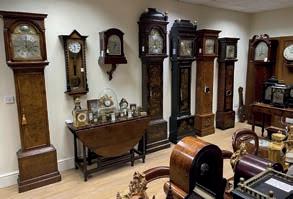
Jones & Llewelyn Unit B, Beechwood Trading Estate, Llandeilo, Carmarthenshire, SA19 7HR, 01558 823 430
www.jonesandllewelyn.com
General Sale, May 6, 20 Jun 3
Rogers Jones & Co
17 Llandough Trading Estate, Penarth, Cardiff,
CF11 8RR, 02920 708125
www.rogersjones.co.uk
Jewellery and Collectables, May 5
The Club House, May 12
Fine Art and Interiors, May 26

The Josef Herman Foundation Art Auction, Jun 2
Adam’s 26, Stephens Green, Dublin 2, D02 X665, Ireland 00 353 1 6760261
www.adams.ie
Mid-Century Modern, May 9
Fine Jewellery and Watches, May 16
Fine Vintage Wine and Spirits, May 25
Fonsie Mealy’s Chatsworth St, Castlecomer, Co. Kilkenny, Ireland 00 353 56 4441229
www.fonsiemealy.ie
Stillorgan Rd, Woodland A94 V6K5, Books, May 24
Whyte’s 38 Molesworth St. Dublin D02 KF80 Ireland 00 353 1 676 2888
www.whytes.ie
Important Irish Art, May 29

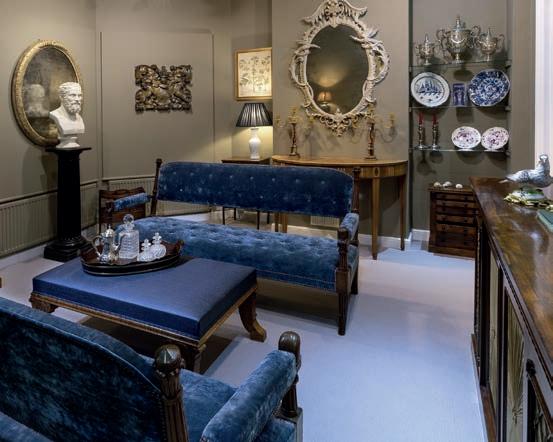
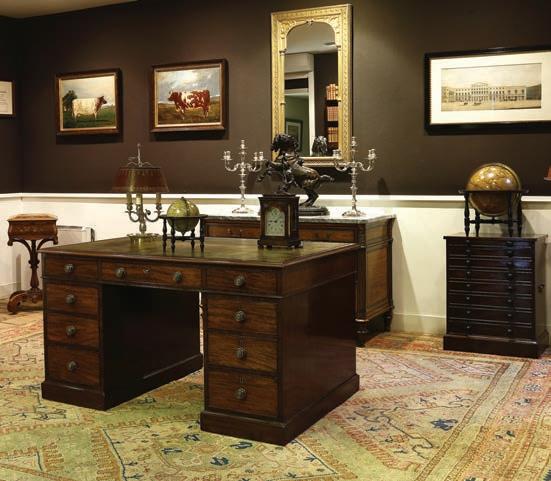

Labelled/ stamped branded furniture from Georgian to Victorian, eg Thomas Butler, Morgan & Sanders, J Alderman, Ross of Dublin (pictured), Gregory Kane, Wilkinson of Ludgate Hill, Robert James of Bristol, James Winter, W Priest, Samuel Pratt and many others. Tables all types, chairs, bookcases, , Davenport. mirrors etc. Campaign shower.
Georgian chamber horse exercise chair (pictured)
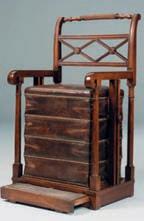
Signed and unusual furniture. Georgian, Regency, William IV. Sofa / Pembroke / side tables, library furniture / bookcases. Also Victorian campaign chests, armchairs etc.
Ross of Dublin, Morgan & Sanders, Williams & Gibton, James Winter, Hill & Millard and many others.
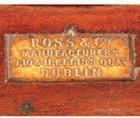
1 The Square, Church Street, Edenbridge, Kent TN8 5BD
01732 865 988 or 07836233473 cato@lennoxcato.com

www.lennoxcato.com
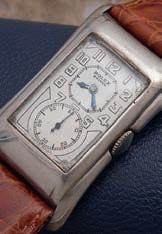

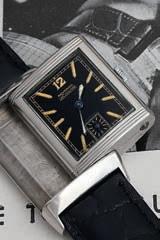
Omega Seamasters and pre-1980s Omegas in general.
IWC and Jaeger LeCoultres, all styles. Looking for Reversos. American market filled and 14k pieces possibly, at the right price.
Omega Seamasters and pre-1980s Omegas in general. IWC and Jaeger LeCoultres, all styles. Looking for Reversos. American market filled and 14k pieces possibly, at the right price.
Breitling Top Times, Datoras and 806 Navitimers.
Pre-1960s Rolex models, with a focus in pre-war tanks, tonneaus etc. Gold or silver/steel. Also World War I Rolex 13 lignes etc. Princes.

Breitling Top Times, Datoras and 806 Navitimers. Pre-1960s Rolex models, with a focus in pre-war tanks, tonneaus etc. Gold or silver/steel. Also World War I Rolex 13 lignes etc. Princes.

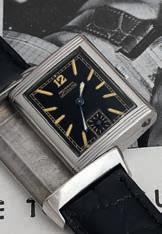
Longines, Tudors and Zeniths, pre-1970. Even basic steel models in nice condition. All the quirky oddities like Harwoods, Autorists, Wig Wag, Rolls etc, and World War I hunter and semi-hunter wristwatches.
Longines, Tudors and Zeniths, pre-1970. Even basic steel models in nice condition. All the quirky oddities like Harwoods, Autorists, Wig Wag, Rolls etc, and World War I hunter and semi-hunter wristwatches.
Early, pre-war ladies’ watches also wanted by Rolex, Jaeger LeCoultre etc. Prefer 1920s/30s deco styles, but early doughnuts also considered.
Early, pre-war ladies’ watches also wanted by Rolex, Jaeger LeCoultre etc. Prefer 1920s/30s deco styles, but early doughnuts also considered.
Yorkshire based, but often in London and can easily collect nationwide.
Yorkshire based, but often in London and can easily collect nationwide.
vintagejewellery@yahoo.co.uk or tel 07958 333442
333442
J Alderman. Daws and George Minter reclining chairs. Shoolbred/ Hamptons / Cornelius Smith Victorian armchairs.
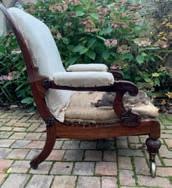
Unusual Georgian to William IV architectural features eg doors, door frames, over door pediments. 18th century staircase spindles and handrail needed. Anything Georgian or Regency with lots of character considered.
Marble fire surrounds. Georgian / Regency/ William IV. Bullseyes etc. Exceptional Georgian / Regency fire grates
Rectangular Georgian fanlight.
Sash windows x 4 identical. Georgian reclaimed. Approx 58” high x 36” wide. Wide reclaimed floorboards. Approx 100 m2.
Four identical reclaimed Georgian wooden sash windows with boxes, approx 60 high x 37 wide.
Early decorative oil / gas / electric light fittings. Ceiling, wall or table. Early gasoliers. Colza lamps. Gimble lamp.
Roland Ward, Van Ingen taxidermy. Human skull. Hippopotamus skull. Stuffed crocodile / alligator.
Marble fire surrounds from 1750 to 1850ish. White or coloured. Bullseyes, William IV styles etc. Brass Regency reeded fire insert and Victorian griffin grate (pictured)
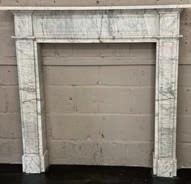
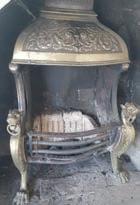
Quirky architectural features. Regency columns, corbels, marble and stone pieces, over door pediments, folding/rolling multi part Georgian room dividing doors.
Victorian canopy shower bath. Decorated toilets etc Unitas, Simplicitas, Deluge etc. Decorated basins x 3.
Human skull, stuffed crocodile/ alligator. Grand tour souvenirs.

expert Marc Allum felt quite at home on a recent lecture tour to New Zealand, but the real highlights came from the Maori collections of the National Museum


In the last four weeks I’ve taken 11 ights, spent 15 hours on trains, caught the odd bus and made countless car journeys. In the process I’ve covered approximately 25,000 miles. Why? Well, I was lucky enough to be invited to do a lecture tour of New Zealand after its cancellation in 2020.
I’d never been to New Zealand before and wasn’t quite sure what to expect. Aside from the epic countryside (the reason I opted for so many legs on a train) I was interested to see how my love of all things old would translate into what many people refer to as a “young” country.
What I immediately found on arrival was the way people started conversations by apologising for things being “not very old”. So it was with some trepidation (and jet-lag after a 30-hour trip and 13-hour time di erence) that I set o on my rst day to hunt down an antiques centre in Napier, a city on the North Island.
I have to admit I was a pleasantly surprised to nd so many display cases housing a great number of interesting things and I left with a Regency momento mori, an 1887 enamelled half US dollar brooch and a 19th-century mille ori paperweight. Had I been more alert, I might have bought more.
e lovely hair-picture momento was not exactly what I had expected to nd, but after my rst “object” talk the following day, I soon realised the enormously strong sense of connection many New Zealanders feel to the UK.
In fact the objects confronting me were little di erent from the arrivals on my table on any Antiques Roadshow.
e degrees of separation you experience anywhere in the world are whittled down to just one or two in New Zealand because of the strong ancestral family ties to the UK and other European countries. So 17th-century family bibles, Victorian diamond brooches and Moorcroft pottery were not uncommon. A wonderful Fabergé case turned up too.
One very large di erence, however, was the extent of the health and safety measures in place in the aftermath of the terrible cyclone in the Hawke’s Bay area in February that devastated the North Island and killed 11 people.
I almost got used to the “in case of re” pre-lecture safety brie ng becoming “in case of earthquake”. Quite sobering really. I also visited a house in which I leant over to pluck a pot from a shelf and found it was xed down with earthquake wax.

But for me, one of the main highlights came as a result of lecturing at the National Museum (Te Papa) in Wellington. e following morning I was invited to delve behind the scenes at the Maori collections with curator Issac Te Awa. Such privileged access to so superlative and precious treasures including kakahu (cloaks), toangapaoro (musical instruments) and Poutokomanawa (ancestral gures), each imbued with generational layers of meaning and myth, was the cultural icing on the cake. From 17th-century bibles to Maori treasures, New Zealand has much to o er, even if some of the former is “not very old”.
Marc Allum is an author, lecturer and specialist on the BBC’s Antiques Roadshow, for more details go to www.marcallum.co.uk

was a little surprised to find so many display cases housing lots of interesting things and I left with a Regency momento mori, an 1887 enamelled half dollar brooch and a 19th-century millefiori paperweight. Had I been more alert, I might have bought more’
‘I
went behind the scenes of the Maori collections with curator Issac Te Awa, image public domain
Right
have to admit IAbove Inside the National Museum (Te Papa) in Wellington, image Shutterstock Marc







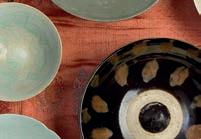

































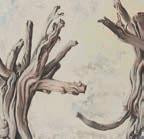





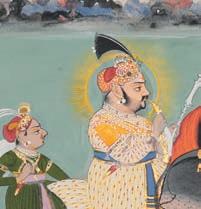
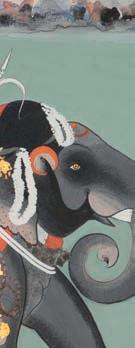

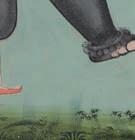











Stowmarketsaleroom:19CharlesIndustrialEstate,Stowmarket,Suffolk,IP145AH enquiries@bm-auctions.co.uk01449673088
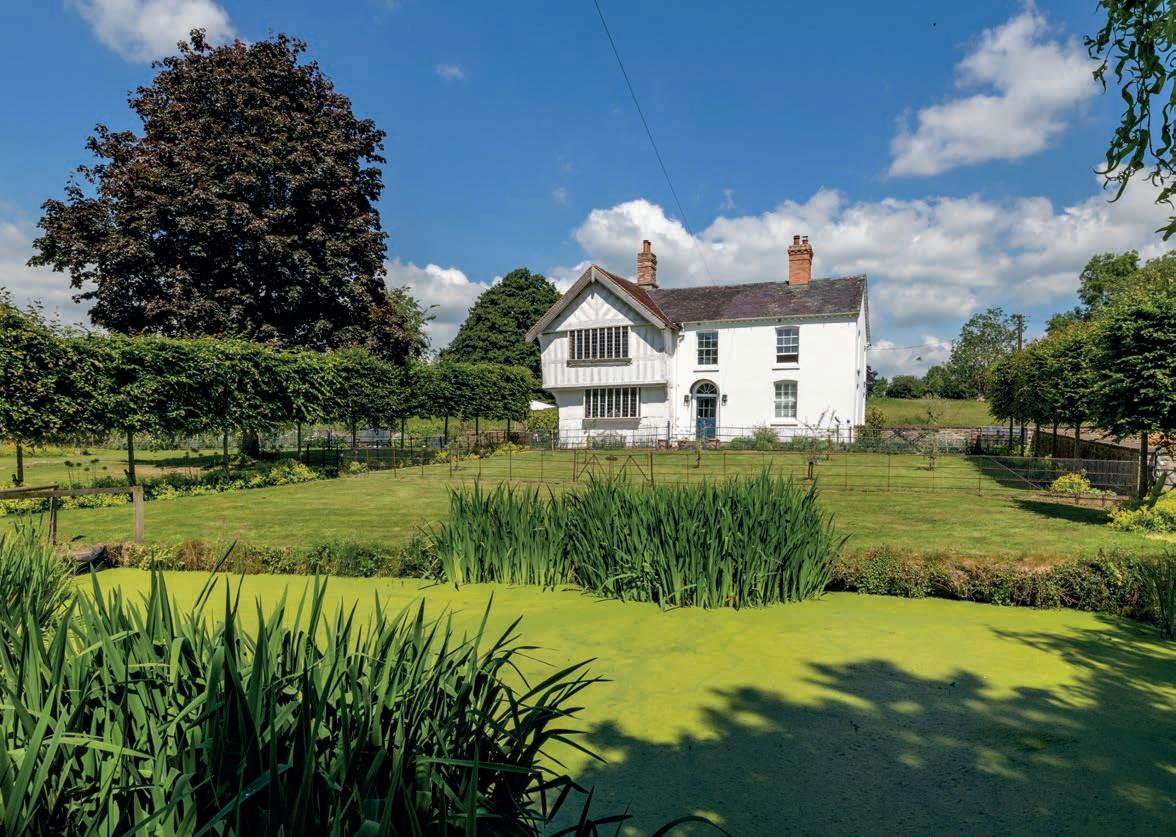
GlandfordAuctionGallery:12ManorFarm,Glandford,nrHolt,Norfolk,NR257JP norfolk.enquiries@bm-auctions.co.uk01263687342